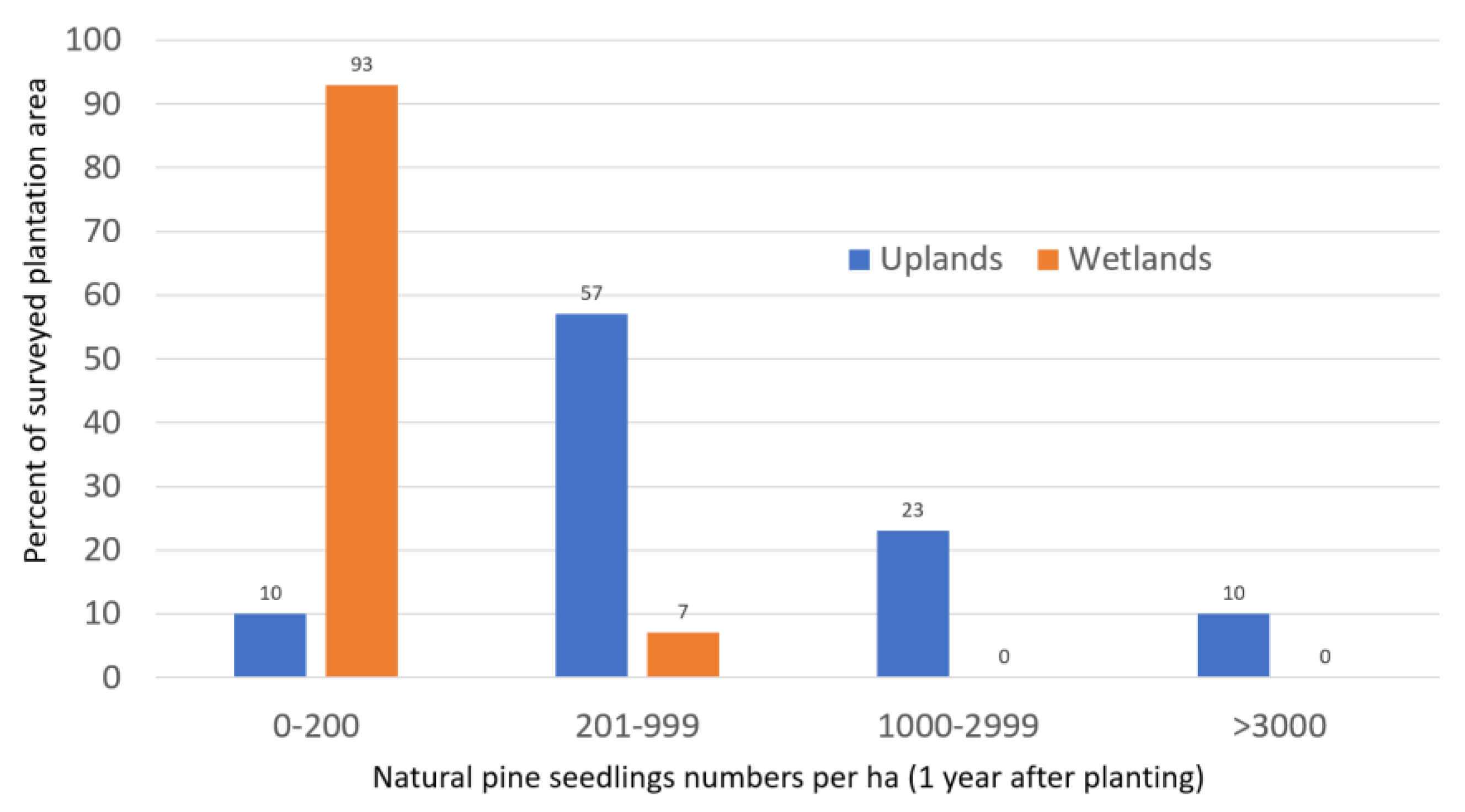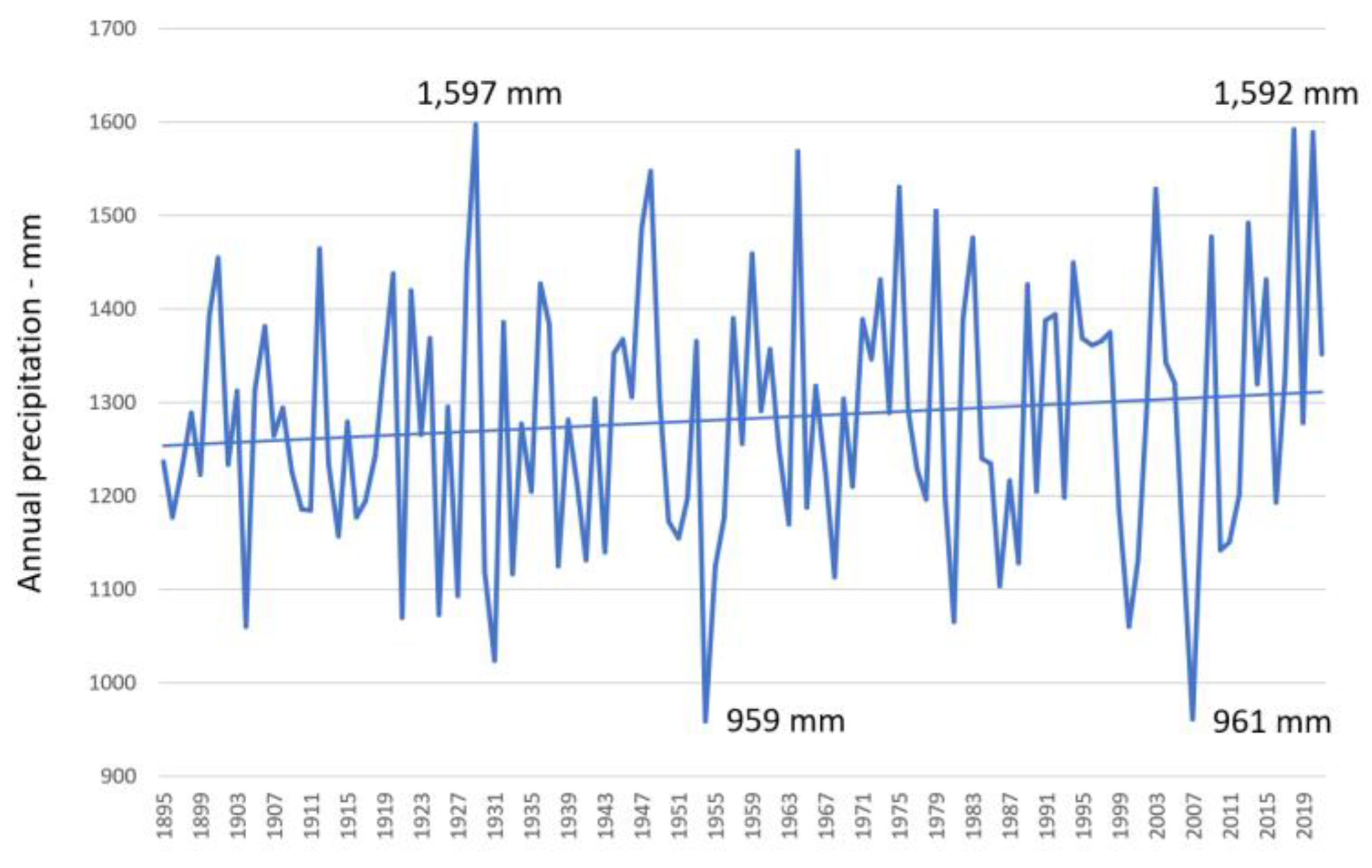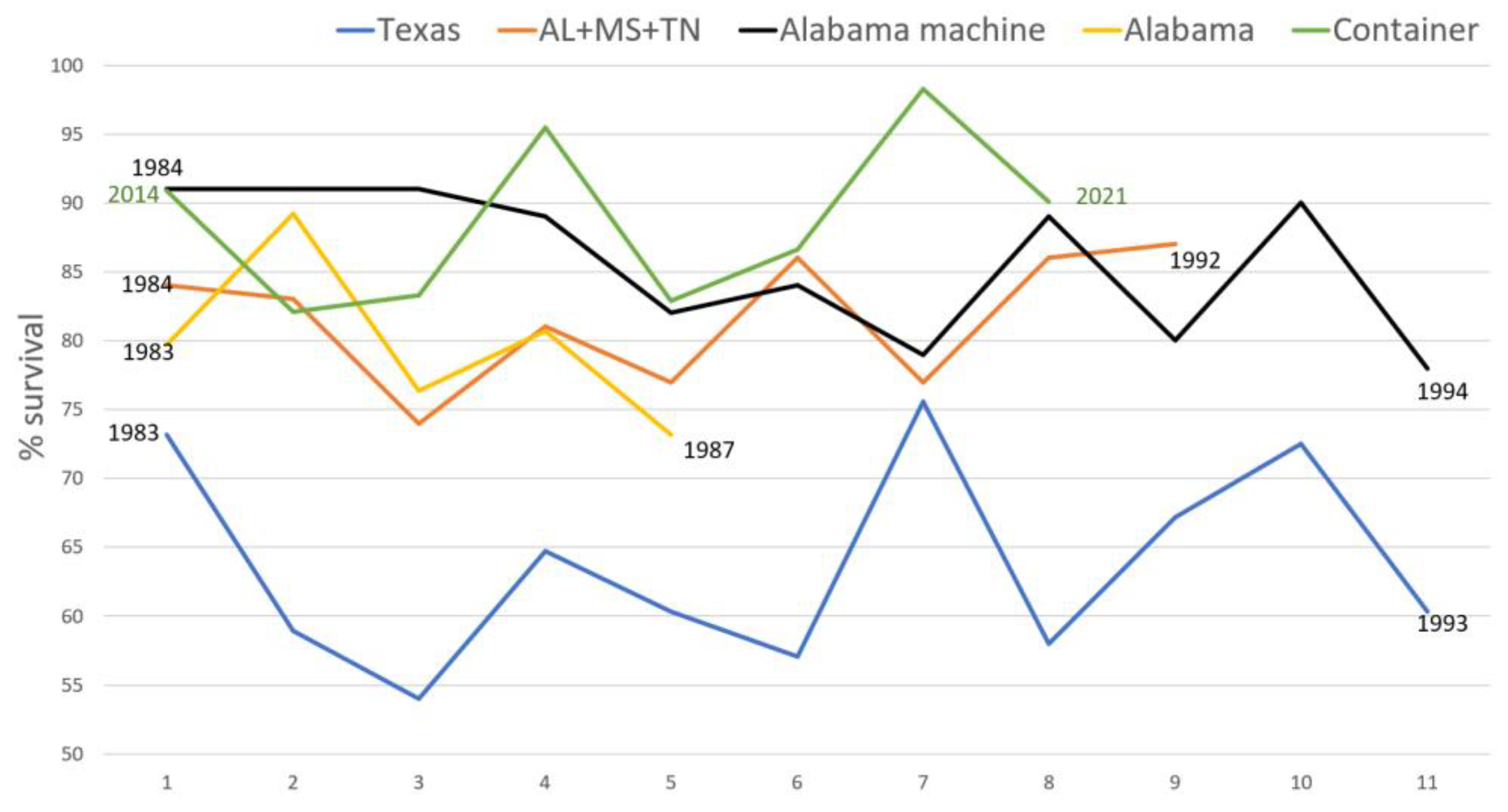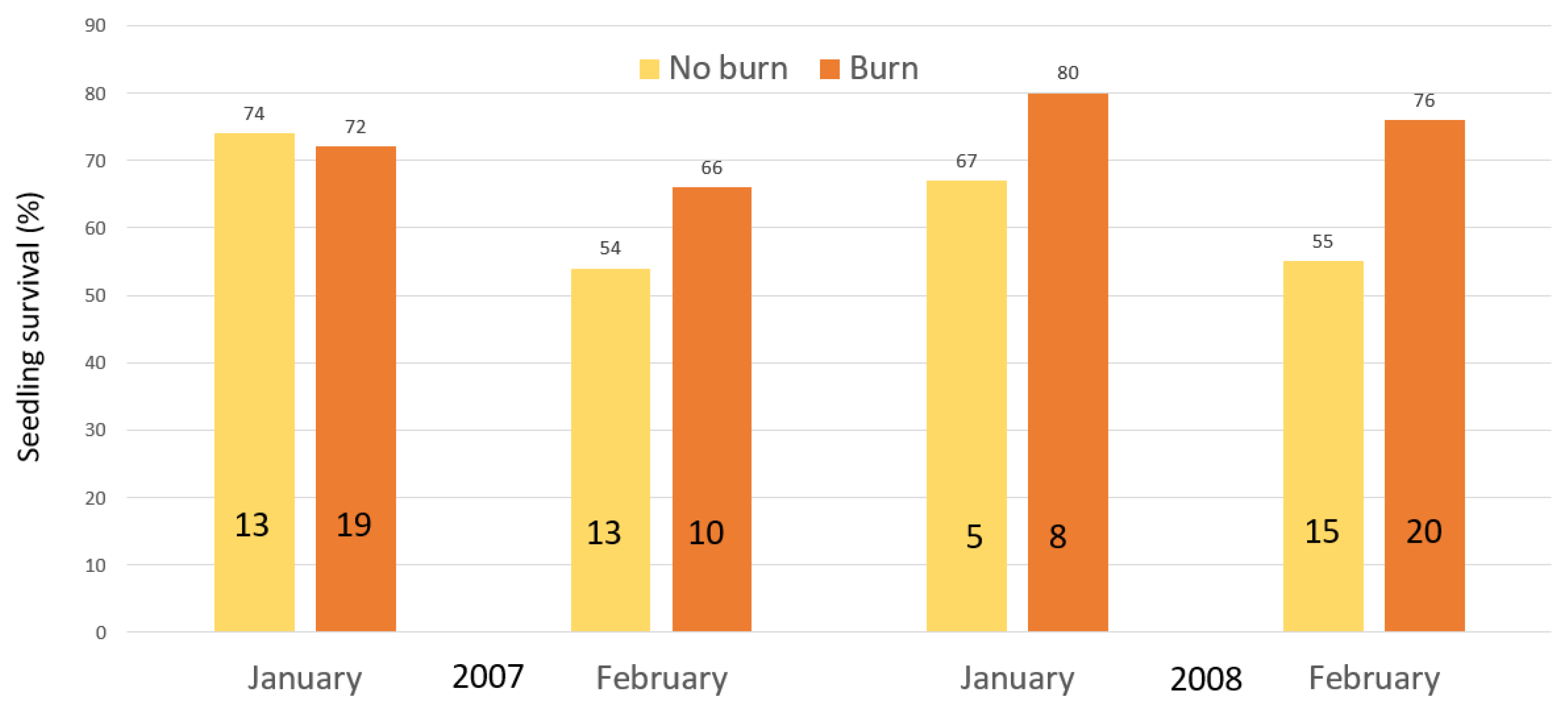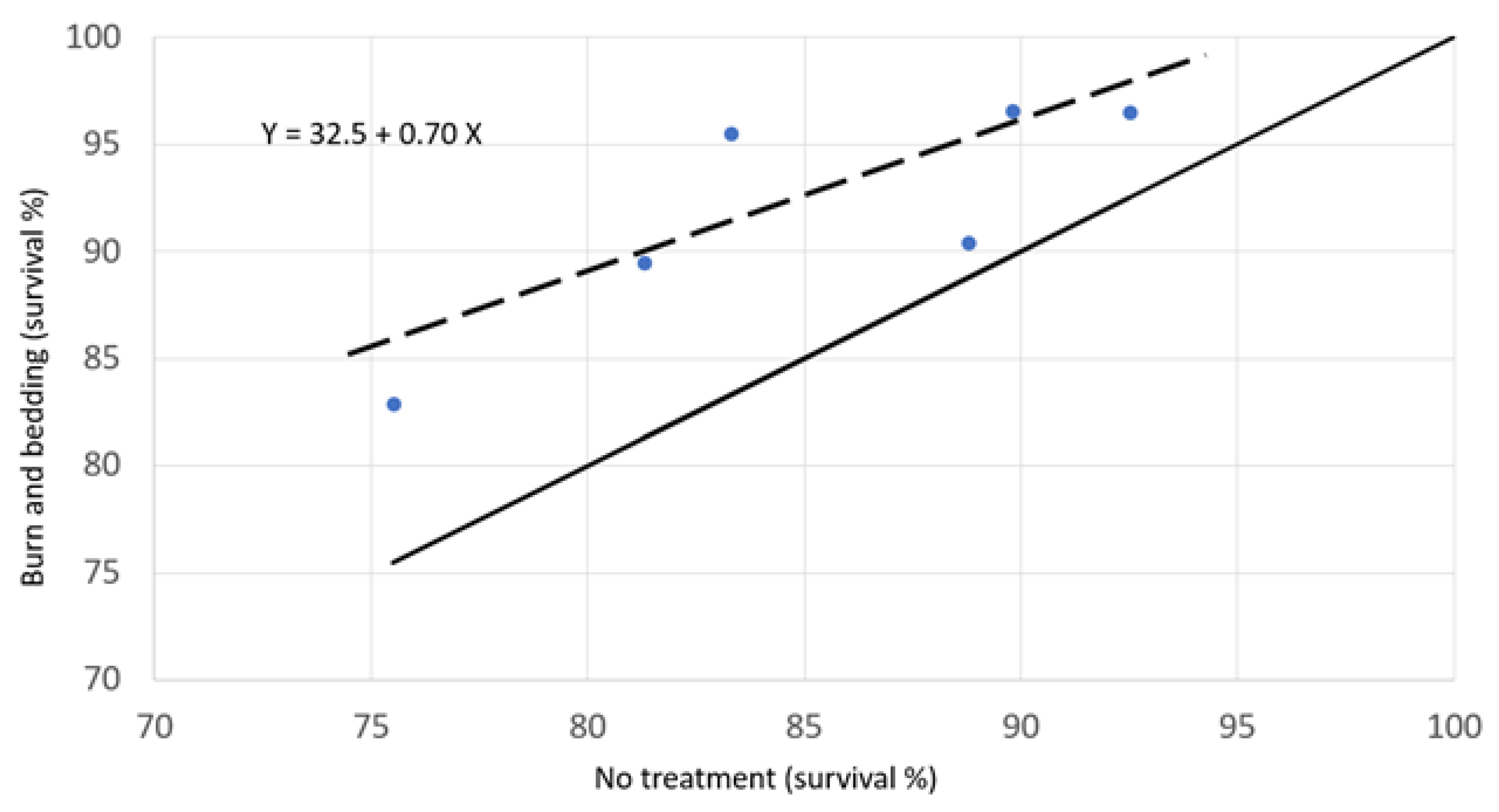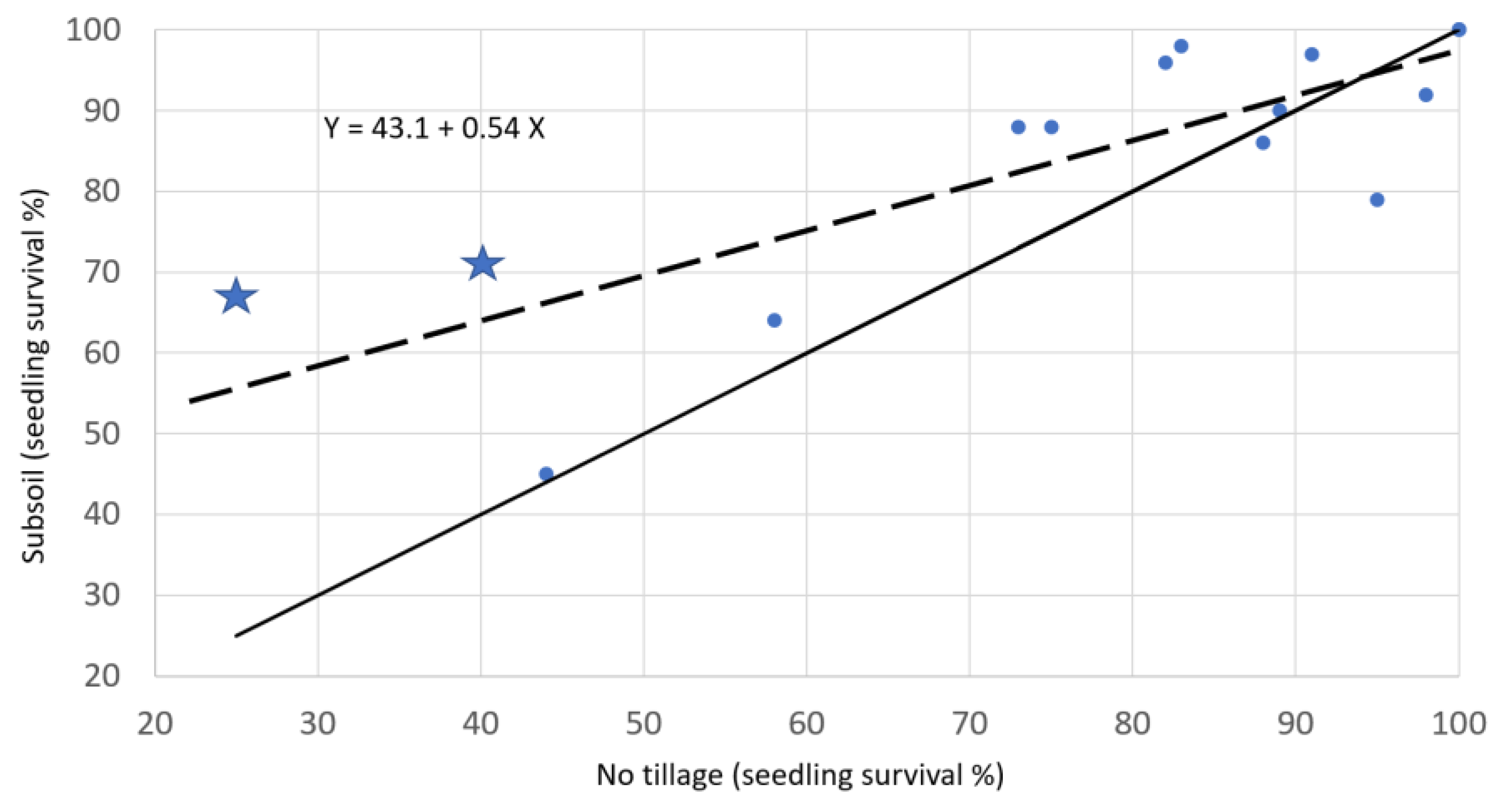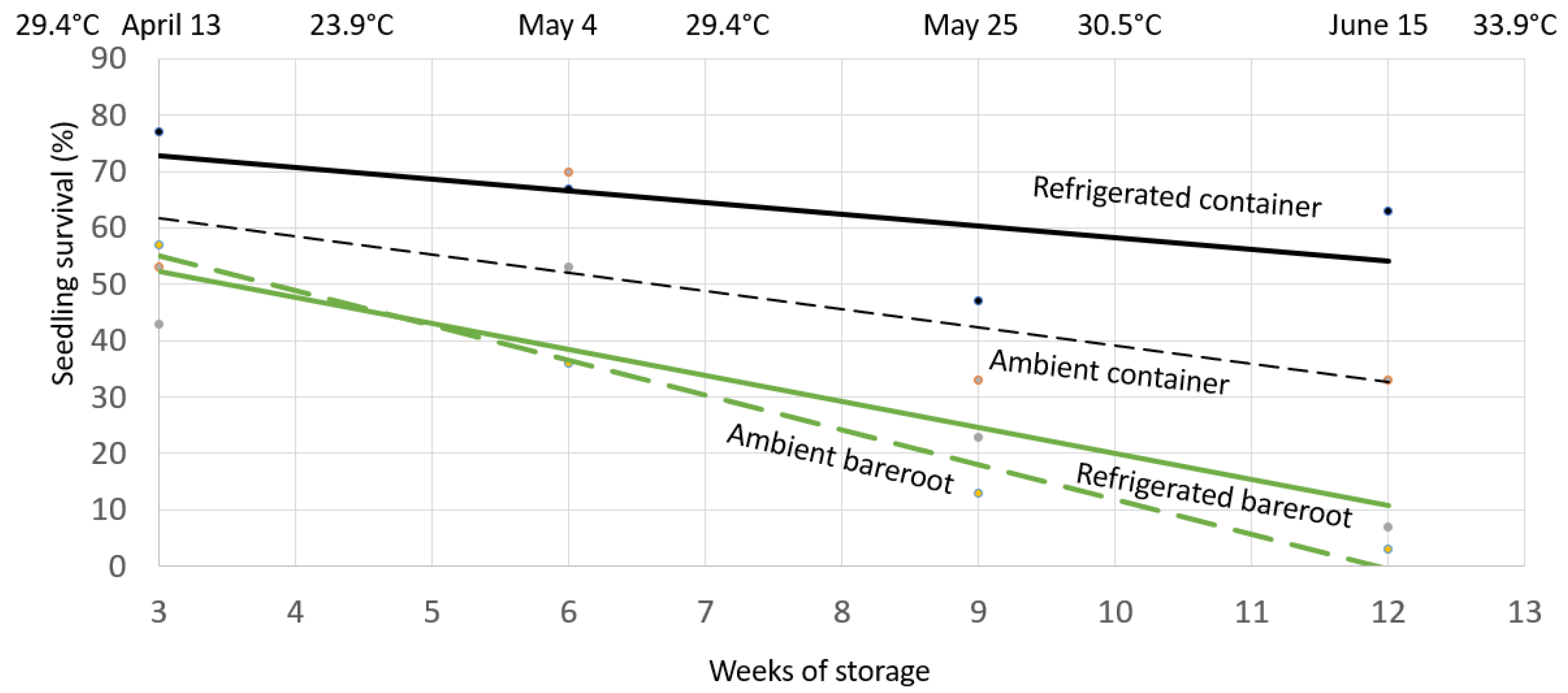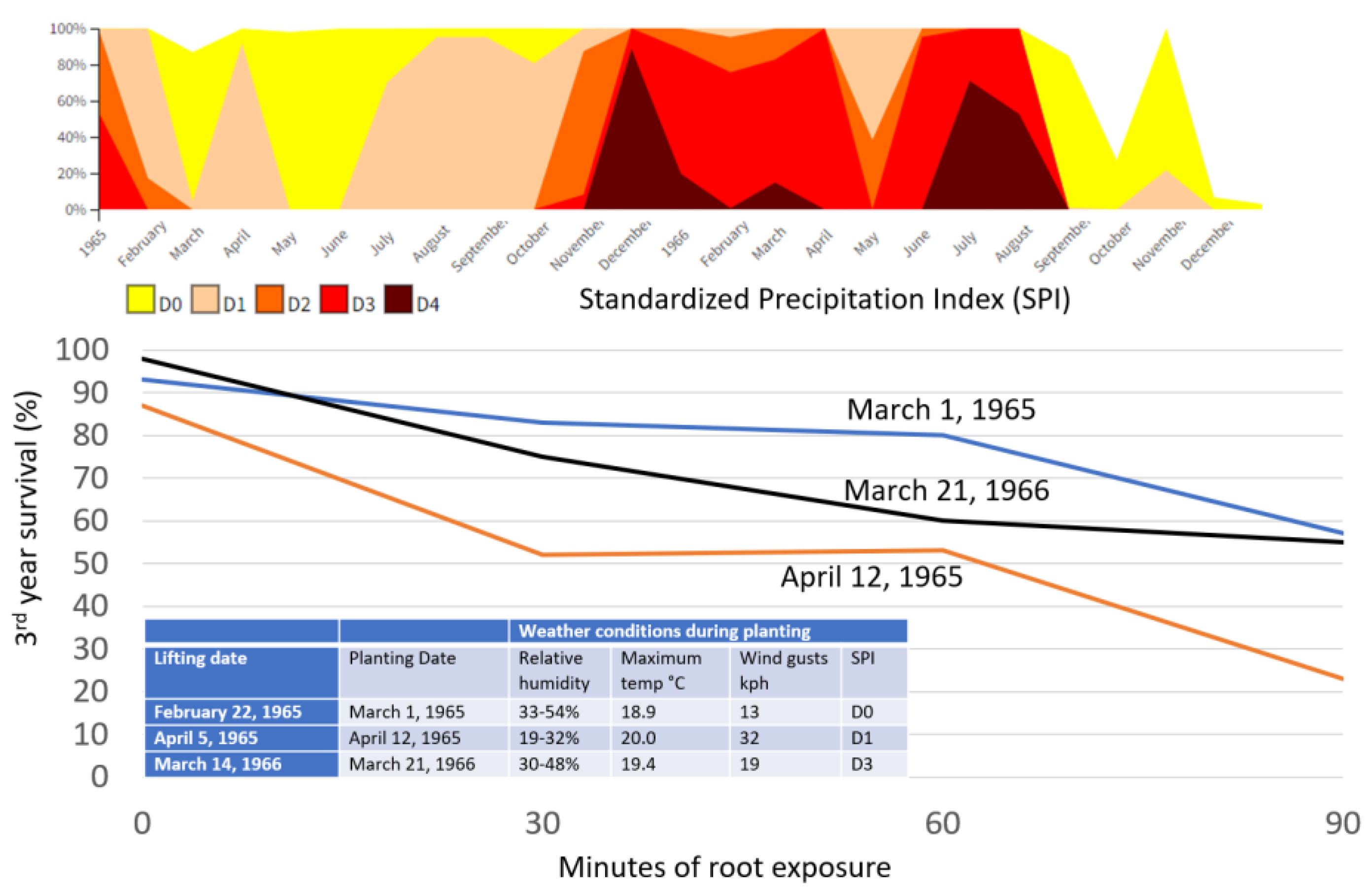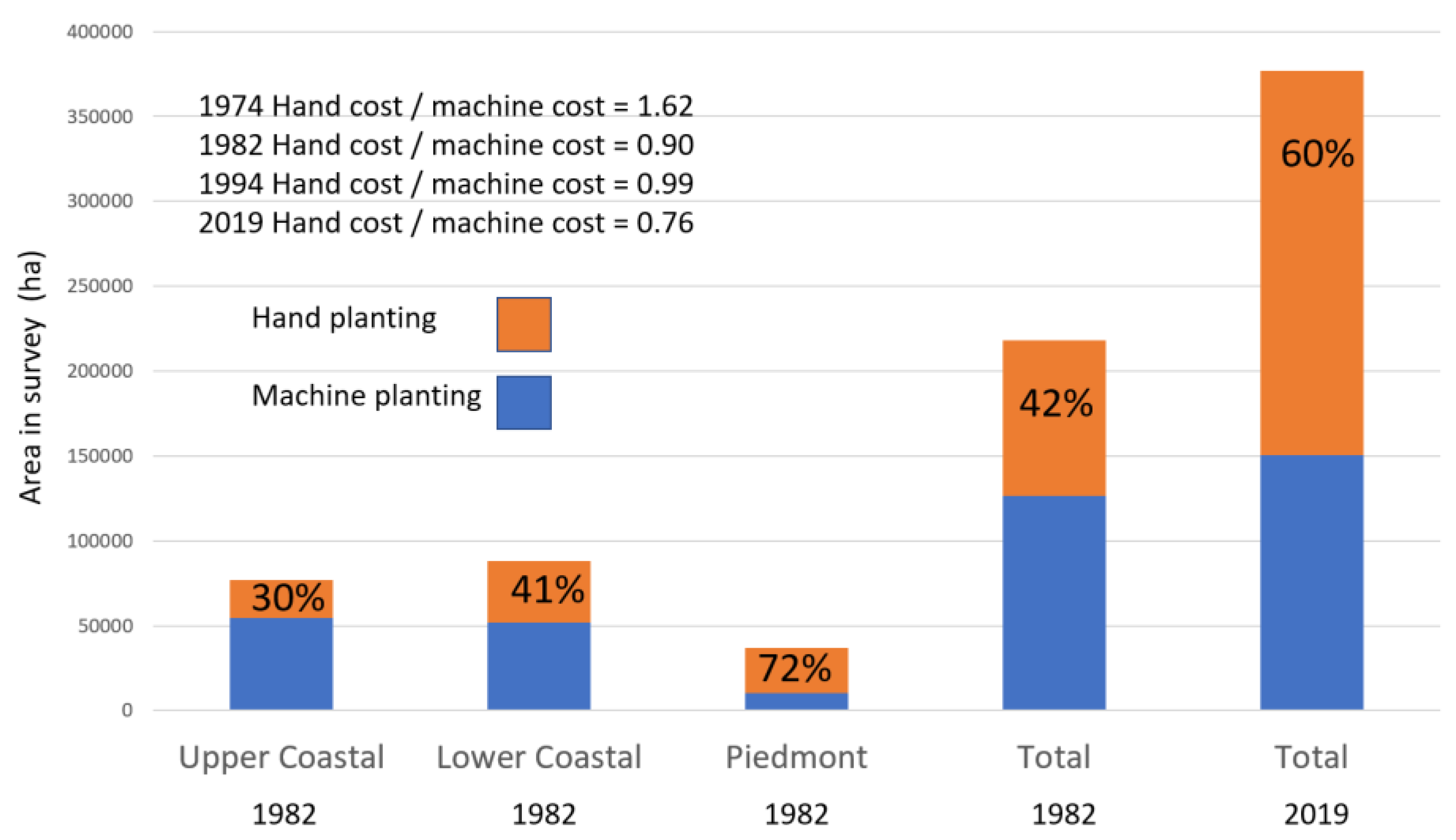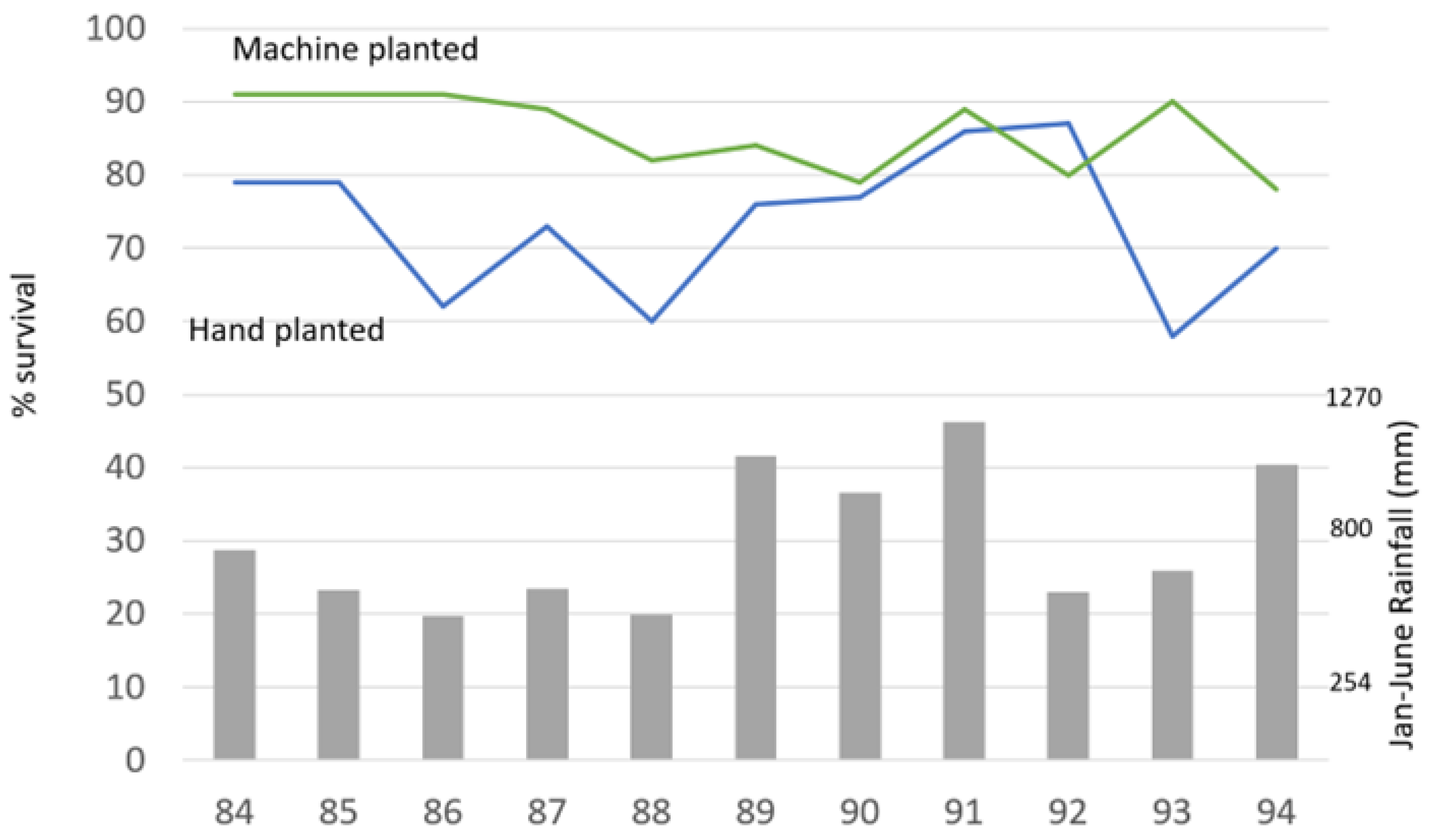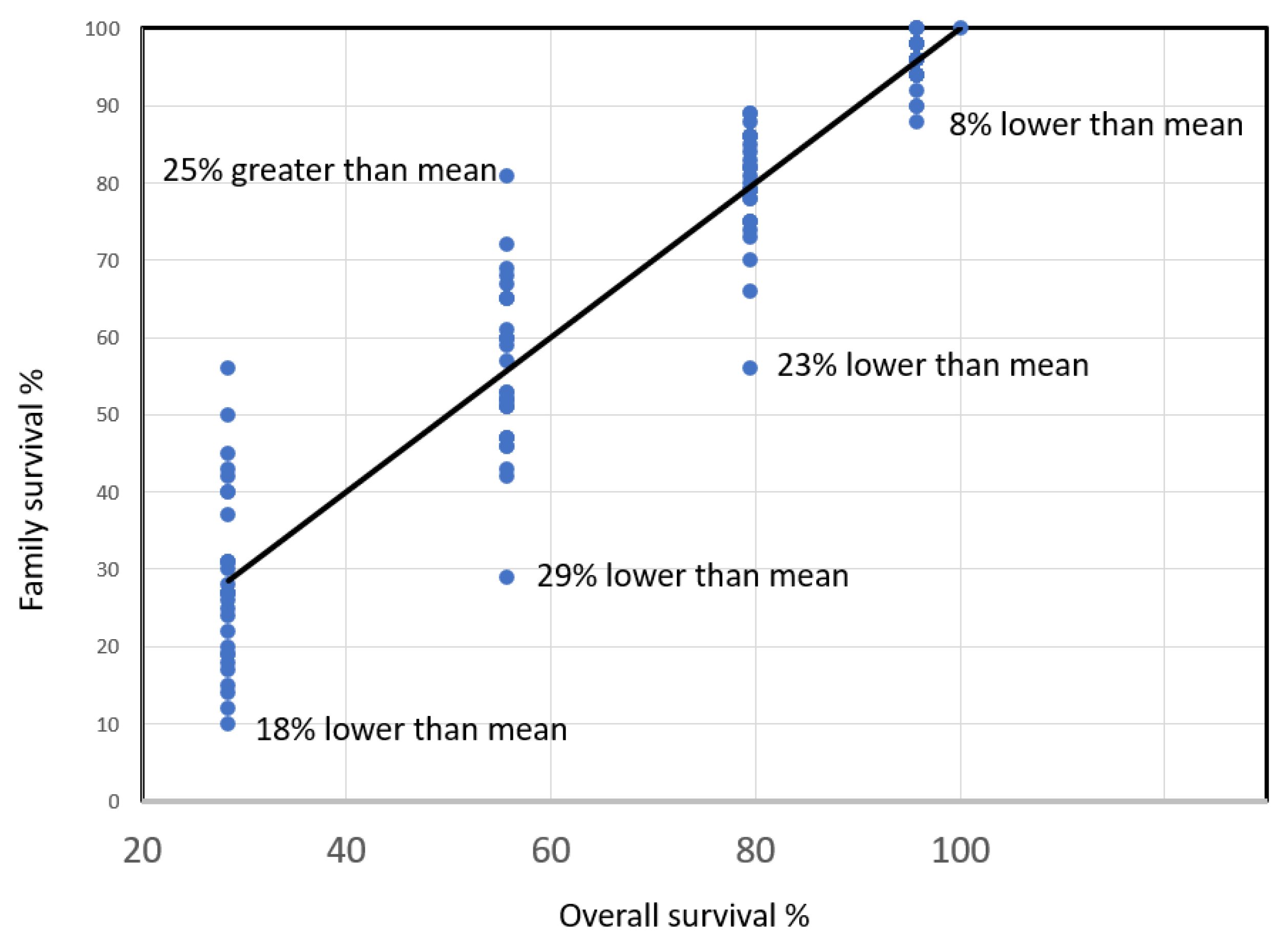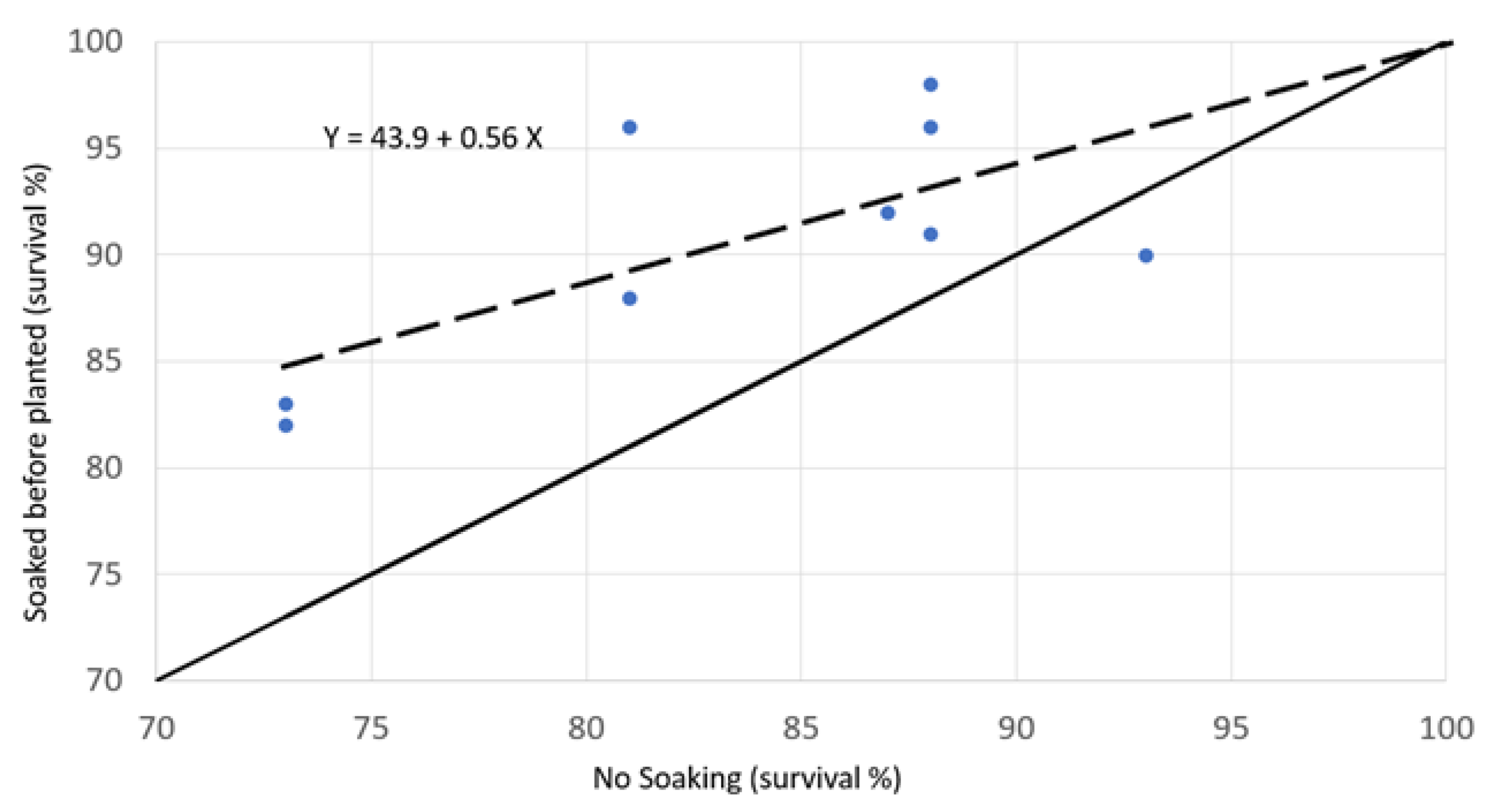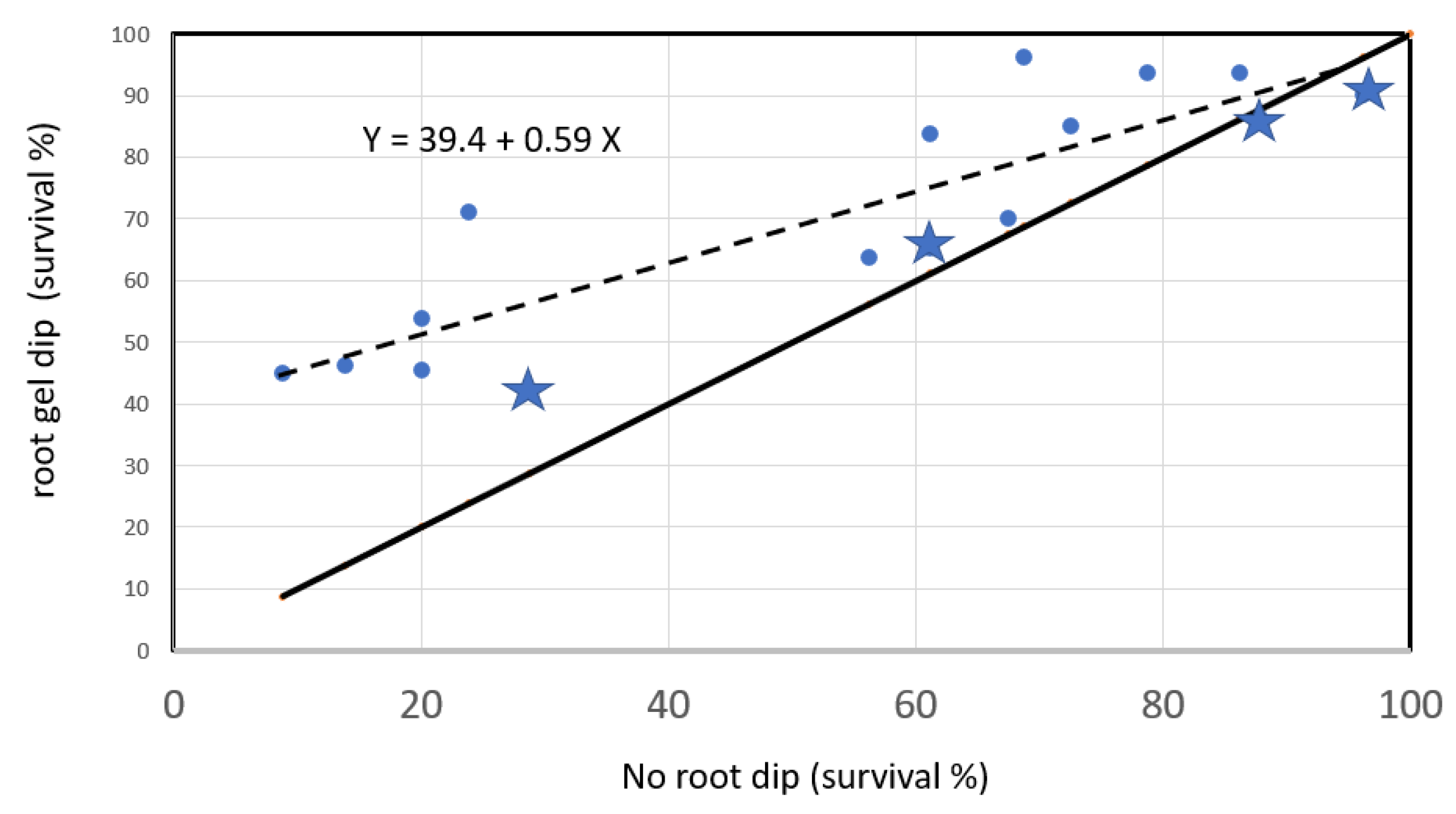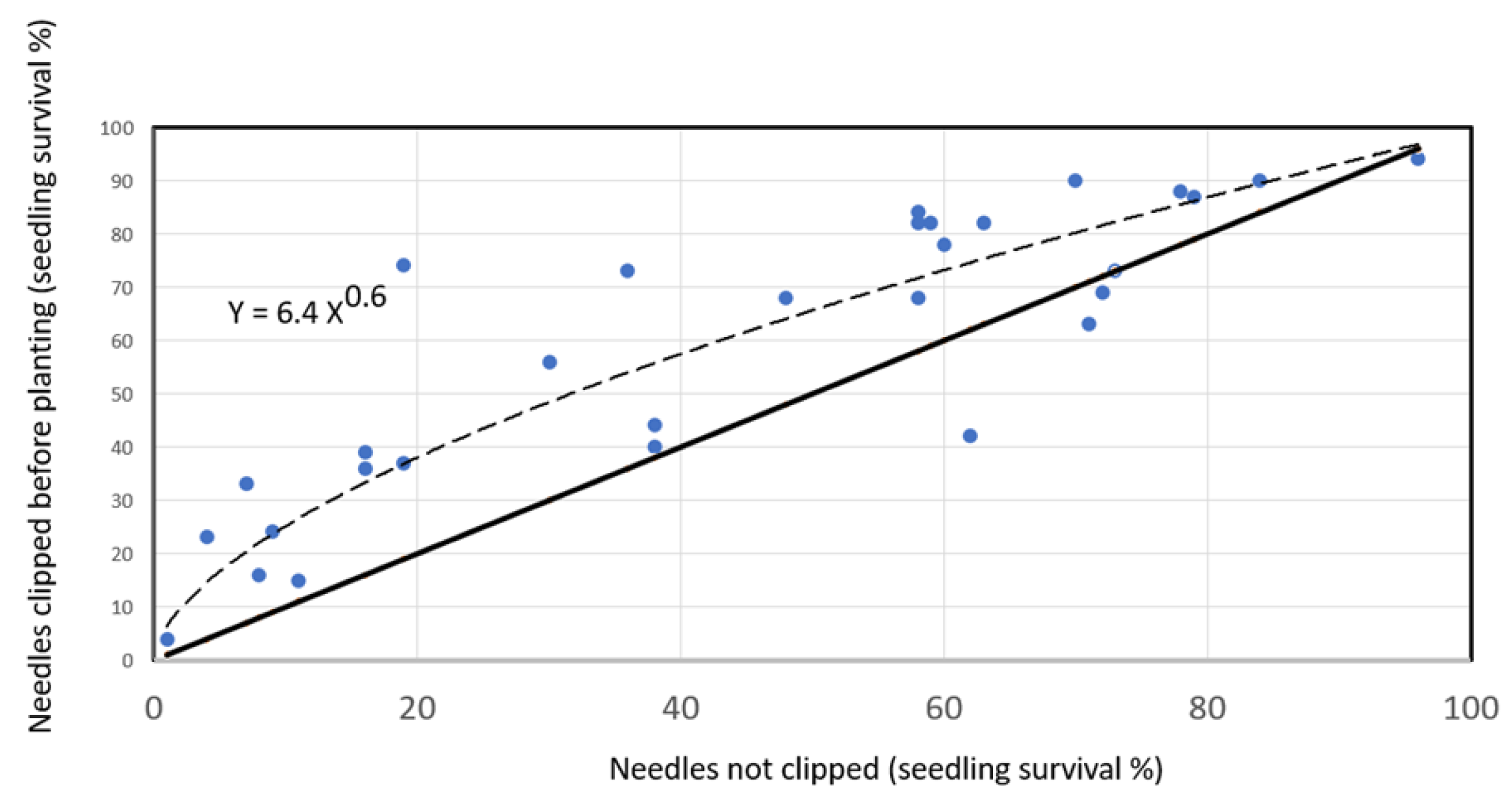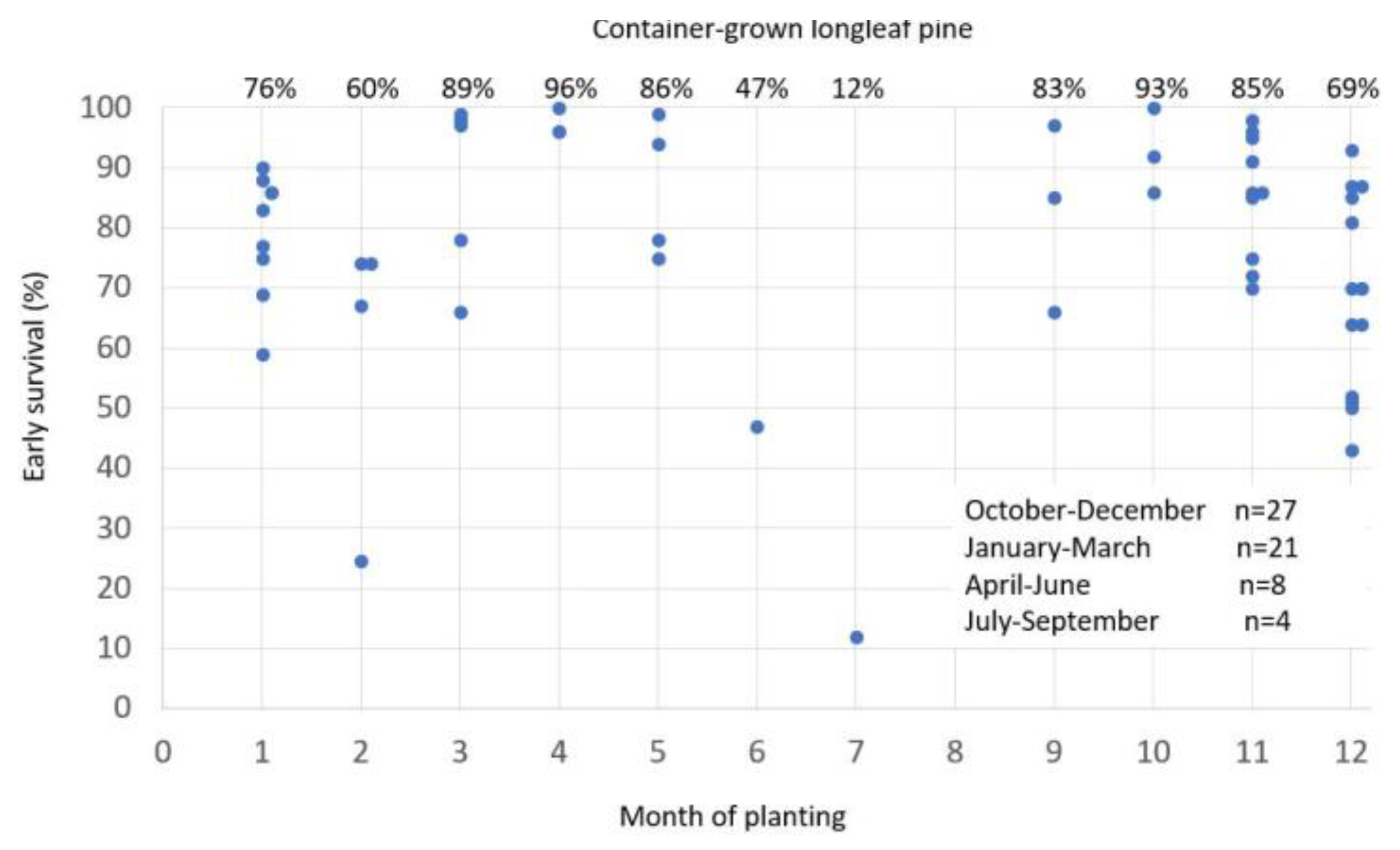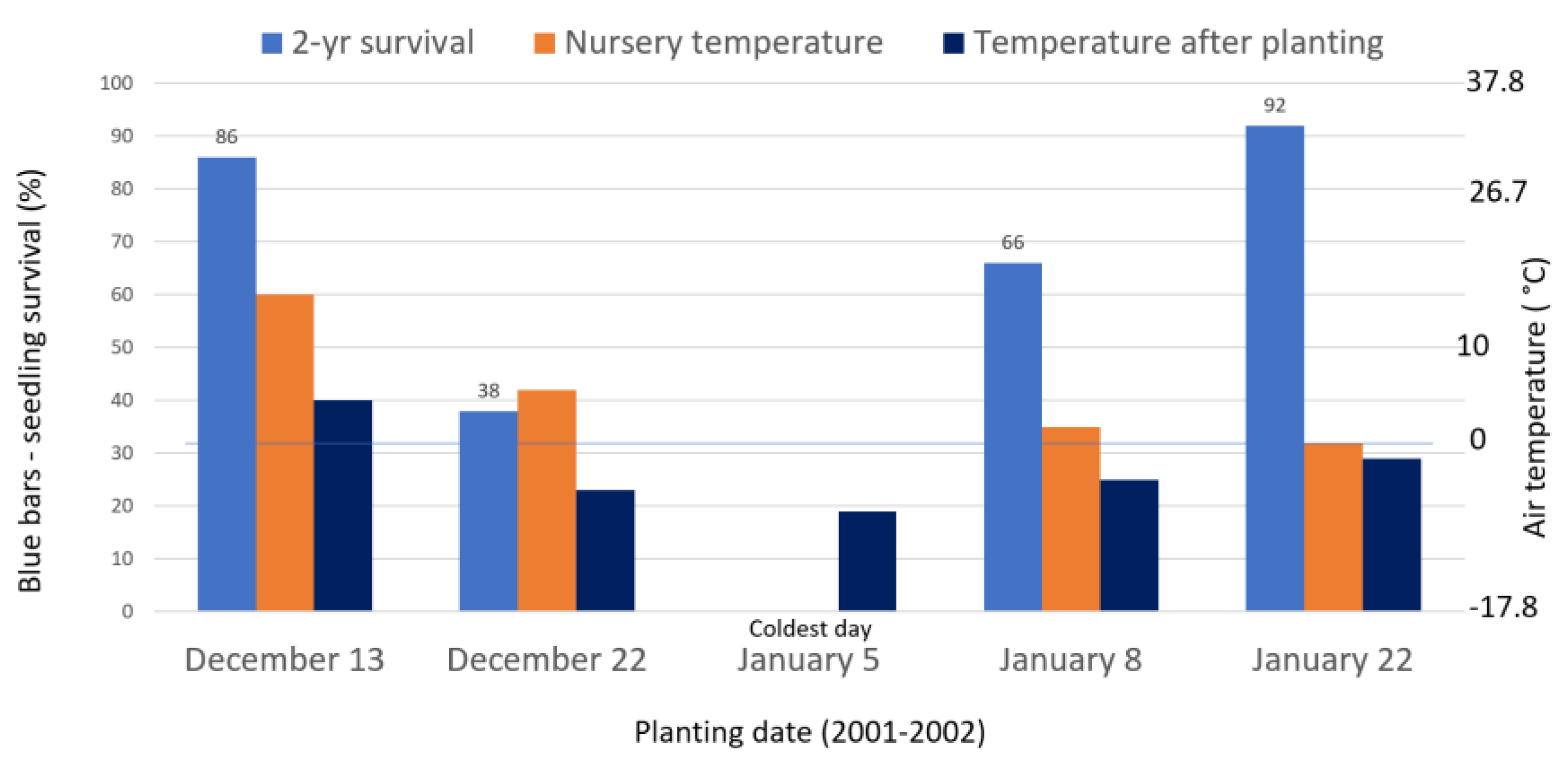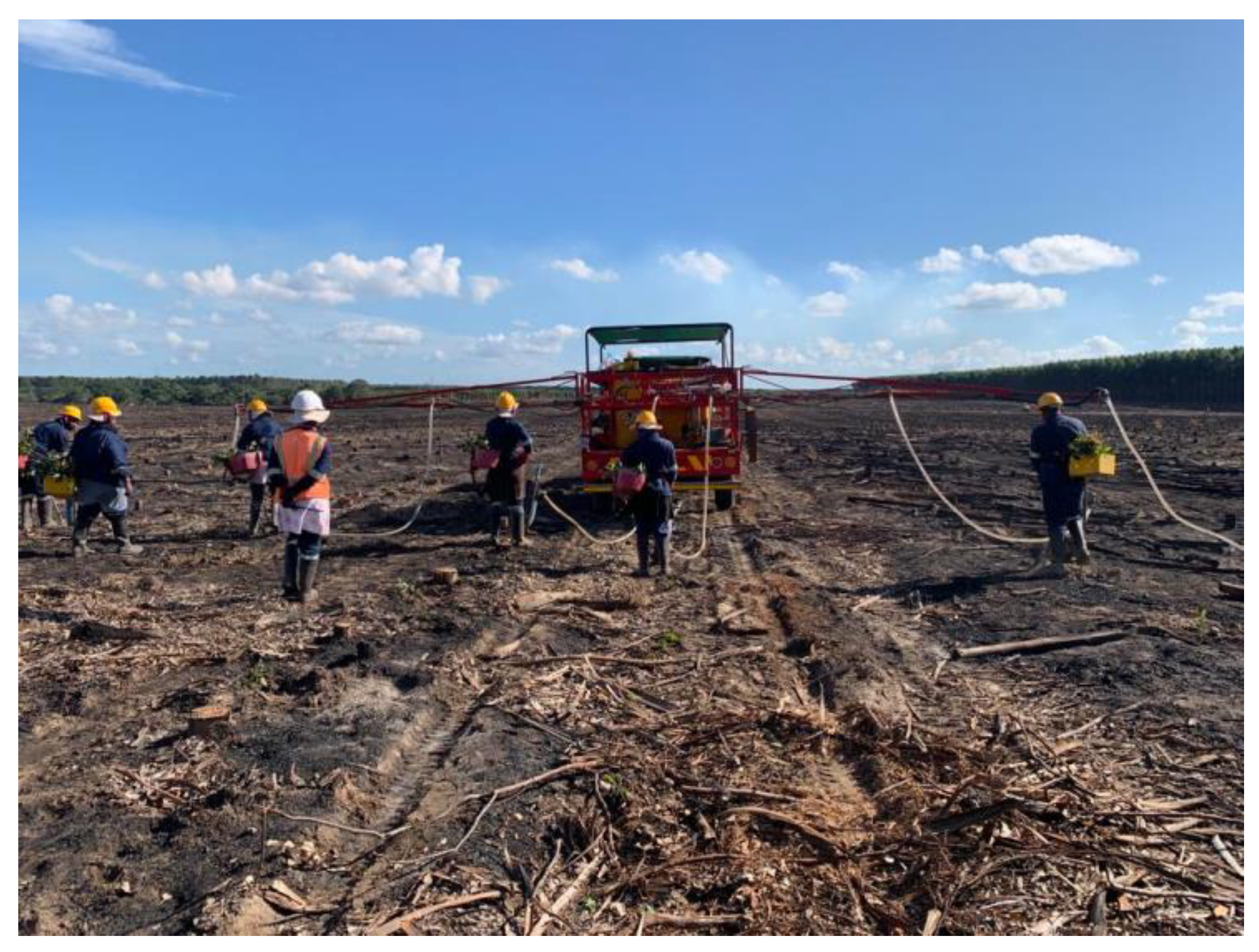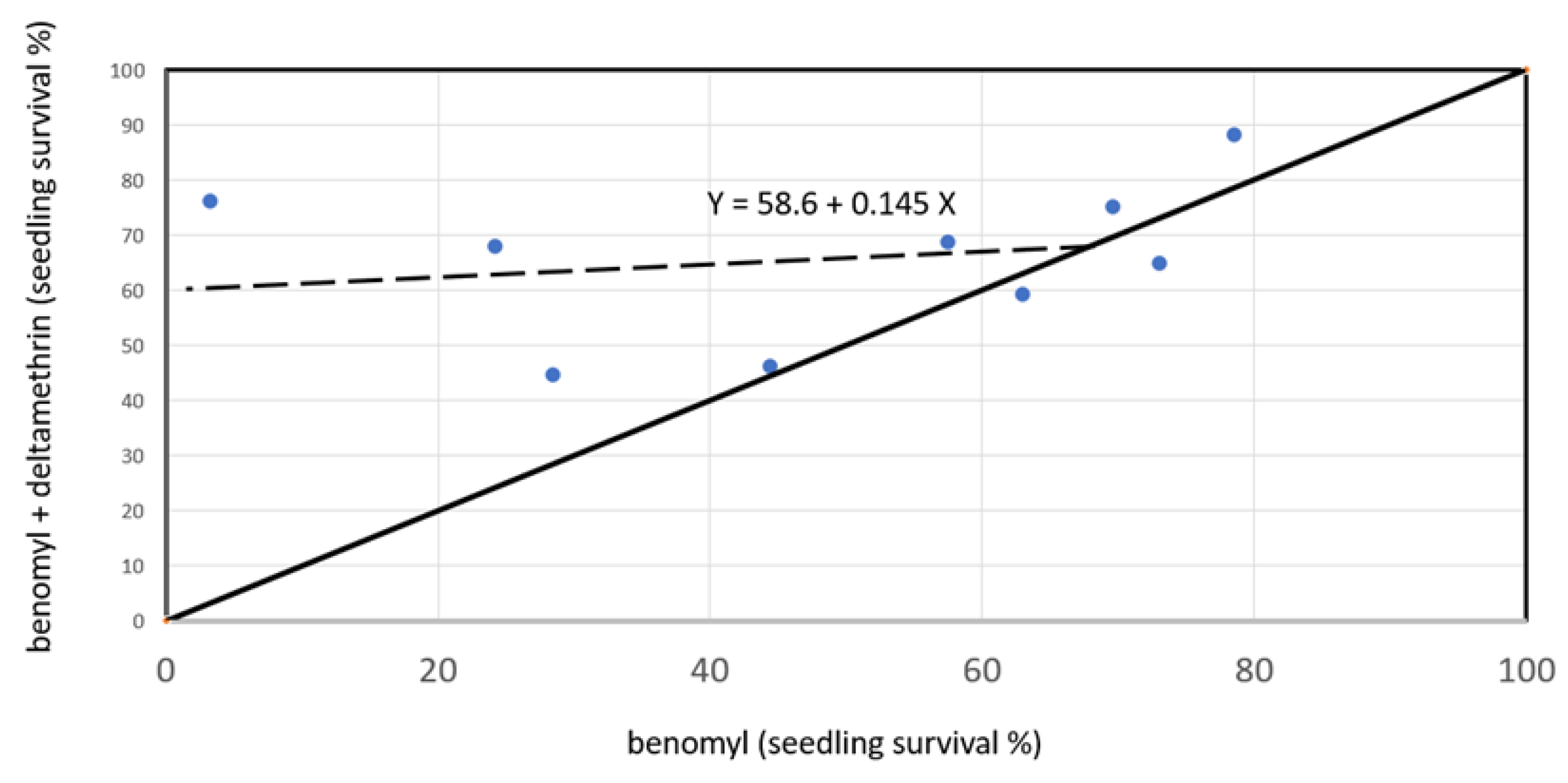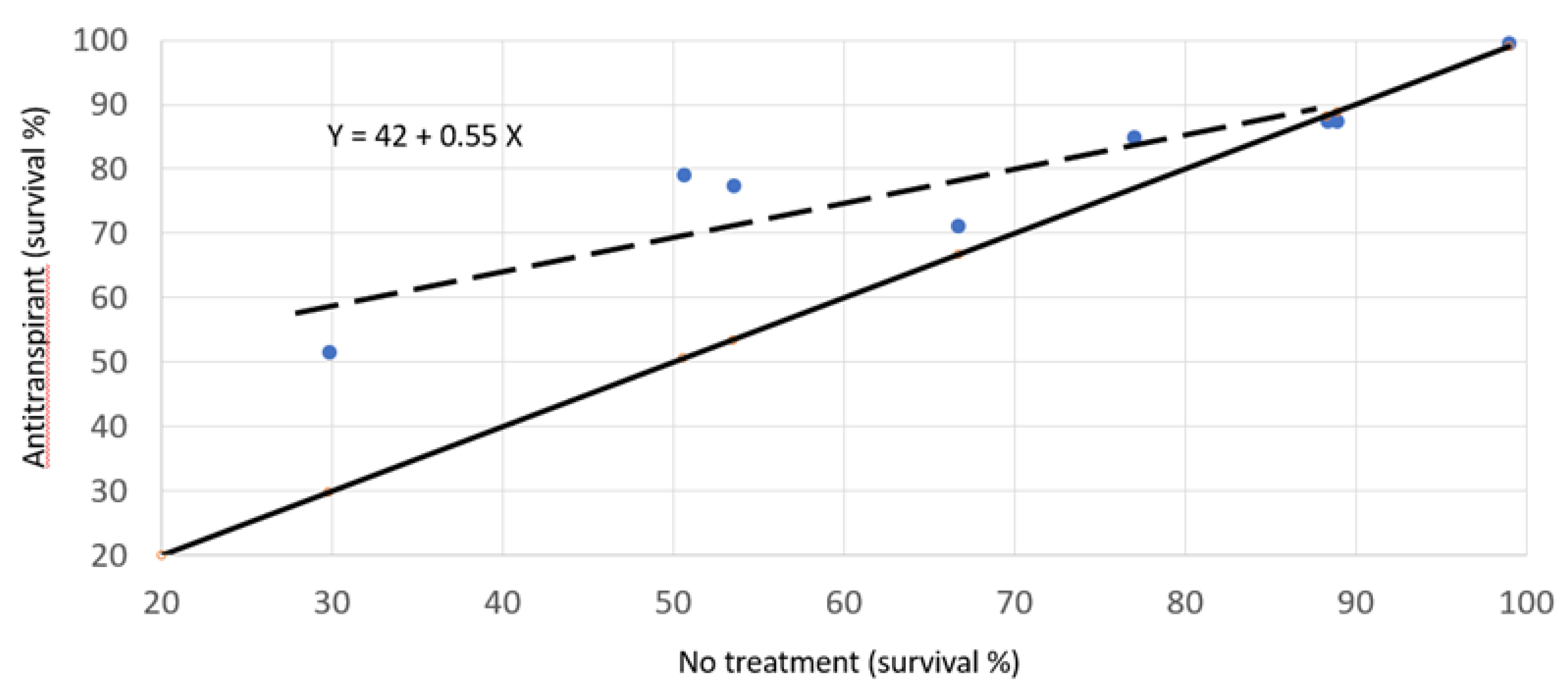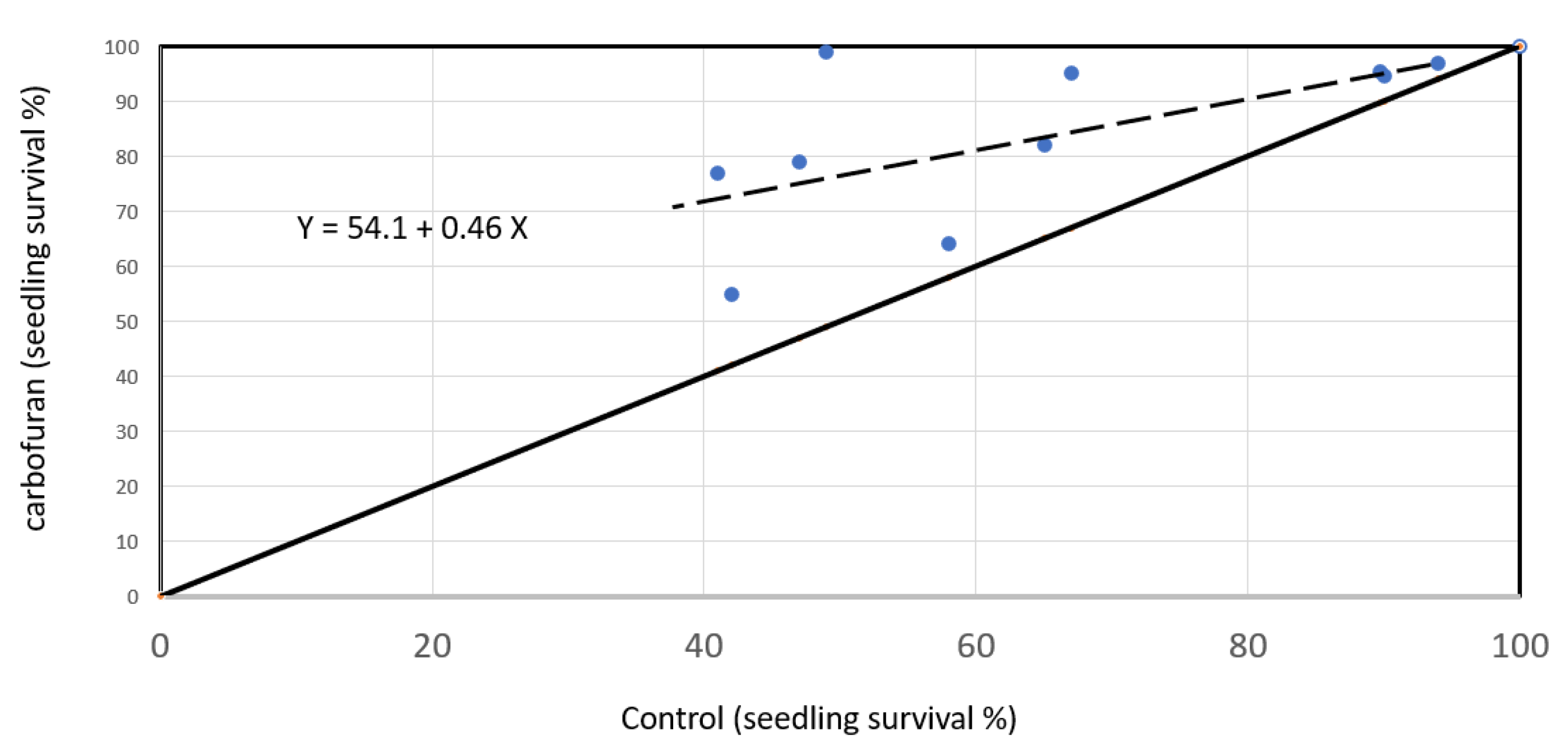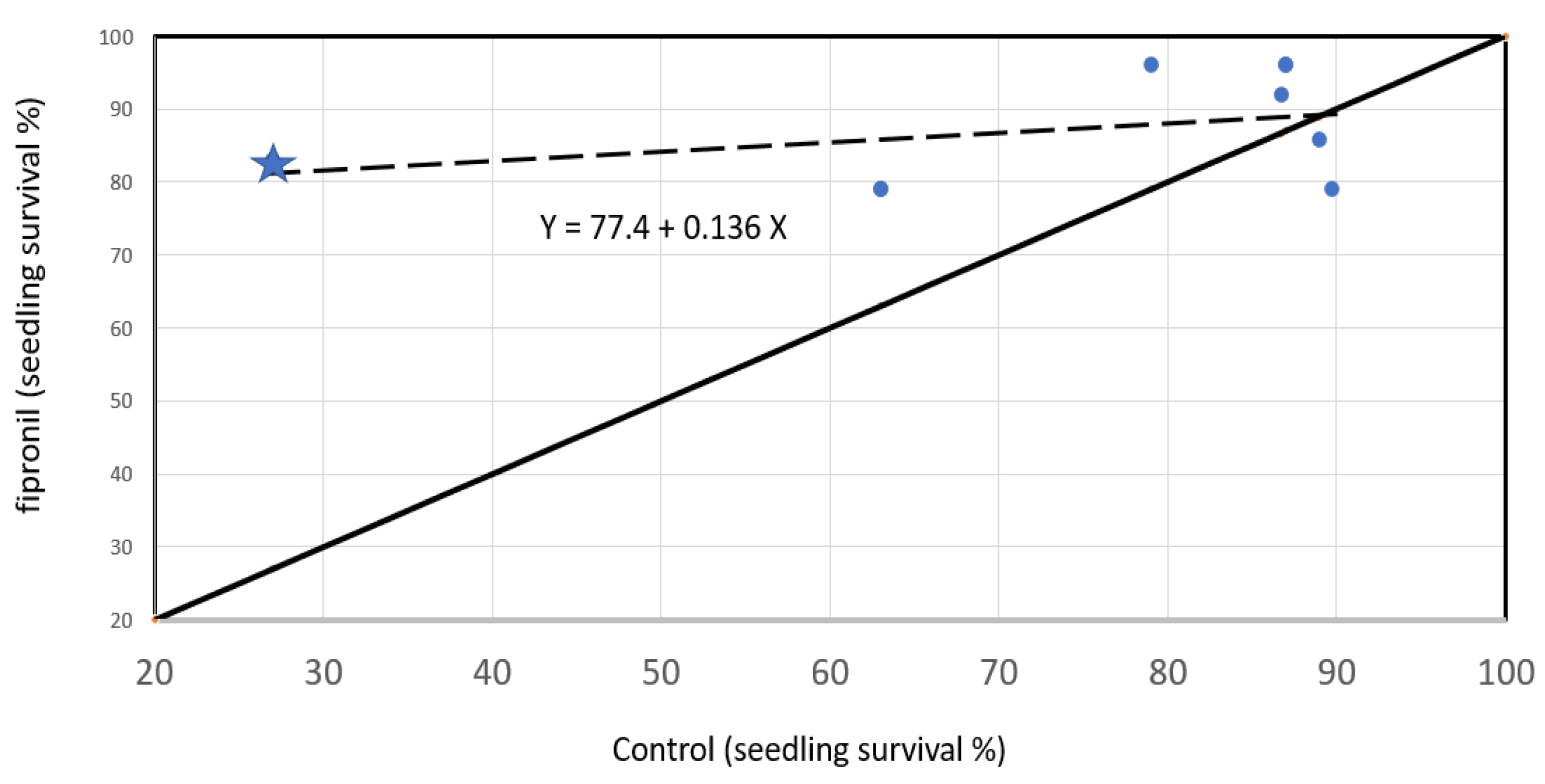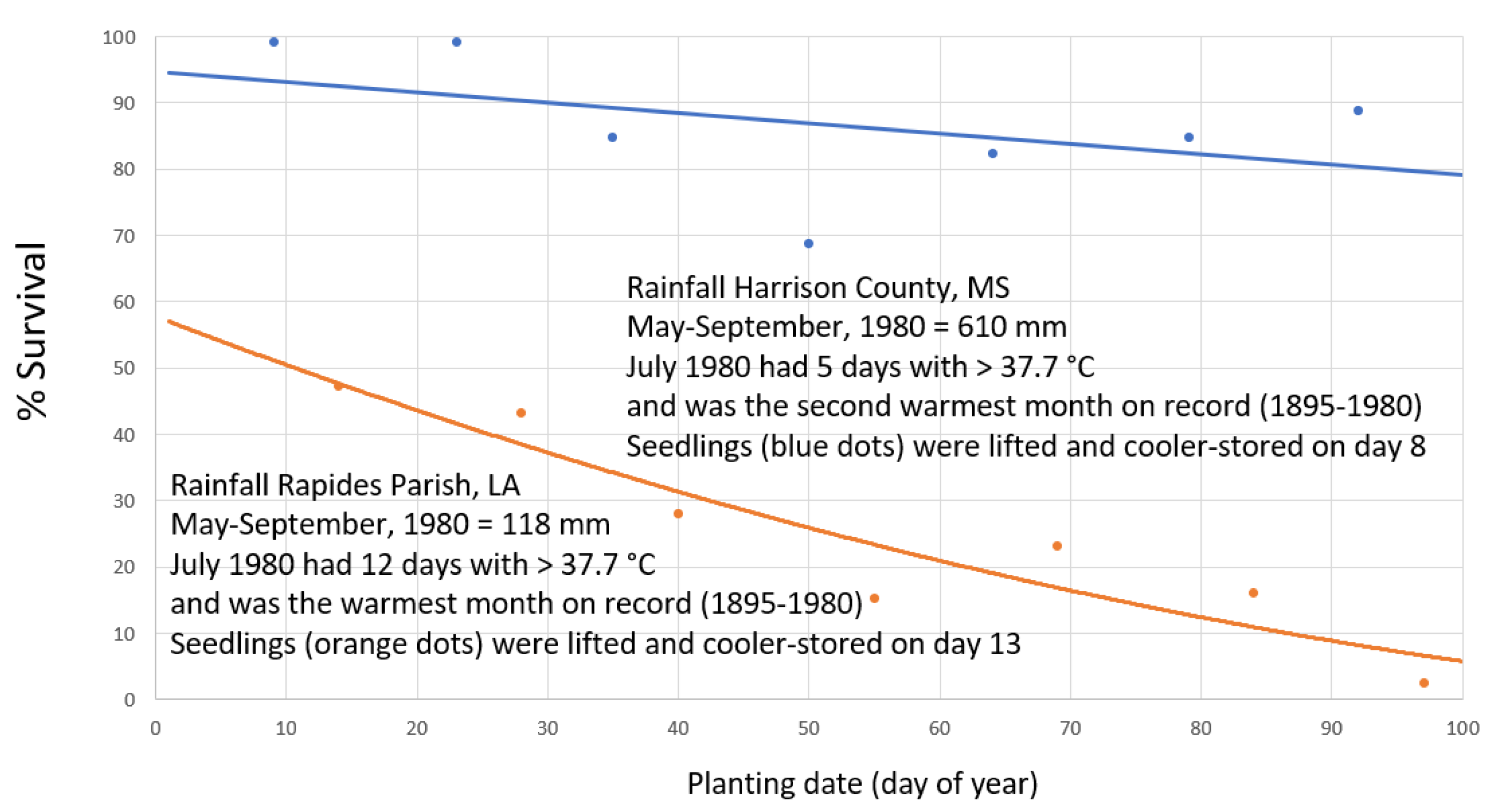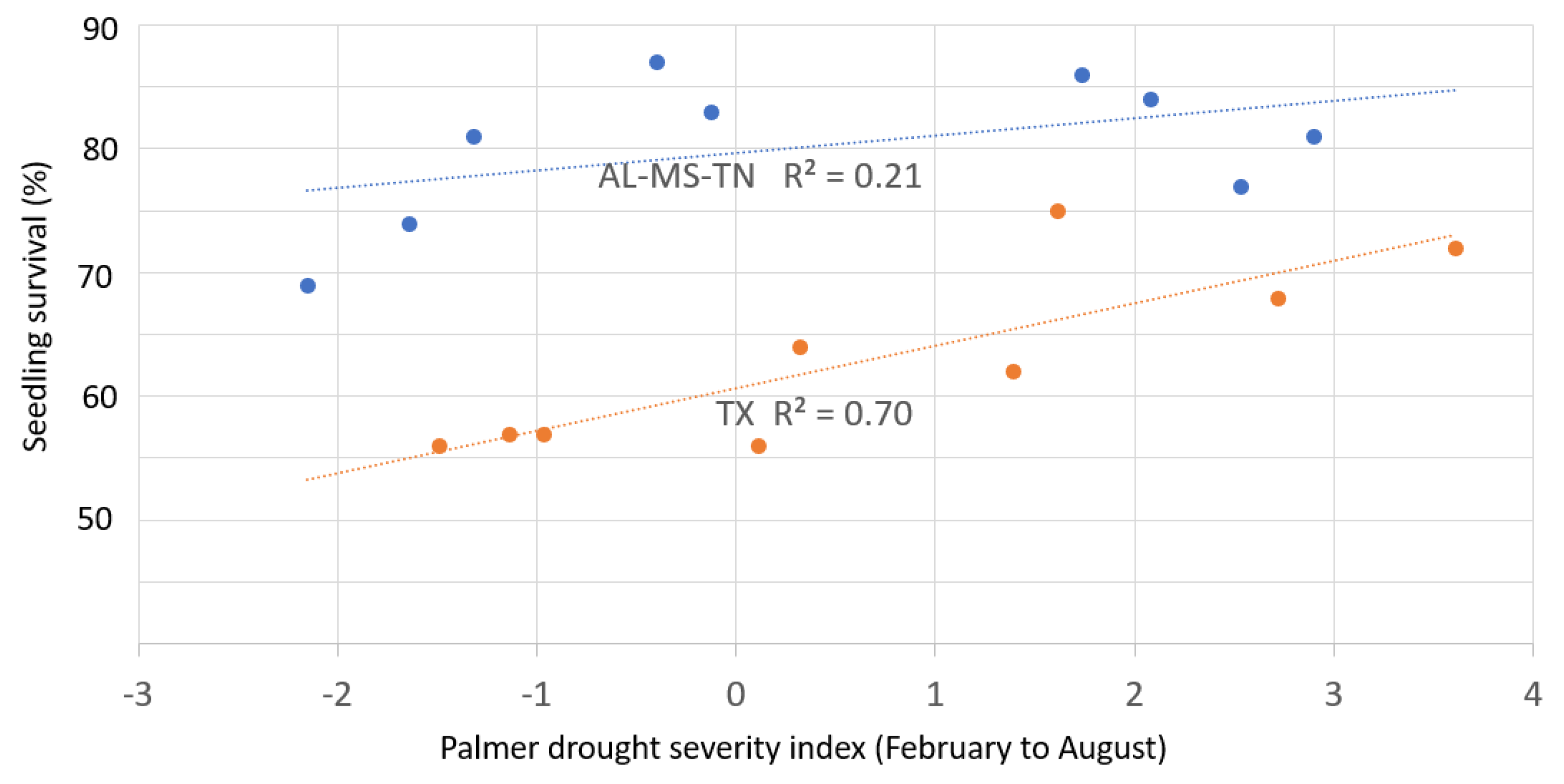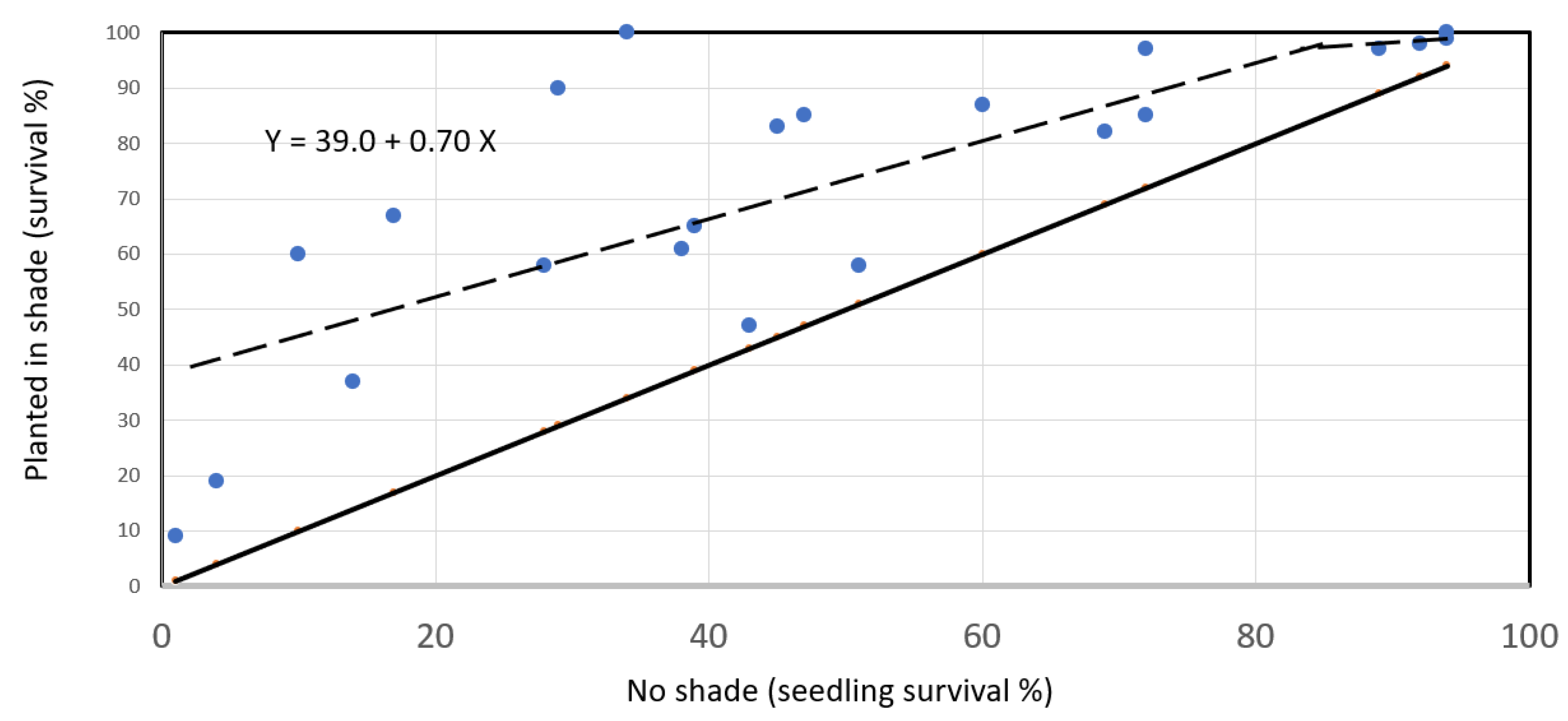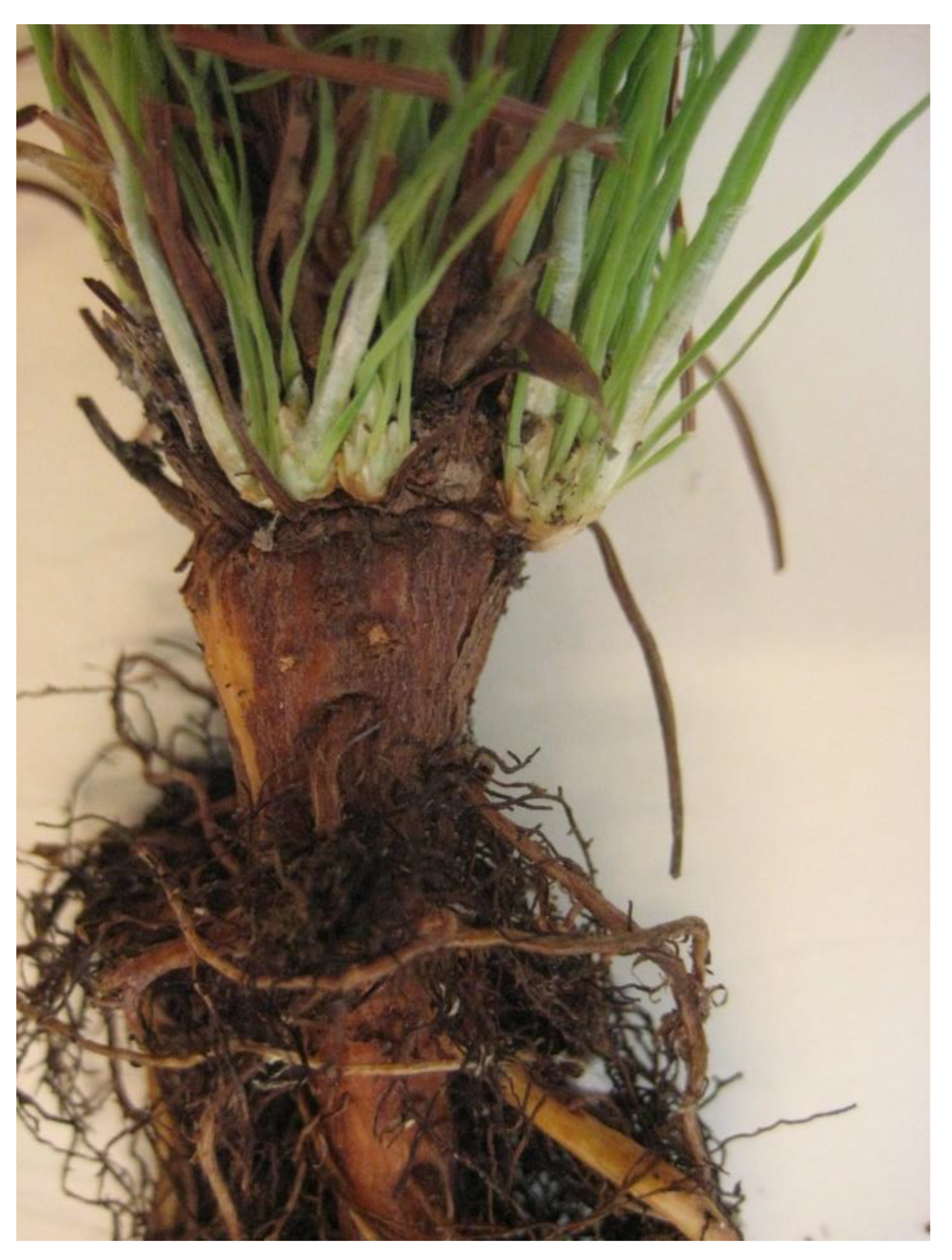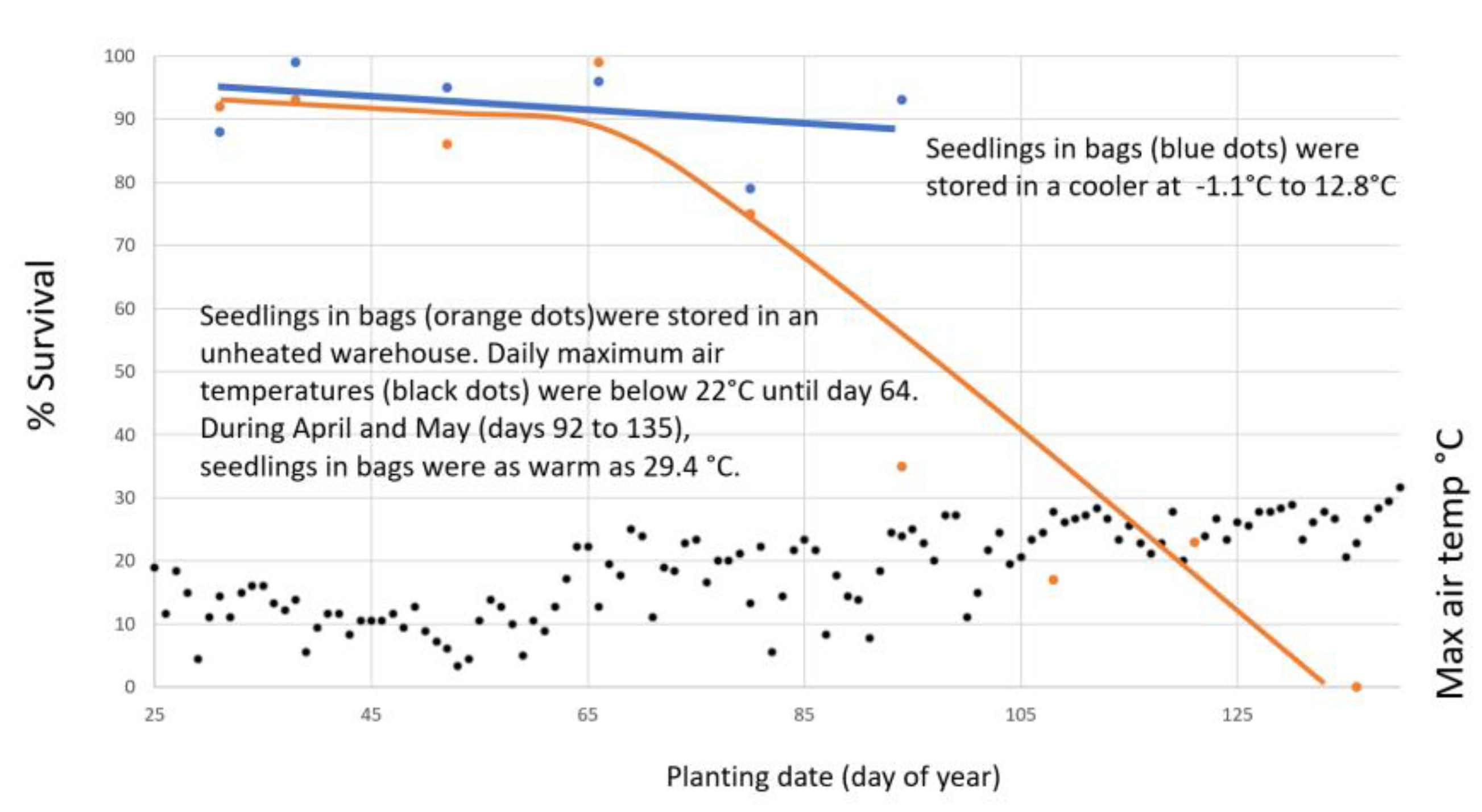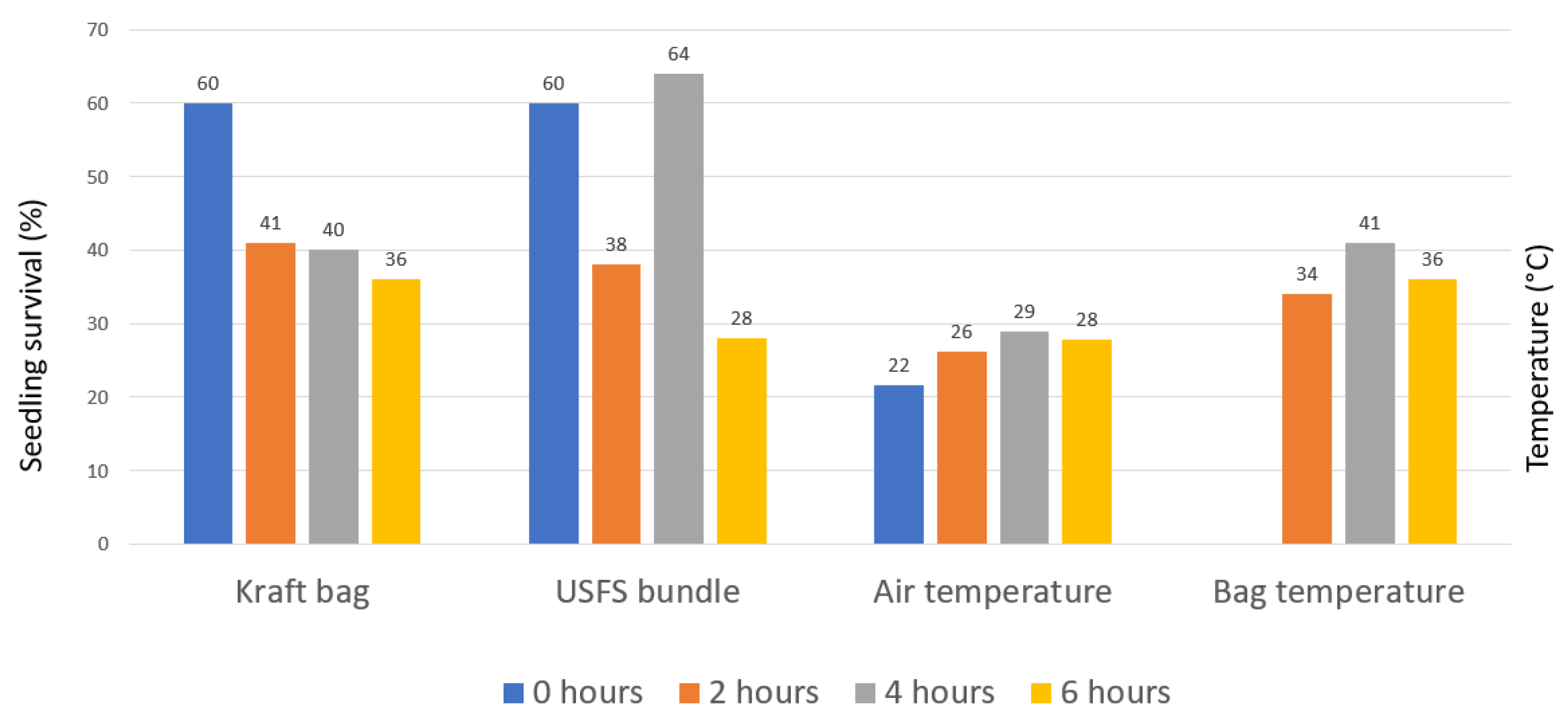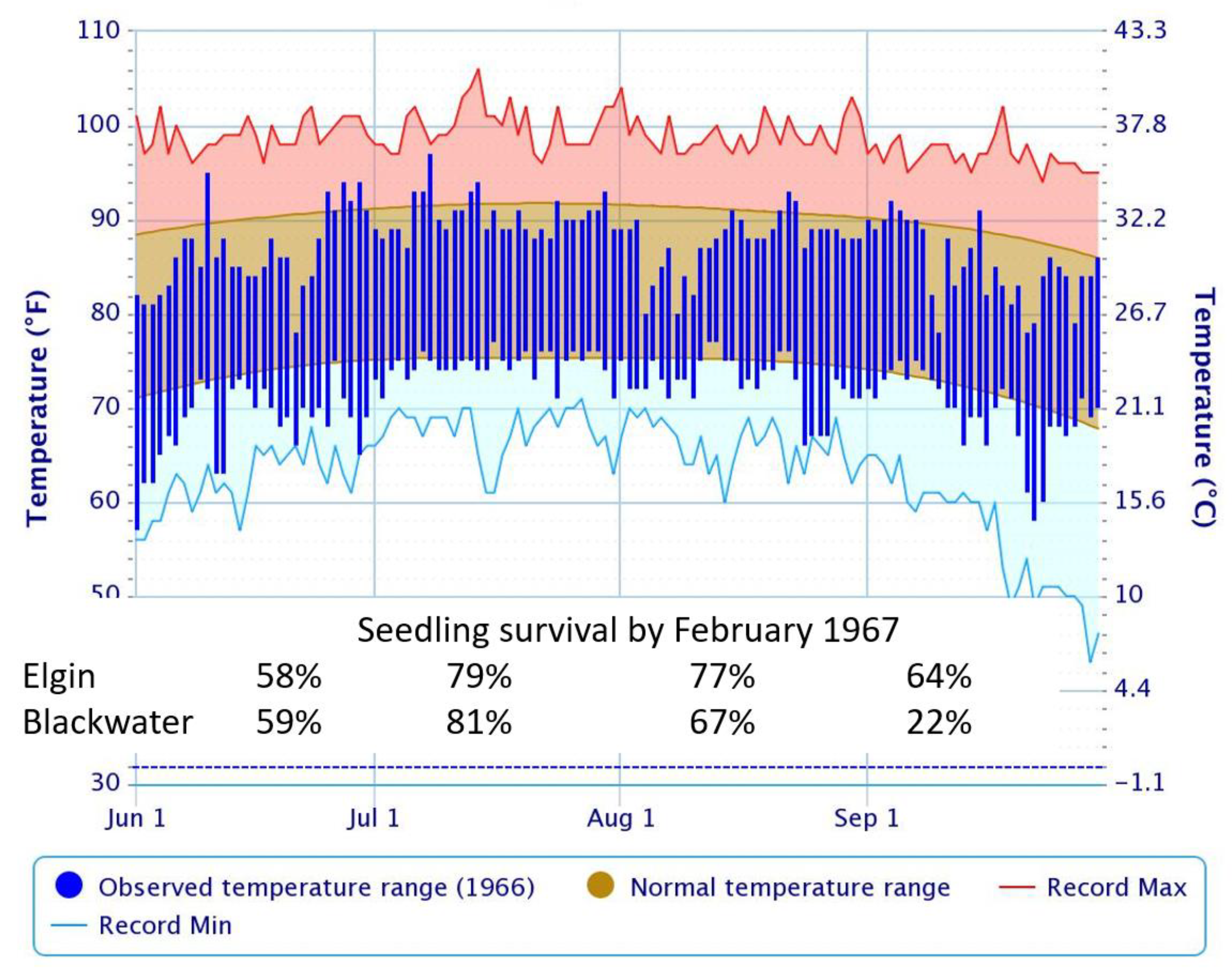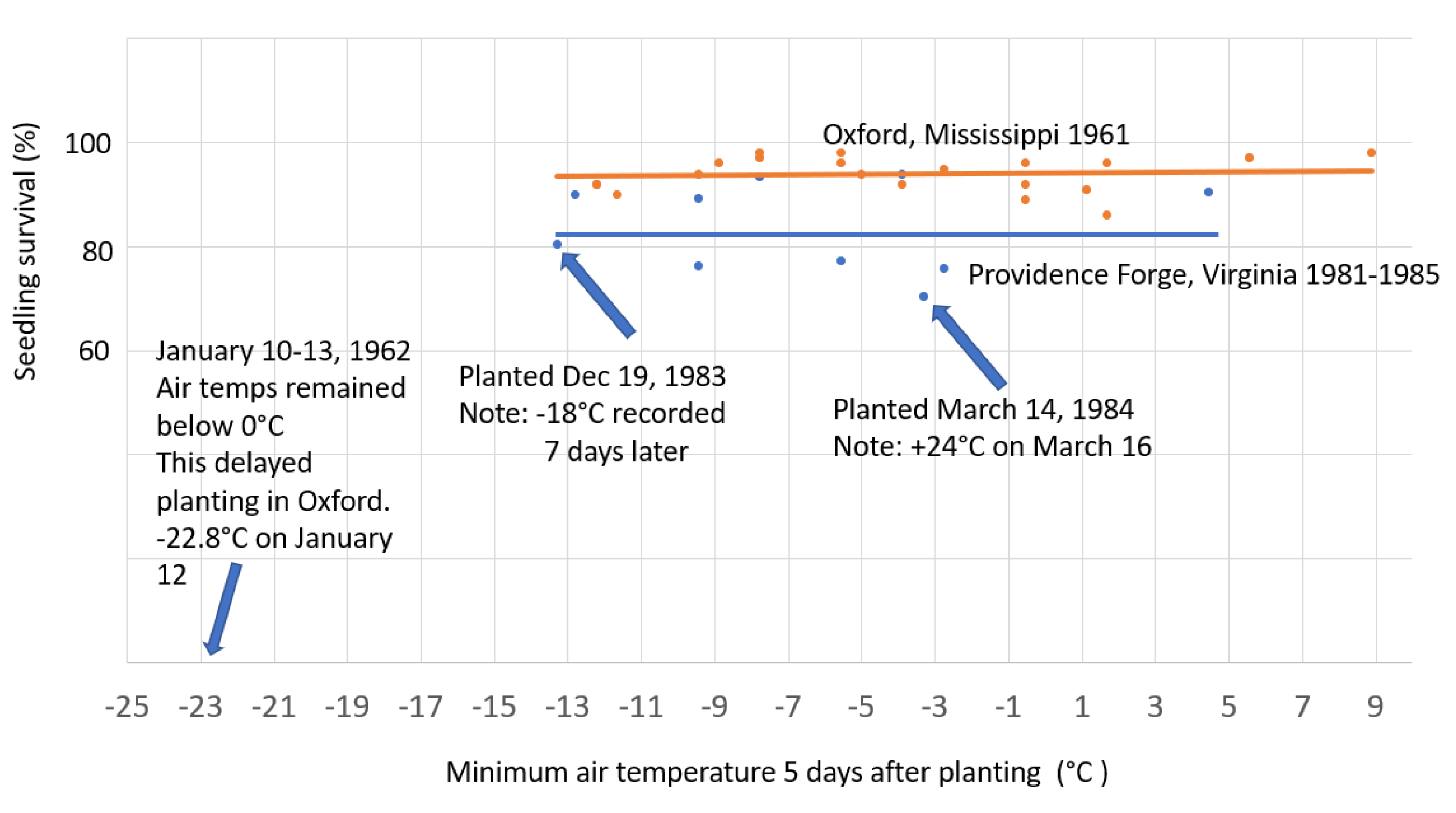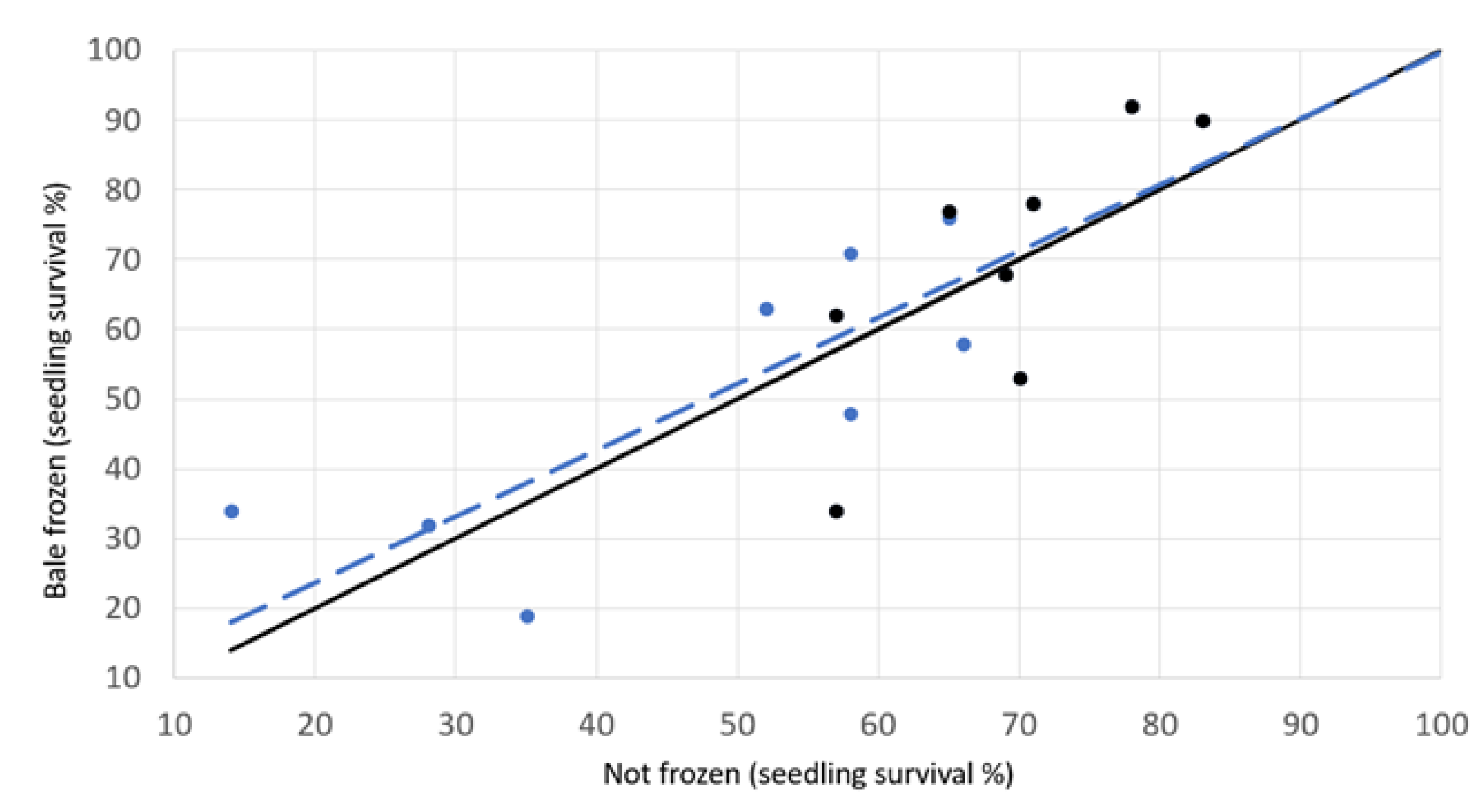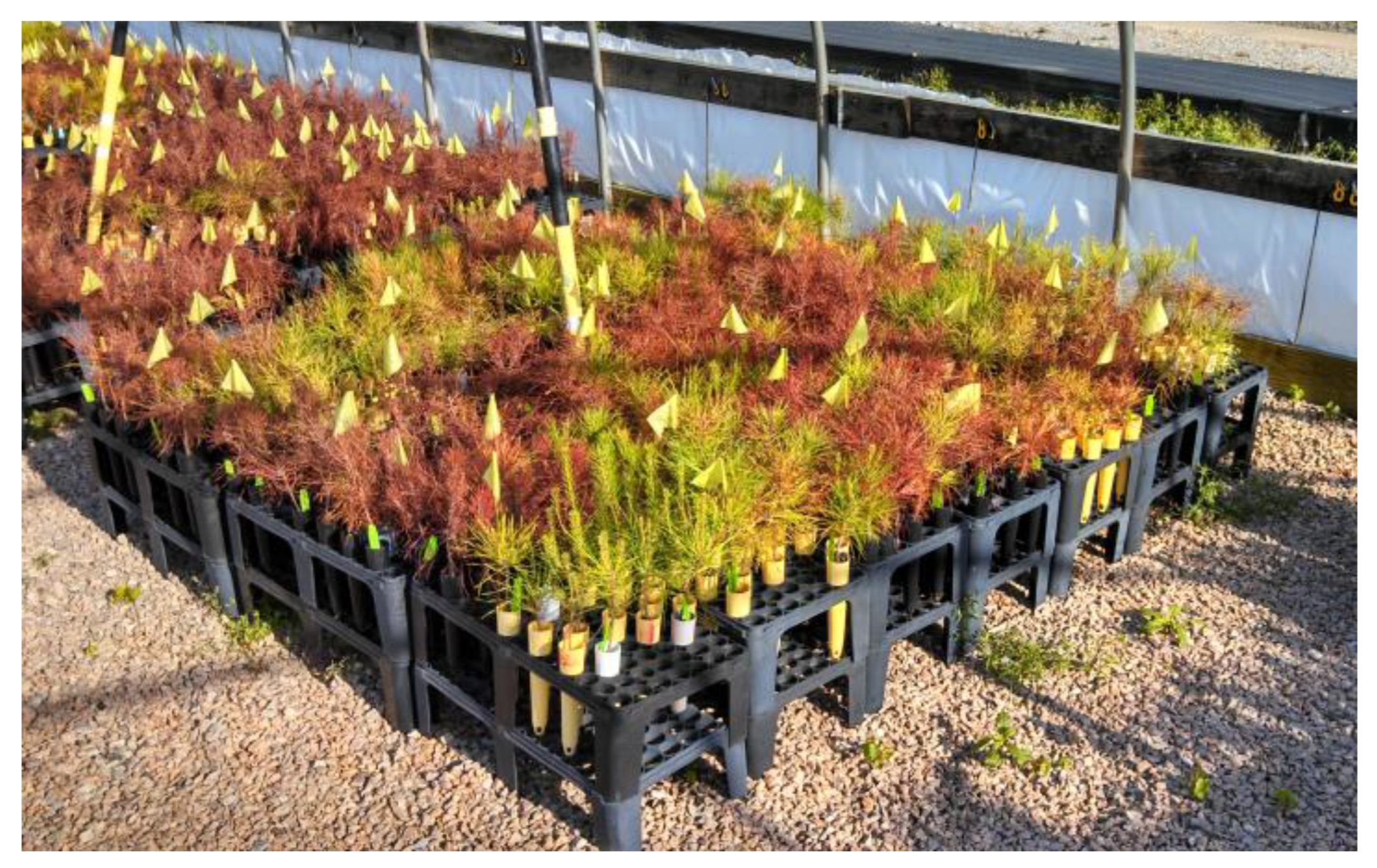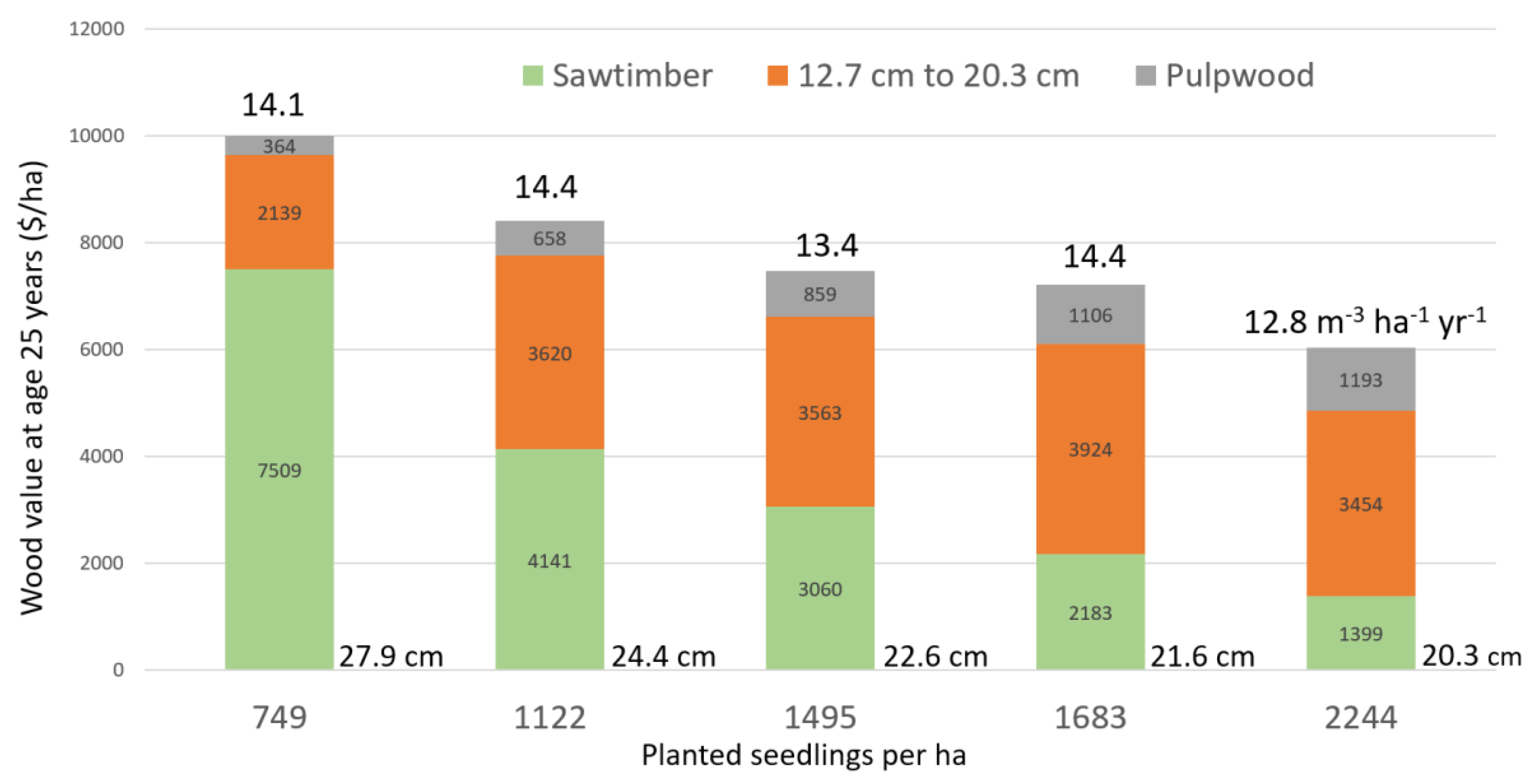1. Introduction
When most factors are optimum, 11-month survival of bareroot pine seedlings can exceed 90% [
1,
2] but in some years survival is less than 75%. It seems the initial survival of pine seedlings in 13 southern United States (SUS) has gradually increased over time (
Figure 1). Average survival of loblolly pine (
Pinus taeda L.) for 58 sites during the 1980s was 74% [
2,
3] and now it averages about 89%. This increase is likely due to improvements in seedling quality of bareroot stock combined with planting more container stock. In the SUS, container stock now represents one-fourth of the pine seedling production.
Most agree that rainfall plays a major role in survival of planted seedlings. If average rainfall has increased, this might help explain some of the increase in rate of survival. In fact, for one region in the SUS, average rainfall for 2019 to 2021 was about 19% greater than for the period from 1955 to 1959 and 15% greater than the period 1975 to 1978 (
Figure 2). Although annual rainfall was near normal in 2019, reported survival for the SUS was 88% and about one out of 20 planted areas had survival low enough to be replanted. Average mortality can exceed 15% in some years (
Figure 3).
The objective of this review is to list non-nursery factors that contribute to initial mortality of pine seedlings. Nursery managers, foresters and landowners may find this list of over 50 factors useful when customers ask what can be done to increase survival. Too often, landowners want a reimbursement for mistakes that were made after seedlings left the nursery. The outline of the paper is as follows.
Section 2 presents literature sources and
Section 3 discusses the importance of keeping good records. Factors affecting survival before planting and during transportation are presented in
Section 4 and
Section 5.
Section 6 covers planting and
Section 7 covers beneficial treatments applied after planting. Weather factors are listed in
Section 8 and
Section 9 involves replanting.
Section 10 covers costs and
Section 11 involves use of statistics by researchers.
2. Materials and Methods
Since 1975, we collected a large number of papers published after 1900. The papers were sourced from books, proceedings and repository sites such as Treesearch, TreeCD, Agricola, Google Scholar. We excluded papers about angiosperms and pseudoreplication and retained papers that contained survival data for pine seedlings grown in nurseries in North America, Canada, Europe and Africa. A few references to survival of Sitka spruce (Picea sitchensis (Bong.) Carr.) and Douglas-fir (Pseudotsuga menziesii (Mirbel) Franco) were included. Many papers involved seedling quality but these were excluded as these effects were adequately discussed in other unsystematic reviews. Papers were retained if they involved factors that killed pine seedlings after they passed the nursery gate. To keep citations to a minimum, a small portion of the total available papers ended up as citations. This review does not address a specific research question and it does not cite all published literature on pine survival. As a result, it is not a systematic review of all literature pertaining to a single question. Powerpoint software was used to construct graphs to illustrate treatment effects on survival of planted stock. Among the 23 graphs, about half present survival data for both the Y-axis (treatment) and X-axis (control). This graphical technique was utilized since it is relatively easy for landowners to understand. It also illustrates that treatment response is often greater when mean survival is less than 80%.
3. Record Keeping
When seedling survival is unexpectedly low, landowners need to know why so that mistakes are not repeated in the future. Sometimes the reason for low survival is obvious but occasionally consultants are hired to determine the cause. When experts arrive soon after the onset of mortality, dying seedlings can be examined and the cause may be determined. However, when expert arrival is delayed, important clues begin to dissipate and are gone after seedlings have dried and decomposed. When this happens, accurate records provide needed clues (see planting log in Supplementary materials).
Unfortunately, key records are often missing. Important information includes, lifting date, storage length, method of transportation to the site, seed origin, seedling morphology, planting date, temperature in storage, planting depth, soil moisture when planting, fertilizer placement and rate. We recommend recording the standardized precipitation index at planting (see Supplementary materials). If an herbicide was applied, the total amount purchased and the total area treated should be recorded along with the application date. Weather records are very important. In 1977, weather stations in the Cumberland Plateau in Tennessee recorded the coldest January since 1895. This likely explains why pine survival averaged 51% in the highland region of the SUS (
Figure 2).
Pine seedlings can die within 30 days of planting [
10] or death can linger for six months to five years or more. When mortality is acute (1 to 3 months after planting), the cause can generally be traced to one factor. Heat exposure due to improper handling/storage or debarking weevils are examples of quick mortality. However, more often chronic mortality occurs within the first five years after planting. The root cause can then be difficult to ascertain as a multitude of factors generally contribute to mortality. For example, machine planted seedlings receiving cold damage on soils with high available water hold capacity with adequate rainfall might not die. However, cold damaged seedlings can contribute to chronic mortality when combined with factors such as root pruning, planting seedlings with the root-collar near the surface, nematodes, and low soil moisture combining to eventually kill the seedling due to too much transpiration. Mortality analysis needs to be conducted by foresters with extensive reforestation experience to avoid repeating mistakes of the past. Often the blame is placed on the nursery when the actual cause is experienced after the seedlings leave the nursery.
4. Preparing the Site
Prior to 1980, site preparation in the SUS was dominated by mechanical methods such as shear rake and pile, bedding, and disking. These treatments helped to facilitate machine planting and reduced growth of hardwood sprouts. Site preparation and road maintenance contractors utilized the smaller crawler-tractors in the winter to pull planting machines and during the spring and summer they used the same machines to cultivate soil and conduct road work. Keeping crews and machines working year-long is a significant economic advantage. Integrated forest products foresters favored mechanical site prep and many experienced foresters of that day commented that woodlands organization were reluctant to change from mechanical soil cultivation to chemical site preparation for fear of losing a “mechanical empire” for lack of a better description. Since machine planting often results in deeper planted seedlings, average survival from machine planting can be greater than with contract hand-planting crews. After effective chemical weed control methods were adopted, companies realized there was little additional benefit from disturbing the soil surface. As a result, the frequency of soil cultivation declined and the use of hand-planting increased.
4.1. Burning
Each year, prescribed burning occurs in the SUS on about 9% of sites before planting pine seedlings. The goal is to control small hardwoods that compete with newly planted pines and to make hand-planting easier [
11]. At a flatwoods site in Florida, burning before planting increased survival by 7% [
12]. Coosa County Alabama was in an extreme drought from July 2007 to March 2008 and seedlings planted in February on burned sites averaged 66% survival while survival on no burned areas averaged 54% (
Figure 4). When seedlings were hand planted in February 2008, burning increased survival by 21%. Possible reasons for this effect include less hardwood competition for moisture, duff in planting hole, fewer live insects in the topsoil, and more rainfall reaching the soil. At some locations, burning increases soil moisture [
12,
13].
Site preparation burning in the SUS has declined over the last four decades for various reasons. In 1980, 98% of the area planted to pines in the lower Coastal Plain was burned prior to planting. During the era of integrated forest product companies, woodlands organizations had a significant workforce and enough equipment to conduct road construction, maintenance, and site preparation (mechanical, burning, etc.). After these companies monetized timberlands, this workforce capacity was lost which lowered the amount of burning. Only a few contractors had the capacity to conduct burning. There were also environmental (smoke management), liability (smoke, wildfire) and soil nutrient concerns that limited wide scale burning [
14]. Currently site preparation burning is limited to sites with enough slash and debris to slow hand planting and reduce planting quality or where there is a high density of wildling pines. (
Appendix A Figure A1).
4.2. Bedding
In the SUS, bedding has been used on sites where high-water tables reduce soil oxygen and reduces pine survival [
12,
15]. In southeast Georgia, burning and bedding increased survival by 7% (
Figure 5). However, at some locations, bedding increased seedling mortality by more than 10% [
16]. The additional mortality was attributed to rough, unsettled beds full of air pockets. Therefore, planting too soon after bedding can increase seedling mortality. Bedding quality affects survival as seedlings planted in low dips generally have higher mortality. This is common in single pass beds with bed quality increasing with double pass bedding. Double bedding might increase survival of slash pine (Pinus elliottii Engelm.) by 5 percentage points. In the lower Coastal Plain, about 31% of planted areas are single bedded while 9% are doubble bedded [
8].
4.3. Disking
On some sites, flat disking may increase early volume growth due to a 9% increase in survival, but there may be no increase in volume where disking has no effect on survival [
18,
19,
20]. Disking is not a common site preparation method today and was most common during intergrated forest product management.
4.4. Subsoiling
Subsoiling (or ripping) compacted soil before hand-planting can increase survival since seedlings are planted deeper and less foliage is exposed to drying winds. On some sites, ripping soil before planting increased pine survival by 7% or more [
21,
22,
23,
24]
Figure 6. When compared to digging a 20 cm deep hole, ripping to a depth of 40 cm increased survival of patula pine (Pinus patula Schiede ex Schltdl. & Cham.) by 16% [
24]. Seedlings should be planted four months after ripping to allow rain to settle the soil. When soil in the rip is not yet settled, planting seedlings on the off-set berm will likely improve survival [
25]. If soil has not settled and seedlings are planted in the ripped zone, mortality may result due to reduced root-soil contact or soil erosion burying seedlings [
26].
4.5. Scalping
Scalping is a recommended practice before planting on former cropland sites. In some cases, scalping increased survival by more than 30% [
27,
28,
29]. This increase is due to reducing weed competition and reducing the populations of insects and disease. On sandy soils, scalping might not reduce the rate of water infiltration. However, on fine-textured soils scalping reduces infiltration and can hold water like a pond. “If the soils are very wet, or the soils are very heavy (high clay content), scalped rows may hold water and drown the seedling” [
30].
4.6. Liming
Often lime is not needed in bareroot pine nurseris unless soil pH is below 4.5 and lime is also not operationally applied in North American plantations. In resesrch trials, applying 4,480 to 6,700 kg ha
-1 of dolomite did not appear to increase mortality of lobolly pine [
31,
239]. However, incorporating a higher rate of 11,200 kg of agricultural grade lime before planting western white pine (Pinus monticola Dougl. ex D. Don) reduced survival on two sites in 1992 by more than 9% [
32].
5. From Nursery Gate to Planting Site
Boxes, bags, and bales of seedlings are transported to the planting site in open trucks, insulated vans, and refrigerated vans [
33]. Seedling mortality increases when open trucks-trailers transport seedlings for long distances during -4°C days. Therefore, transportation should be in refrigerated vans or covered vehicles that are preferably insulated [
34,
35].
5.1. Improper Storage
When soil is moist, it is generally best for landowners to plant seedlings soon after seedlings arrive at the planting site. When weather delays planting, then southern pine seedlings should be stored in a cool environment to reduce heat which encourages fungal growth on roots and foliage. In a trial in Tennessee, survival was greater when seedlings were planted soon after delivery than when seedlings were planted after 9 weeks of storage in ambient conditions (
Figure 7).
A few landowners have access to coolers and store seedlings for a few weeks before planting. Some coolers are equipped to keep the humidity high while others act as a dehumidifier and can dry seedlings over time. Spraying water into the cooler on a daily basis will help maintain humidity within the cooler. If seedlings are not stored properly, they can dry during storage and mortality is increased. Small quanties of seedlings may be stored by heeling trees in sawdust or soil.
In some countries, containers with seedlings are shipped to the planting site and pines are extracted just prior to planting. When freezing weather is immenant before all seedlings are planted, the reamaining containers with seedlings can be placed on the ground and covered with an insulated tarp. This reduces the risk of root injury to unplanted seedlings.
5.2. Water in Bags
Landowners should be careful not to puddle water in bags since “excess water can drown root tips or promote mold on the seedlings” [
37]. In one trial, adding 2 liters of water in bags increased mortality of bareroot spruce seedlings that were stored for 2 weeks at 20°C [
38]. In another trial with bareroot loblolly pine, seedlings were lifted in January and 86 ml of water was added per 1,000 g of seedlings. Seedlings were stored in kraft-polyethylene (KP) bags for 2 weeks at 2°C and this reduced root growth potential by more than 75% [
39]. This occurred even though no mold or fungal growth was observed on roots or foliage.
5.3. Improper Transportation
The preferred way to transport large quantities of seedlings is in a refrigerated van [
40] and small quantities may be transported in insulated trailers [
33]. Temperature should be recorded to ensure seedlings do not freeze or over heat. Seedlings have been killed when transported in the back of a truck during freezing temperatures. Sometimes seedling packages are dropped when unloading seedlings at the planting site. Dropping container-grown lodgepole pine 30 times (1 m height) did not reduce seedling survival [
41]. However, dropping other conifers may reduce root growth potential and decrease height growth [
42,
43,
44].
5.4. Transportation Too Far North
Genetics plays a role in seedling survival especially in terms of response to a hard freeze. For example, some southern Coastal Plain sources of loblolly pine do not survive well when planted in southern Illinois where temperatures might reach -20°C [
45]. Likewise, lower survival is expected when planting Florida sources of pine in Virginia. For example, survival of a local Virginia source of longleaf pine at age 10 years had 80% survival while a seed source from Florida had 51% survival [
46]. Due to first-hand experience with deacclimation freezes, several forest companies in the SUS reject flawed computer-based recommendations to plant pines 700 km north of their native location (i.e. location of mother tree). Most loblolly pine seedlings are planted within 5° latitude of the native origin (≈550 km). For example, in a survey of members of the North Carolina State University Tree Improvement Program, only one member experienced freeze damage when a southern coastal family was planted too far north [
47]. No member reported outright failure due to establishing plantations using a single family. Only about 8% of progeny-test plots established with container-grown loblolly pine were abandoned due to survival rates lower than 60%.
6. Planting
6.1. Root Pruning
Most tree planting guides place too much emphasis on avoiding bent roots and not enough emphasis on keeping roots. The “bent-root-kills” myth has lowered seedling survival because of publications that recommend pruning up to 50% of roots to avoid bent lateral roots and L-shaped taproots. The unjustified fear of a 3-cm bend of the taproot at the bottom of a 20-cm hole encourages (1) removing a portion of the taproot and (2) making a 13-cm deep hole to match a 13-cm pruned taproot. When soil is dry, both practices contribute to an increase in mortality.
In order to make tree planting quicker, one planting guide states to “prune roots to a uniform length by aligning root collars in bunches before pruning” and to prune roots no shorter than 13 cm. In fact, pruning to a 7.6 cm length can reduce pine survival in a dry year by 13 to 28% [
48]. These recommendations suggest it would be OK to prune a 20-cm taproot (with 6 lateral roots) so that after pruning, the taproot would be 13-cm long with 4 lateral roots remaining. Of course, cutting the tap root will make hand-planting easier and reduce the frequency of taproots with a 3-cm bend at the end. However, removing fibrous roots lowers root-growth potential [
49,
50] and increases mortality. For example, pruning 20 cm taproots to a 13 or 16 cm length reduced loblolly pine survival by 4% [
51,
52] and at one location, pruning to a 7.6 cm length reduced survival by 18%. For this reason, a few tree planting guides say “do not allow planters to prune roots.” A contributing reason why machine planting often results in better survival is large roots with long taproots do not slow the rate of planting. As a result, machine planters do not prune roots.
6.2. Root Stripping
Some hand-planters will strip roots just before they insert the seedling into the hole. This practice (typically done by moving the root through a closed fist), removes some of the small fibrous roots and ectomycorrhiza. As a result, root mass might be reduced by 2%. However, the ability of the seedling to produce new roots can decrease by more than 40% [
50] which can increase mortality by 12% or more [
53].
6.3. Root Exposure
Drying roots before planting can reduce root growth which leads to mortality [
54]. In one trial, exposing pine roots outdoors for 15 minutes reduced new root growth by 70% [
55] and reduced survival by 100% [
56]. Exposures of 5 to 10 minutes on a sunny day can reduce pine survival by 5% to 18% [
57,
58,
59,
60] and 30 minutes reduced survival by 10% to 35% (
Figure 8). To increase the probability of survival, planting stock should be protected from direct sun and kept cool. Planter handling and transport should minimize seedling exposure to prevent air drying [
61].
6.4. Machine Planting
Pine seedlings are planted either by machine or by hand. From a 2020 survey of 376,000 ha in the SUS, 40% were planted by machine (
Figure 9). Hand planting is often used on rough sites in the Piedmont and, when available, machine planting is preferred on flat lands in the Coastal Plain. When availability and the costs are reasonable, most regeneration foresters in the SUS prescribe machine planting since the probability of good survival is greater than that for hand planting bareroot stock. In Florida, 30 out of 64 sites were planted with machines [
63].
In Louisiana (December 2000 to March 2001), machine planting on 11,220 ha averaged 87% while hand planting (34,564 ha) averaged 80%. For one company in Alabama, machine planting bareroot pine averaged 86% survival while hand planting averaged 75% survival (
Figure 10). The increase in survival was mostly due to placing roots deeper in the soil [
65], because machines do not get tired of making deep holes at the end of the day, and because hand planters were allowed to prune roots. In years when rainfall was below-average, machine planting resulted in 16% greater survival than hand planting. In contrast, when (January-June) rainfall exceeded 800 mm, survival with machine planting was only 5% better than hand planting. Some machines do not plant container seedlings as well as hand planters [
66]. In fact, some are reluctant to plant container-grown longleaf pine with machines since the risk of burying the plug is great [
67]. In one trial, machine planting of container-grown stock resulted in 64% and 70% survival on scalped and non-scalped areas, respectively [
68].
Various brands of machines are used to plant seedlings [
70,
71] and some machines are able to plant 400 to 800 seedlings an hour, regardless of stock type. In 1982, time required to plant 10 ha of upper coastal plain soil was 11 hours for a machine-planting crew or 15 hours for a hand-planter [
64]. In contrast, some container-only machines plant less than 400 seedlings per hour [
72,
73]. The time required to machine plant 1,000 pine seedlings depends on spacing between seedling rows. In theory, a spacing of 5 m between rows would require half the time as a typical 2.5 m row spacing which would lower the cost for machine planting.
Cost of planting 1,000 seedlings could be
$120 with hand planters or
$170 with machines. If average survival is greater with machine planting, the
$50 greater cost might increase survival by 0% for wet years and 20% during dry years (
Figure 10). When planting 1,000 seedlings per ha, a 10% increase in survival equates to an additional 100 living seedlings. When a seedling costs 20 cents and planting costs 12 cents, 100 dead seedlings would equal a loss of
$32. Many landowners choose hand-planting and are unwilling to spend
$50 in order to save
$32 in dry years. However, at a cost of 50 cents per seedling, a
$50 investment in machine planting might save
$62.
6.5. Hand Planting Tools
Many types of tools are available for hand planting but, generally, the size of the root system is a factor when selecting tools for operational use. A metal pipe used to plant a 30 cm
3 container plug is not suitable for planting a seedling that grown in a 1,000 cm
3 container. A planting spade is the preferred tool in New Zealand while a shovel is popular in Oregon [
74]. In the SUS, bareroot seedlings are typically planted with either a planting bar or hoedad [
75]. All four tools can be used to make a 25 cm deep hole. When the hole is deep enough, soil moisture is adequate, and the planting method is correct, good survival can be achieved. Tools designed to make a 10-cm deep hole are not recommended for planting bareroot seedlings.
6.6. Family Block Planting
Planting advanced, half-sib and full-sibling families of loblolly pine in family blocks is a common practice in the SUS. In 2019, over 45% of loblolly pine stands were established using second-cycle seedlings [
8]. In theory, the method of planting (family-block vs. mixed genotypes) does not affect overall seedling survival during the first year. However, some foresters notice lower than expected survival when improved genotypes are planted in single-family blocks. Due to record keeping, one organization noted a certain family had 10% lower survival than others [
47]. Large landowners can use this knowledge to their advantage when planting half-sibling blocks the following year. In contrast, some landowners own small forests and they might plant seedlings once every 25 years. If they decide to plant a mixture of 30 genotypes, they might achieve 96% survival in a good rainfall year or 56% survival in a droughty year (
Figure 11). However, if they are unlucky and plant a fast-growing family with the lowest survival, they may get only 29% survival during the bad year.
6.7. Seed Source
There is significant genetic variation within the natural range of loblolly pine, extending from southern New Jersey to southeast Texas. Limited to the north by cold temperature and to the west by rainfall, native loblolly pine races have developed that are adapted to local climates. The adaption to local climatic conditions is referred to as geographic variation. Seed harvested from these geographic areas vary in their potential for adaptation and survival depending on where they are planted. Seed sourced from warmer climates within the loblolly range grow faster than those from more northerly climates. However, the principal factor influencing survival within natural ranges is the average yearly minimum temperature at the seed source native location [
77]. Moving warmer climate loblolly pine seed far north can result in poor survival [
45] and long-term adaptability issues due to cold, snow, and ice damage. Eastern loblolly pine seed sources, such as Atlantic coastal material, grow faster than western sources. The slower growing seed sources of southeast Texas are more tolerant of drought, as they have adapted to lower rainfall and drought conditions. These western sources of loblolly pine cease growth immediately at the onset of drought, whereas seed sources from eastern geographic regions tend to continue to grow. Movement of Atlantic coastal material into the western Gulf coast region is common which could reduce survival during drought conditions.
6.8. Root Soaking
Ideally, roots should not be allowed to dry in storage or during transportation. Since this does occur [
78,
79,
80], then soaking roots in water might increase the probability of seedling survival [43,79,81;
Figure 12]. In Pennsylvania [
80], loblolly pine roots were soaked for 24 hours before planting and nine more seedlings survived when compared to nonsoaked seedlings (40 seedlings planted per treatment). However, soaking roots for 4 hours before planting reduced survival in Mississippi for some unknown reason [
81].
6.9. Washing Roots
Soil often adheres to the roots of bareroot seedlings so some landowners may be tempted to wash pine roots before planting. Although soaking roots for a few minutes can be beneficial when roots have been desiccated, washing roots is not recommended since it can reduce survival. Six decades ago, Thomas Swofford said “When you are washing your seedling roots with water you are also destroying some of your mycorrhiza, as well as some of your rootlets” [
83]. In one trial, washing loblolly pine roots reduced survival by 13% [
84].
6.10. Root Coatings
Several moisture-holding materials have been applied to seedling roots to protect them from desiccation prior to outplanting. These include sphagnum moss, kaolin clay, and hydrophilic polymers also known as polyacrylamide gels. Polyacrylamide gels began to appear in the late 1960’s [
85]. Today, pine roots in the SUS are treated with polyacrylamide gels to (1) protect seedlings from desiccation or (2) to improve water relations after planting. Amount of water mixed with 1 kg of polyacrylamide can vary from 300 kg to 1,100 kg. The amount of gel used per 1,000 seedlings can range from 2 to 6 kg. Using the right type of gel can increase survival (
Figure 13) but the wrong type can decrease survival after planting [
86,
87,
88]. A clay dip was popular in the past, but a gel treatment provides better protection, costs less, is less messy, and requires less transportation and storage space. This explains why only three nurseries treated roots with a clay dip in 2022. The preference for a clay dip is not based upon research, but instead is based on tradition and because the clay is readily visible on the roots. When nurseries first switched from clay to gels, landowners complained they could not see the gel on the roots.
When environmental conditions are favorable and roots have been protected, there is no expected gains from applying gel to roots before outplanting. However, when conditions are not favorable, gel treated roots can reduce mortality [
87]. When seedlings treated with hydrogels were exposed for 2 hours before planting survival was 40% higher than roots treated with roots dipped in water. Similarly, in 8 of 20 studies, applying a gel might increase survival by 40% [
89].
6.11. Clipping Foliage
Tall bareroot pine seedlings with too much foliage have an increased risk of mortality when planted on dry sites or in years with limited rainfall [
90,
91,
92,
93,
94]. How much foliage is too much for a pine seedling depends on the amount of root mass, species, stock type, and date of lifting from the nursery. A landowner has three options when delivered seedlings do not meet the target seedling’s shoot/root mass ratio. Ideally, the nursery will exchange seedlings for stock that is closer to the desired target seedling. When this is not possible, pine seedlings with tall shoots can be top-pruned to the desired height or can be planted with the root-collar 10 to 15 cm below the surface. Planting seedlings deeper on well drained sites reduces the amount of transpiring foliage.
For bareroot longleaf pine, clipping needles (e.g. length about 15 cm after clipping) just before planting reduces transpiration and typically increases survival (
Figure 14). In one study, clipping needles reduced transpiration by 30% and increased survival by 10% or more [
92]. However, clipping needles down to 2.5 cm is too short and this will reduce survival [
93,
94].
6.12. Planting Hole Depth
There are two schools of thought regarding planting hole depth. One school says to make a hole the same depth as the taproot while the other school believes in making a deeper hole using a machine or shovel. In well-drained soils, a 20-cm deep planting hole will increase survival (of stock with a 30 cm shoot) when compared to a 12 cm deep hole. This is because placing roots closer to a moist soil zone will increase survival. When sufficient rainfall results in high survival, planting 30 cm tall pines deep with 15 cm above ground will increase survival. In some cases, height of pine seedlings is only 10 cm long and a deep hole is not necessary for such small seedlings. Planting small container-grown pine seedlings with the root-collar 5 to 6 cm deep is recommended in Finland [
95] and an 8 cm depth can reduce damage from insects and drought [
96].
6.13. Container Plug Exposed
There are two schools of thought regarding planting depth for container-grown longleaf pine (
Pinus palustris Mill.) Some say the top of the plug should be completely covered with soil to prevent “wicking” moisture out of the plug [
37,
97,
98,
99,
100]. This idea might have originated at the Wind River Nursery where containers (diameter 6.4 cm; height 25 cm) were fabricated using paper towels. At the planting site, the paper containers were planted in holes about 28 cm deep. Betts [
100] said “If the toweling sticks above the ground, it will act as a wick and pull the moisture from the area around the tree roots to the soil surface where it is lost by evaporation. A handful of dirt, duff or other debris scattered over the top of the tube can help seal off the planted tube from loss of moisture to the atmosphere.” This extra work would not be needed if the recommendation at that time had been to place the bottom of the container 30 cm below the surface instead of placing the root-collar at the level of the soil surface. A few years later, regeneration foresters were told to plant container plugs deeper and cover the plug with soil to prevent drying [
98,
99]. Planting container-grown pine seedlings with root-collar 10 cm below the surface is a valid practice for pines other than longleaf pine. For 30 cm tall seedlings, this practice reduces the transpiration rate and, in dry periods, will increase seedling survival in well drained soils [
101,
102].
In contrast, the other school recommends bareroot [
103] and container-grown longleaf pine seedlings should be planted with the root-collar 1 to 3 cm above the soil surface. Studies indicate exposing the top 2.5 cm of the plug did not reduce initial survival [
104,
105]. In fact, covering the plug with 1 cm of soil increased mortality in Alabama [
104]. Although numerous trials with other species show a survival benefit for deeper planting of bareroot stock [
102,
106,
107], there are no data to support the belief that planting longleaf pine seedlings with 1 cm of soil over the plug will reduce mortality. In fact, many bareroot and container-grown longleaf seedlings have died because ponded water covered the terminal bud or because erosion covered the terminal bud with soil.
6.14. Planting in Wrong Month
There are two schools of thought regarding the best time to plant container-grown seedlings in the SUS. One group recommends planting in moist soil from October to December 1 while the other school says fully developed seedlings can be planted in any month of the year. Although researchers can sow seed in any month, operational nurseries typically sow seed in April or May and seedlings are ready to plant in October [
108]. Planting seedlings before December allows for new root growth and established seedlings are typically tolerant of root inhibiting herbicides applied the following May. In a survey of 59 trials using container-grown longleaf pine, most researchers (47%) planted during the fall (October to December) while 36% planted during the winter (
Figure 15).
Technically, there is no wrong month to plant pine seedling, only a wrong time to plant. For bareroot pines, the planting season in the deep SUS can extend from October to February but a dry February can be the wrong time to plant pines (
Figure 15). An estimate of the amount planted by month might be 1% in October, 5% in November, 15% in December, 40% in January, 25% in February, 14% in March, and <1% in April. In Virginia, bareroot seedlings had 81 to 94% survival when planted before December 21 (
Table 1). In Louisiana, March and April are the worst months for achieving high survival with bareroot stock [
110] while these months are acceptable in regions north of Tennessee and North Carolina [111,112).
March and April plantings should be avoided in the SUS since seedlings do not have enough time to establish roots before the hot-dry season. For example, planting loblolly pine seedlings on March 1st in Louisiana had 64% survival [
114] while April plantings had 38% and 43% survival in Tennessee and Kentucky, respectively [
115,
116]. Landowners who plant in moist soil in October or November are planting prior to the cool-wet season while those who plant in March (below 37° N) are planting just prior to the hot (possibly dry) season.
Container-grown seedlings lifted on November 13, 2001, stored for two months, and planted on January 22 (after freezing temperatures) survived well. In contrast, seedlings stored for 10 weeks and then planted on December 22 with little natural chilling had 38% survival after a -7.2°C freeze (January 5) (
Figure 16). In contrast, a -1.7°C event on January 26 likely did not injure seedlings planted four days earlier. Mortality due to freezes in December is referred to as the “December dip” [
117].
6.15. Adding Water
When soil is dry, some landowners add water at time of planting. In South Africa, container-grown pine seedlings are planted during the summer rainfall season and 1 or 2 liters of water are sometimes added to the planting hole (
Figure 17). Some mechanized tree planters are equipped with water tanks to water seedlings as they are planted [
119]. Although uncommon, large-scale irrigation systems are sometimes used to establish trees in areas with limited rain. In one trial, survival of irrigated and non-irrigated pines was 100% and 30%, respectively [
120].
6.16. Loose Planting
Except for incorrect planting depth, loose planting may be the most important cause of seedling mortality [
10,
121]. The test for loose planting involves holding two or three fascicled needles between the thumb and finger and pulling upwards. If the seedling is pulled out of the hole, the seedling was too loose and there was insufficient contact between soil and roots [
121].
6.17. Pulling Seedlings Up
Some outdated planting guides say that a “curled root will kill the seedling.” Using this myth, a 1989 hand-planting planting guide says to push the roots “deep into the planting hole. Pull the seedling back to the correct planting depth.” This method is not used by machine planters who plant the root-collar about 14 to 17 cm below ground [
65,
107]. If hand planters take the extra time to use the “pull-up” technique, the root-collar will be near the ground-line and they will get paid less due to planting fewer trees. However, there are no studies to show that when planted deeply, a curled root will kill the seedlings. Therefore, the “pull-up” method may move the roots away from moist soil, expose more foliage, and in dry months this can reduce survival. Higher survival from machine planting (which typically plants roots in an L-shape) may be in part due to not using the “pull up” method. In Canada, planting the root-collar 7.6 cm below the surface increased survival when compared to conventional planting with the root-collar near the soil surface [
122].
6.18. Adding Fertilizer
There are two ways improper fertilization kills seedlings. When weed growth is stimulated, the extra competition reduces soil moisture and sometimes weeds overtop seedlings. For example, on a site in Tennessee, applying 114 g of N-P-K fertilizer on the soil surface around each seedling increased weed growth and grasses overtopped seedlings. As a result, survival of loblolly pine was reduced by 38% [
123]. In Texas, a broadcast treatment (140 kg ha
-1 of diammonium phosphate) reduced survival by 12% at one location and 27% at another [
124]. In Alabama and Virginia, a broadcast treatment (280 kg ha
-1 of diammonium phosphate) did not reduce survival of loblolly pine [
19].
When fertilizer is placed on roots in the planting hole, the salt effect can kill roots. In Louisiana, an application of 0.6 g of fertilizer per seedling killed 66% to 99% of the treated pines [
110]. In California, placing 30 g of fertilizer in the hole reduced pine survival by 24% [
125]. Likewise, all container-grown loblolly pine seedlings died when a landowner applied an unknown amount of fertilizer directly into the planting hole just before planting. Even when fertilizer (100 g containing 12 g N) was placed in an adjacent hole, 15 cm distant from the seedling, survival was reduced by 12% [
126]. To reduce the chance of increasing weed growth, some researchers place a low rate of fertilizer below ground at time of planting or several months later. For example, placing a slow-release fertilizer pellet (4.2 g N;
$0.15 per pellet) 10-13 cm distant from the roots, did not reduce pine survival [
127,
128].
6.19. Adding Fungicide
At some locations, treating roots of longleaf pine with benomyl and clay just before planting increased survival by 31% [
129]. Likewise, applying benomyl in the planting hole increase survival of patula pine seedlings by 11% in South Africa [
130].
6.20. Adding Insecticide
In Sweden, about 1% of seedlings died when treated with an insecticide while mortality from
Hylobius abietis exceeded 50% on control plots [
131]. In South Africa,
Hylastes angustatus and white grubs were responsible for insect-related mortality of patula pine (
Figure 18). Applying an insecticide to the planting hole does not increase survival when insect populations are low but it might improve survival when nematode populations are high. Typically, most researchers assume nematodes do not reduce survival of pine seedlings.
6.21. Adding Peat Wedge
When rainfall is not optimal, placing a peat wedge at the bottom of a planting hole can increase survival of bareroot stock planted on shallow soils. Adding one saturated peat wedge increased survival of 2-0 pine seedlings by 40% or more [
122]. Nearly all container seedlings in the SUS are planted with roots already incased in a peat-based plug (cone or rectangle).
6.22. Antitranspirant
Applying an antitranspirant to seedlings before planting will have little effect on survival when soil moisture or rainfall results in more than 85% survival. In Georgia, a 20% increase in survival resulted when a water emulsifiable organic material (di-1-p-menthene) was applied to pine seedlings in March (
Figure 19). This material did not increase survival when seedlings were planted in February (> 85% survival) but increased survival by when seedlings were under stress from being planted late in mid-March [
132]. Various antitranspirants are available and some are more effective than others [
133].
7. After Planting
7.1. Vegetation Control
In general, competing vegetation reduces survival of shade-intolerant pines. Therefore, reducing biomass of weeds can increase survival in areas where moisture is limiting. In some cases, improper use of application equipment and incorrect herbicide calibration has increased seedling mortality. When using a 50% banded herbicide application, some forget and mistakenly apply twice the recommended rate.
The importance of intraspecific competition control of wild natural pine is often overlooked since it can reduce the long-term survival of genetically improved trees. The stocking can be so intense (
Appendix A Table A1) as to require a precommercial thinning at age two to three. Without an early thinning, the superior genetics is often diluted as it is nearly impossible to distinguish between wild pines and improved genotypes when trees are five-years-old.
7.1.1. Mowing
When done correctly, mowing nine times during the first three years after planting can reduce weed biomass without killing planted pine seedlings [
134]. However, at some locations, mowing can reduce seedling survival [
135].
7.1.2. Herbicides
After planting, about 85% of the area is treated with herbicides in the SUS [
8]. Appropriate use of herbicides helps to explain the increase in survival since 1955 (
Figure 1). Although errors in application can result in lower survival, the frequency of these mistakes decline when using experienced applicators.
Poor communication can result in herbicide related seedling mortality. In one case, a contractor was told to treat 10 ha with a 50% band of hexazinone at a rate of 1.1 kg ha-1. The contractor was accustomed to applying a 2-m band of fertilizers (tree rows spaced 4 m apart) and this “fertilizer method” was also used when applying herbicides. Therefore, instead of applying 5.5 kg of hexazinone to 10 gross ha, the contractor purchased 11 kg and applied it in bands to 10 gross ha. This mistake applied twice the amount of herbicide as intended. When herbicides are applied in bands it is important to clarify how much herbicide to apply to the treated area (instead of the total area). Accurate records are important when herbicide errors kill seedlings.
Seedling mortality may occur due to backpack application errors when herbicide products are mixed in the individual sprayer but not properly agitated to create a unform tank mixture. Poor agitation may cause some herbicides to settle in the bottom of the sprayer which applies a potential toxic rate initially followed by an inadequate rate near the end of the application.
Root inhibiting herbicides might increase pine mortality when rainfall after planting is below normal. Some organizations apply a tank-mix of herbaceous and woody herbicides in October and then plant pine seedlings in November. When the herbaceous herbicide does not inhibit root growth, the reduction in competition can increase survival. However, when rainfall is limited after planting, mortality of newly planted seedlings increases when the root-inhibiter reduces uptake of soil moisture.
7.1.3. Applying a Mulch
Mulch can help reduce loss of soil moisture and in some years, a mulch will increase survival. In one dry year, adding mulch around pine seedlings increased survival by as much as 26% [
136,
137]. When rain is near normal, survival in mulched areas increase by 5% [
134].
7.1.4. Prescribed Fire
Prescribed burns can reduce fuel loads and can lower the risk of mortality from wildfires. However, if conducted too soon after planting, prescribed fires can reduce survival of planted pine seedlings [
138,
139].
7.2. Browse Protection
Browsing can kill pine seedling when they are pulled out of the planting hole or when the entire shoot is decapitated. Once seedlings become established, however, browsing 50% of the new shoots may not reduce survival. Browsing pines by rabbits can increase mortality [
140] but sometime browsing soon after planting will reduce seedling height and increase survival [
141]. When browsing removes the shoot (height after browsing 6 cm), death could occur when weeds overtop pines with suppressed height and root growth. However, on moisture deficient sites, browsing (height after browsing 16 cm) reduces the rate of transpiration and this can increase survival [
142].
In some areas, deer will browse more on container-grown stock than on bareroot stock [
143]. Gopher herbivory of planted seedlings is common in the ponderosa pine range [
144].
Cows can kill 10% of pine seedlings by trampling, dislodging, and eating pine seedlings [
145,
146]. At one site that was bedded, cows walked in the furrows and ate all pines that were planted in the furrow, but did not injure or dislodge seedlings that were planted on the top of the beds (personal communication John Mexal). Afforestation of pastures following long-term grazing of livestock can result in significant mortality during droughts due to soil compaction which limits planting dept and root growth.
Carbohydrates in the roots of longleaf pine often attracts hogs which pulls up seedlings after they are planted. “Hogs probably have ruined more longleaf plantations than drought, pocket gophers, leaf-cutting ants, and brown spot combined [
110]. In Louisiana, hogs caused the complete destruction of 364 ha of slash pine and recently damaged loblolly pine at two sites in Texas [
67].
7.2.1. Tree Tubes
Tree tubes are used to reduce damage from browsing. For eastern white pine, installing plastic tree tubes might increase survival by 11% [
147] or decreases it by 27% [
148]. The environment in the tube likely explains why mortality can increase when using unvented tubes. Daytime temperature inside tube is higher than ambient and this might explain why survival is low at some locations. Use of tubes can cost more than
$3.00 per plant [
149]. and therefore, use is limited to governments, universities, wealthy landowners or small areas.
7.2.2. Fences
Deer populations have increased in several areas since 1950. Hunting clubs use fences to keep deer in and foresters sometimes use fences to keep deer out. In the northeastern region of the USA, fences are commonly used to protect natural regeneration from deer browse of high value hardwoods.
7.2.3. Repellents
There are various types of chemical repellents on the market but most wear out over time. Visual repellents include bud caps which are fabricated using paper, mesh or cloth [
149,
150].
7.3. Insect Control
Planting insecticide treated seedlings adheres to the precautionary principle and some landowners purchase insecticide treated seedlings. It might cost $5 to treat 1,000 pine seedlings before planting. In contrast, sometimes insecticides are applied after the landowner notices mortality. Insects that kill pine seedlings soon after planting in the SUS include regeneration weevils, grubs, and leaf-cutting ants.
7.3.1. Debarking Weevils
Weevils cause pine seedling mortality in Sweden, South Africa, the UK and the SUS [
130,
131,
151,
152]. When logging occurs after July in the SUS, planting is usually delayed for 9 months to reduce the risk of mortality from Pales weevil (
Hylobius pales). When logging occurs in September or later and seedlings are planted soon after, injury to seedlings can exceed 50% [
151,
153]. However, even with this practice seedling mortality due to reproduction weevils can be significant (
Figure 20) especially when non-merchantable (generally < 13 cm DBH) pine residuals are present after logging. When non-merchantable residual pine remain after harvesting, chemical site preparation and burning after July can attract weevils which can increase mortality of newly planted seedlings.
7.3.2. White Grubs
White grubs is a term that includes several insect species and when populations are high enough, they can kill newly planted pine seedlings [
130,
155,
156,
157]. Scalping soil in old fields before planting is one method which can improve survival by moving grubs away from planting holes. The chance of mortality may be greater when seedlings are planted on abandoned farmland [
27,
158], and the reason is partly due to grubs feeding on roots.
7.3.3. Leaf Cutting Ants
Leaf-cutting ants in the
Atta and
Acromyrmex genera have killed pine seedlings in North and South America. In 2016, Texas leafcutter ants (
Atta texana) were the leading cause of mortality for pines planted on a site in Cherokee County, TX. Mortality ranged from 80% to 99%. “Leafcutter ant damage was observed as early as 1 month after planting and continued through the third year” [
67].
7.3.4. Tip-Moths
Insecticides are routinely applied to pine seedlings in order to increase height growth on sites known to contain the Nantucket pine tip moth (
Rhyacionia frustrana Scudder). On some sites, treatment with an insecticide [
159] can increase seedling survival (
Figure 21).
7.3.5. Other Insects
Various other insects also feed on pines. Sometime the redheaded pine sawfly (
Neodiprion lecontei [Fitch]) can cause 35% defoliation [
160] and too much defoliation can kill small seedlings [
157].
7.4. Nematodes
Some nematodes are benign while others can can kill pine seedlings in nurseries and in pine stands. Inoculations with the pine wood nematode killed two-year old pine seedlings in a bareroot nursery [
161]. It is possible that when insecticide treatments increase seedling survival on sites without pales weevil, the increase is due to additional root growth due to a reduction in nematodes. At one site in Florida, the endoparasitic pine cystoid nematode (
Meloidodera floridensis Chitwood, Hannon& Esser) occurred at high levels and treatment with nematicides increased survival by 8 to 10% [
162].
7.4. Fungi
At some sites, a lack of ectomycorrhizal fungi can reduce the chance of seedling survival but healthy pine seedlings have sufficient mycorrhiza when they pass by the nursery gate. At some locations, pathogens like
Fusarium circinatum and
Scirrhia acicula can kill newly planted seedlings [
130] and some storage fungi can quickly lower a seedling’s root-growth potential.
8. Weather After Planting
Adverse weather can kill pines within a year of transplanting. Dry soil, wet, anaerobic soil, frost heaving, deacclimation cycles, and hail can kill recently planted seedlings. When soil is saturated from rain, strong winds will sometimes topple seedlings during the first five years of after planting.
8.1. Rain
Regions with low rainfall typically have few pine nurseries. For example, Alabama and Arizona average 1,400 and 320 mm/year, respectively. As a result, Alabama grew 116 million conifer seedlings in 2020 compared to less than a thousand seedlings in Arizona. Average rainfall determines economic returns from planting pines. In dry regions in the West, the US government typically supplies most of the funds to grow and plant pines.
8.1.1. Insufficient Rain
Low seedling survival is expected when limited rain occurs during hot summer months. For example, seedling survival averaged 87% in Mississippi and 25% in Louisiana when rainfall (May to September, 1980) averaged 122 mm and 25 mm/month, respectively (
Figure 22).
In some regions (
Figure 23), seedling survival of pine is positively related to the Palmer-Drought-Severity-Index (PDSI). The PDSI uses readily available temperature and precipitation data to estimate relative soil dryness. The PDSI typically has a range of -4 (dry) to +4 (wet), but more extreme values are possible. Current and predicted PDSI values for planting chances are available for use in determining if tree planting should begin or cease (
https://www.drought.gov/states/texas). PDSI at time of planting is likely a better predictor of pine survival [
164] than air temperature recorded at the time seedlings are placed in a planting hole. In East Texas, a 3 unit increase in PDSI might increase survival by 10% [
164].
When rainfall is inadequate, shade can slow evapotranspiration and increase survival. Therefore, an interaction exists between soil moisture and benefits from shade. In dry years, shade preserves soil moisture, reduces evapotranspiration, and may increase first-year survival. In years with above average rainfall, shade will reduce photosynthesis and can reduce survival of newly planted seedlings.
When rainfall is adequate, over 90% of shade-tolerant Douglas-fir seedlings survive transplanting without any shade. In contrast, when rainfall is below normal, shade can slow the loss of soil moisture and this can increase seedling survival (
Figure 24). Since artificial shade is expensive (perhaps
$0.40 per screen) and accurately predicting rainfall amounts is difficult, tree planters in western states may select naturally shady planting spots [
21,
98].
In most rainy years, shade intolerant pines are usually resistant to solar radiation and so artificial shading devices are rarely necessary after planting [
169]. East of the Mississippi river, survival of unshaded, bareroot loblolly pines is typically greater than 80%. In years with adequate rainfall, shade can decrease survival and growth of container-grown longleaf pine [
170]. However, in hot and droughty years, partial shade can reduce transpiration and increase seedling survival one year after planting [
110,
126,
143,
170,
171,
172]. In a Texas study with limited rainfall, shade increased survival of loblolly pine by 25% in areas with weeds and 30% on areas treated with two herbicide applications [
126].
8.1.2. Too Much Rain
Observations over the past four decades indicate that waterlogged conditions during the year of planting lowers survival of pine seedlings, especially soon after planting. Waterlogged soils can develop when frequent rains occur over an extended period. On well-drained soils, above-average rain might not reduce soil oxygen or seedling survival. However, on fine-textured soils, water may accumulate due to low infiltration (
Figure 25). For the southeast region, record amounts of rainfall (> 430 mm) fell during the last three months of 2009, 2015 and 2019.
Mortality results on some soils when rainfall exceeded 50 mm/week for a period of three weeks or more during the autumn or spring. Anaerobic conditions can occur quickly when warm soils remain saturated for just a few days. Root growth is slowed and transpiration of seedlings is reduced.
When anaerobic soil conditions develop, lenticles are produced on the stem of pines near the root-collar or slightly above the soil surface. Although lenticles are not harmful, they can be used to diagnose the cause of low seedling survival (
Figure 26). When a regeneration survey is conducted, recording the frequency of lenticles on 100 sampled seedlings may provide a clue as to a cause of unexpected mortality.
In some places, inundation causes complete mortality of loblolly pine [
173,
174]. In contrast, mortality of 90% occurred when potted seedlings were flooded for 5 days with salt water [
175].
8.2. Temperature
Most SUS foresters plant pines in clearcut areas or on abandoned agricultural fields where soil temperatures fluctuate. Both low and high temperatures can kill newly planted pine seedlings.
8.2.1. Temperatures above 0°C
Once pine seedlings leave the nursery they should be stored in cool environments. Some landowners in Virginia might store seedling bundles in unheated buildings for several weeks in January before planting. Alternatively, seedlings are packed into KP bags or in wax-impregnated cardboard boxes. When stored in an unheated warehouse in Mississippi, temperature in bags in April can exceed 29°C (
Figure 27). When small pine seedlings (11.6 cm tall) are stored in a cardboard box at 15°C in Finland, mortality increases after 2 weeks of storage [
96].
Planting conditions may be marginal for pine seedlings when air temperature during outplanting is 24°C to 29°C and relative humidity is 30% to 50% [
37,
121]. In one trial, mortality increased more than 18% when air temperature at planting exceeds 24°C (
Figure 28). Temperatures in bags can be 10°C higher than air temperatures when bags are stored for 4 to 6 hours outside in direct sun. To reduce the chance of heating seedlings in bags or drying roots before planting, a few foresters suggest tree planting should be stop when afternoon temperatures reach 30°C. Many seedlings likely die due to heat buildup when bags are not kept cool.
The recommendation to stop planting at 30°C relates to drying of exposed roots prior to planting and not to lethal air temperatures after planting stock into moist soil. Five months after planting in February [
136], loblolly pine seedlings tolerated brief air temperature of 67°C (2.5 cm above a mulch). For some northern pines in a laboratory, mortality occurred when air temperatures exceed 48°C for 5 hours [
178].
Most tree planters in the SUS prefer planting seedlings before May but sometimes pines are planted during the summer [
104,
144,
179,
180,
181]. Planting seedlings in hot and dry soil in July in drought condition D2 to D4 can kill container-grown pine seedlings [238-329]. When seedlings are handled with care, pines can be planted in moist soil during the summer. For example, at an airport in Pensacola, FL, the month of July 1966 had 80 mm of rain and each day temperatures in the afternoon exceeded 29°C (
Figure 29). Although the temperature reached 36°C on July 8th, survival of bareroot slash pines planted in that month averaged 80%. During 1966, 1.3 million bareroot slash pine seedlings (seed sown in nursery in mid-November 1965) were planted in the summer in Florida and South Georgia [
181].
Many pine species will tolerate transitory air temperatures of 45°C during summer months and some can tolerate 56°C for a brief period [
182,
183]. During a prescribed burn, longleaf pine seedlings can survive brief air temperatures of 400°C [
49]. When moisture is adequate, pines roots can tolerate 45°C [
178].
8.2.2. Temperatures below 0°C
When soil moisture is adequate, recently planted loblolly or longleaf pines are more likely killed by a sudden December freeze than by air temperatures during planting of 30°C to 35°C. Temperatures below -8°C have killed seedlings in the SUS from October to March. One week of freezer storage at -6.7°C can reduce seedling survival by 44% [
184] and two weeks of freezer storage at -3°C killed all the clones of loblolly pine [
185]. Likewise, in a growth-room trial, more Douglas-fir seedlings were killed after 2 hours of -8°C temperature than by 24 hours of growth-chamber storage at 32°C [
186].
We classify freeze events into three types; preacclimation, acclimation, and de-acclimation [
187]. In the United States, a preacclimation freeze might occur in October or November when seedlings have not received a sufficient level of freeze tolerance. Acclimated freezes occur after the winter solstice and before warm weather in February (
Appendix A Table A1). A deacclimation freeze occurs when enough warm nighttime temperatures decrease the level of freeze tolerance. The frequency of deacclimation freezes has likely increased since 1950. In a region stretching from Mississippi to North Carolina, the last hard freeze tends to occur later now when compared to the first part of the 20th century [
190].
Unimproved loblolly pine seedlings with sufficient chilling usually tolerate -8°C freeze events if they have not been deacclimated due to warm nighttime temperatures (
Figure 30).
The preferred time to plant pine seedlings in Nebraska is in the spring when the risk of freezing weather is low. In contrast, in Alabama the preferred time to plant container-grown longleaf pine is mid-September to late November when -8°C freezes are rare [
100]. In contrast, survival of longleaf seedling planted in December may average less than 70% due to freezing roots prior to shipping [
193] or due to hard freezes just after outplanting (
Table 1).
When called to investigate the reason why genetically improved pine seedlings died, we examine the cambium on roots and stems, and dead needles and buds. When a deacclimation freeze injures the cambium, the xylem continues to transport water at a slow rate and pine needles remain green until warm temperatures arrive. New root growth is reduced and when evaporation exceeds transpiration, seedlings die. With a deacclimation freeze event, the landowner might not be convinced a -5°C freeze (reported on the radio) was the problem. Some landowners were looking to blame planting quality, or seedling handling, or a nursery cultural practice. In some cases, landowners believed mortality in a frost pocket was not from a -7°C freeze since they historically achieved good survival with acclimated seedlings that tolerated temperatures below -8°C (
Figure 12).
In Finland, sometimes half of 155 million container-grown seedlings remain outdoors during winter [
191] and a similar amount remains outdoors in winter in the SUS. However, container-grown pine seedlings stored outside can be injured due to freezes [
192,
193,
194]. In Virginia, temperatures also can reach -22°C in winter and, therefore, seedlings are extracted from containers, placed into boxes in October, and stored in coolers until sold. Some customers purchase seedlings and then plant just prior to freeze events. Others purchase seedlings and then plant in April after seedlings have been stored for 10 weeks in the cooler. In 2019, survival of seedlings planted just before a freeze ranged from 43% to 67% while those planted in April had 94% survival [
112].
Sometimes landowners store seedlings in unheated buildings before planting. When temperatures remain below -1°C for a three-day period, seedlings in bags or bundles can freeze solid. Seedlings may survive if allowed to completely thaw before moving (
Figure 31).
Even after a -13°C freeze, 80% of sensitive pine genotypes died after roots in containers froze (
Figure 32). For this reason, planting loblolly pine genotypes too far north of their seed origin (more than -5.5°C in average winter temperature minimum) is not recommended [
196].
Some people believe predictions about weather events in 2050 are equivalent to facts [
197,
198,
199]. In fact, some advocate planting genotypes more than 100 km north of their natural range [
200,
201]. In fact, more than 29,000 ha of loblolly pine seedlings have been planted north of the natural range. In one trial, loblolly pine planted 700 km north of the origin had 9% survival 37 years after planting [
45]. At that age, survival near 50% would be expected for a non-thinned stand planted in Mississippi.
8.2.3. Winter Desiccation
Winter desiccation can occur when soil remains frozen for several days and pine seedlings are not protected by a cover of snow. When transpiration is reduced due to frozen soil, a combination of wind and sun can desiccate seedlings [
203]. This type of injury is rare in the SUS but four days of below freezing weather (January 16-19, 1977) desiccated exposed seedlings at a nursery in Virginia [
204].
8.2.3. Frost Heaving
Frost heaving in plantations can kill bareroot and container-grown pine seedlings [
205,
206]. One way to reduce mortality caused by frost heaving is to make a deeper hole and place the root collar 10 to 15 cm below ground, and cover the roots with more soil [
122,
207]. Planting the root-collar of pine only 5 cm below the ground will likely have a minimal effect on frost heave [
208]. Even so, in one trial, planting small container seedlings (11 cm taproot), 1.5 cm deeper increased survival by 20% [
209] and frost heaving (5 to 12%) did not occur when the root-collar of pine seedlings was planted 11 cm below the soil surface [
210]. Frost heaving may be less of a problem with bareroot seedlings with 18 cm taproots [
110] because they require deeper holes than seedlings with 11 cm taproots
8.3. Wind
Naturally regenerated pines typically withstand high winds due to a strong taproot. In contrast, high winds sometimes topple saplings when fast-growing pines are growing in rain-soaked soils [
211]. Typically, mortality is near zero when pines lean is only 20° from vertical. However, when pines are prostrate and lying on the ground, mortality increases. For example, hurricane Michael (October 2018) laid 90% of container-grown pines horizontally on the ground [
212]. At one site in Brunswick County, North Carolina, mortality rate exceeded 20%.
8.4. Hail
Hail can damage young pines and sometimes the damage is minor and mortality is not increased. When hail is the size of eggs, young seedlings can be killed and those not killed can attract insects [
213]. Sometimes hail might account for 2% or more of early mortality [
214,
215]. In Australia, the area affected by hailstorms can amount to 300 to 400 ha yr
-1 or about 0.06% of the total plantation area [
216].
9. Replanting
When initial mortality is greater than 10% or 20%, some pulpwood companies in Africa will plant more seedlings in the blank spots (a practice known as blanking, beating up or interplanting [
217]). Often the second planting is conducted within three months of the first planting [
10]. This is because blanking one year later seldom adds to the volume production at harvest, and the added cost will likely not be recovered [
218]. Some landowners would rather focus on maximizing initial seedling survival instead of investing additional time and expense on blanking. For loblolly pine, blanking typically has a benefit/cost ratio less than 1. For example, when 50% mortality occurs two weeks after planting, this might result in 741 live seedlings ha
-1. In this case, blanking might increase stocking to 1,482 ha
-1 (at a blanking cost of
$150 ha
-1 at week 2) without increasing wood volume at age 24 years [
219]. In other words, the cost of blanking would lower the land expectation value by
$150 with no gain in sawtimber production. Typically, most private landowners in the SUS do not blank since sawlog production is near optimal when seedlings are planted at 741 ha
-1 [
220,
221].
10. Cost of Improving Survival
Many landowners are willing to spend
$100 ha
-1 to increase seedling growth with either fertilizers or herbicides but some are reluctant to spend additional money to increase the probability of seedling survival. This is understandable when treatments like a mulch or organic amendment costs
$2,000 ha
-1 (
Appendix A Table A2) but would they be willing to pay
$75 ha
-1 more to plant seedlings deeper with a machine? Machine planting might increase survival by 11% (
Figure 10) which might increase initial stocking by 110 trees ha
-1 (at 1,000 ha
-1). When it costs
$1 per plant (75 cents per cutting plus 25 cents for planting), then the benefit/cost ratio for increasing stocking by 110 cuttings ha
-1 would be 1.46 (i.e.
$110/
$75). However, when it costs
$0.20 to plant a seedling (8 cents plus 12 cents to plant), the benefit/cost ratio is less than 0.3 (
$22/
$75).
Perhaps 6% of pine-plantation landowners in the SUS are willing to pay $345 ha-1 to machine plant ($195) container-grown loblolly pine seedlings ($150). In contrast, about 85% are willing to spend $200 ha-1 to hand-plant ($125) bareroot stock ($75).
If a low-cost treatment (
Appendix A Table A2) could consistently increase survival by a small amount, would landowners plant fewer trees to offset the added cost? A hypothetical comparison is presented in
Table 2 where a relatively cheap treatment increases survival by 4% at site A but had no effect on survival at site B. In this example, the extra
$10 ha
-1 cost is offset by planting 50 fewer seedlings ha
-1. The differences in survival and long-term economics are so small that sampling would likely not be able to detect any significant difference, even when using a one-tailed t-test.
Table 2 suggests that increasing survival by 4% can reduce the land expectation value by 1%. This small difference would not be noticed when stands A and B are harvested at age 25 years. When too many seedlings are planted, random mortality can increase stand value. This is because for unthinned plantations, more surviving trees means more pulpwood while fewer trees mean more sawlogs. On sites where mortality kills every other planted seedling, stand value can increase by 33% (
Figure 33). Many incorrectly assume that increasing survival of planted pines will increase stand value at harvest.
11. Recommendations by Researchers
A main goal of regeneration research is to discover treatments that will provide a real increase in seedling survival. Too often, however, researchers use the precautionary principle and do not recommend effective treatments that, on average, increase survival by 5%. Researchers are trained to avoid making a Type I statistical error (i.e. claiming a treatment works when in reality, it has no effect on survival). Unfortunately, most of us were not trained in how to install a seedling survival test with high statistical power (i.e. LSD ≤ 7% survival). For example, a one-tailed test (α =0.1) is more powerful than a two-tailed test (α =0.05), but typically survival means are tested using a low-power, two-tailed test. As a result, many survival trials produce Type II statistical errors (
Table 3). When tree planting trials have low statistical power, researchers may consider using more replications [
222]. Other methods to increase power include: (1) use of a one-tailed test [
210], (2) use of a more powerful contrast test (instead of an overall treatment F-test), and (3) conduct survival trials under a roof to reduce soil moisture and increase the onset of mortality [
240].
Examples of Type II errors in reforestation studies can be found in the literature. In a Mississippi study, an alpha level of 0.01 was used to test for significant soil and weather correlations [
189]. After analyzing data, the author wrote “Data in both years suggested higher mortality for seedlings that encountered freezing weather soon after planting, but again trends did not prove: significant.” Due to a small alpha value, the power of the statistical test was low and the following quote from the paper is an example of a Type II statistical error: “Freezing weather immediately after planting is not lethal.”
Seedlings planted on February 5, 1962 experienced a -7 °C freeze on February 7 and survival was 68%. In comparison, survival averaged 78% for six other planting dates in February [
189]. The claim that no seedlings were killed by the -7°C freeze was based on (1) not using a one-tailed t-test, (2) using a 0.01 alpha value, and (3) not knowing the true reason why each seedling died.
12. Discussion
Soon after planting, some landowners want to know why pine mortality was unexpectedly high. Sometimes opinions are provided at no cost without an onsite inspection. When a landowner invites inspectors to quickly examine healthy, dead and dying seedlings, important clues can be documented before they disappear. At several sites we examined cambium tissue and identified freeze injury as the primary cause of mortality. Weather records can often pinpoint the day of freeze injury. At other sites, lenticels indicated seedlings were exposed to flooded conditions. At several sites, we found piles of roots that indicate new root growth was reduced by trimming roots [
69]. At many sites there were several dead seedlings where the cause of mortality was hard to identify. In Finland, about 24% of mortality is due to unknown factors [
223].
Although speculative, we suspect nematodes as a major factor at some old-field sites. Typically, dead and dying roots are not sampled for nematodes so mortality may be categorized as “unknown.” With well-designed studies, future researchers might determine how much of the unknown mortality is due to feeding on roots by nematodes.
13. Conclusions
Good seedling survival depends on using practices that are known to not increase mortality. Establishment failure is usually caused by a lack of planning, a lack of adequate supervision, and by not applying simple, inexpensive techniques that are known to increase survival [
224].
Author Contributions
Conceptualization, D.B.S.; data curation, D.B.S. and A.L.; writing—original draft preparation, D.B.S.; writing—review and editing, D.B.S., T.E.S. and A.L.; graphics, D.B.S.; statistical analyses, D.B.S.
Funding
This review received no external funding.
Institutional Review Board Statement
Not applicable.
Informed Consent Statement
Not applicable.
Data Availability Statement
Not applicable.
Acknowledgments
This manuscript was developed with input from Steve McKeand, Brad Barber, Jerry Frame and Harry Vanderveer. Rainfall data supplied by the National Oceanic and Atmospheric Administration.
Conflicts of Interest
The authors declare no conflict of interest.
Appendix A
Table A1.
Freeze events, type of freeze, and type of injury reported on conifers in the eastern United States.
Table A1.
Freeze events, type of freeze, and type of injury reported on conifers in the eastern United States.
| Year |
Month |
Day |
°C |
Type of Freeze |
Type of Injury |
Location |
| 1965 |
October |
30 |
-8 |
Preacclimation |
Not available |
South Carolina |
| 1991 |
November |
5 |
-7 |
Preacclimation |
Needle burn |
Alabama |
| 1950 |
November |
25 |
-22 |
Preacclimation |
Root cambium |
Illinois |
| 1970 |
November |
25 |
-9 |
Preacclimation |
Needle burn |
Georgia |
| 2006 |
December |
9 |
-10 |
Preacclimation |
Root cambium |
Alabama |
| 1962 |
December |
12 |
-27 |
Acclimation |
Needle burn |
Tennessee |
| 1955 |
December |
17 |
-9 |
Preacclimation |
Needle burn |
South Carolina |
| 2022 |
December |
21 |
------------------------ winter solstice ------------------------------------- |
| 1989 |
December |
23 |
-18 |
Acclimation |
Needle burn |
Alabama |
| 1983 |
December |
25 |
-12 |
Deacclimation |
Root cambium |
Florida |
| 2004 |
January |
7 |
-8 |
Deacclimation |
Root cambium |
Georgia |
| 2018 |
January |
7 |
-25 |
Deacclimation |
Root cambium |
Virginia |
| 2018 |
January |
7 |
-18 |
Deacclimation |
Root cambium |
North Carolina |
| 1977 |
January |
11 |
-26 |
Acclimation |
Needle burn |
Kentucky |
| 1962 |
January |
12 |
-23 |
Acclimation |
Root cambium |
Mississippi |
| 1994 |
January |
19 |
-14 |
Acclimation |
Root cambium |
Alabama – Mississippi |
| 1957 |
January |
19 |
-7 |
Deacclimation |
Needle burn |
Florida |
| 1996 |
January |
19 |
-9 |
Acclimation |
Root cambium |
Alabama |
| 1985 |
January |
21 |
-18 |
Acclimation |
Needle burn |
Kentucky – Tennessee |
| 1985 |
January |
21 |
-37 |
Acclimation |
Needle burn |
North Carolina |
| 2018 |
January |
21 |
-12 |
Acclimation |
Root cambium |
Virginia |
| 2014 |
January |
30 |
-13 |
Acclimation |
Root cambium |
North Carolina |
| 1996 |
February |
9 |
-15 |
Deacclimation |
Root cambium |
Alabama |
| 1932 |
March |
10 |
-7 |
Deacclimation |
Shoot cambium |
Mississippi |
| 2022 |
March |
20 |
---------------------------- equinox ------------------------------------- |
| 1938 |
April |
7 |
-4 |
Deacclimation |
Branch cambium |
Texas |
| 2007 |
April |
8 |
-4 |
Deacclimation |
No injury |
Tennessee |
| 2002 |
May |
21 |
-4 |
Deacclimation |
Needle burn |
North Carolina |
| 1908 |
June |
3 |
-4 |
Deacclimation |
No injury |
New York |
Table A2.
Estimated cost of treatments that increase survival at 1,000 seedlings ha-1.
Table A2.
Estimated cost of treatments that increase survival at 1,000 seedlings ha-1.
| Treatment |
Cost |
Without treatment |
With treatment |
Increase in survival |
Reference |
| |
$ ha-1
|
% |
% |
% |
|
| Correct root gel |
$0.03 |
51 |
81 |
+30 |
225 |
| Correct root gel - 0.33% W/W |
$0.15 |
75 |
88 |
+13 |
87 |
| Correct clay root dip |
$0.25 |
75 |
89 |
+14 |
56 |
| No root pruning |
$3 |
80 |
76 |
+4 |
52 |
| Soaking roots before planting |
$10 |
81 |
88 |
+7 |
83 |
| Fungicide root dip |
$10 |
73 |
85 |
+12 |
114 |
| Site preparation burn |
$75 |
86 |
94 |
+8 |
11 |
| Machine planting – hand plant |
$75 |
75 |
86 |
+11 |
69 |
| Planted half stem deep - sandhills |
$75 |
80 |
90 |
+10 |
229 |
| Refrigerator storage – 21 days |
$126 |
53 |
77 |
+24 |
36 |
| Herbicide - herbaceous |
$130 |
73 |
92 |
+19 |
81 |
| Imidacloprid in planting hole |
$130 |
74 |
86 |
+12 |
153 |
| Slow careful planting |
$160 |
73 |
83 |
+10 |
3 |
| Site preparation herbicide |
$220 |
89 |
97 |
+8 |
227 |
| Carbofuran in planting hole |
$230 |
47 |
85 |
+38 |
49 |
| Carbofuran treated roots |
$230 |
90 |
95 |
+5 |
154 |
| Single bedding |
$253 |
74 |
90 |
+16 |
18 |
| Double bedding |
$323 |
75 |
80 |
+5 |
228 |
| Subsoiling |
$370 |
81 |
88 |
+7 |
21 |
| Subsoiling |
$370 |
73 |
90 |
+17 |
2 |
| 3-in-1 combination plow |
$460 |
82 |
96 |
+14 |
238 |
| Somatic embryogenic stock |
$500 |
77 |
82 |
+5 |
226 |
| Mulch |
$655 |
37 |
56 |
+19 |
137 |
| Sewage sludge |
$2,000 |
84 |
94 |
+10 |
241 |
Figure A1.
A regeneration survey (> 4,700 ha) indicates 90% of planted upland areas had more than 200 naturally seeded pines ha
-1. As a result, precommercial thinnings are used so managers can harvest a high percentage of genetically improved stock at the end of the rotation. In 2019, over 24,000 ha of stands were precommercially thinned [
8].
Figure A1.
A regeneration survey (> 4,700 ha) indicates 90% of planted upland areas had more than 200 naturally seeded pines ha
-1. As a result, precommercial thinnings are used so managers can harvest a high percentage of genetically improved stock at the end of the rotation. In 2019, over 24,000 ha of stands were precommercially thinned [
8].
References
- South, D.B.; Rakestraw, J.L. Lowerts, G.A. Early gains from planting large-diameter seedlings and intensive management are additive for loblolly pine. New For. 2001, 22, 97–110. [Google Scholar] [CrossRef]
- Carlson, C.A.; Fox, T.R.; Colbert, S.R.; Kelting, D.L.; Allen, H.L.; Albaugh, T.J. Growth and survival of Pinus taeda in response to surface and subsurface tillage in the southeastern United States. For. Ecol. Manag. 2006, 234, 209–217. [Google Scholar] [CrossRef]
- Shriver, B.D.; Borders, B.E.; Page, H.H.; Raper, S.M. Effect of some seedling morphology and planting quality variables on seedling survival in the Georgia Piedmont. South. J. Appl. For. 1990, 14, 109–114. [Google Scholar] [CrossRef]
- Jones, L.; Thacker, S. Survival. In A guide to loblolly and slash pine plantation management in southeastern USA In Wahlenberg, W.G. Ed.; Georgia Forest Research Council Report 14: Macon, GA: USA, 1968; pp. 68–73. [Google Scholar]
- Williston, H.L. The question of adequate stocking _ pine planting programs must allow for seedling survival and plantation losses. Tree Plant. Notes 1972, 23, 9–10. [Google Scholar]
- Schultz, R.P. Intensive culture of southern pines: maximum yields on short rotations. Iowa State Journal of Research 1975, 49, 325–337. Available online: https://core.ac.uk/download/pdf/224978254.pdf (accessed on 1 December 2022).
- Weaver, G.H.; Izlar, B.; Zydias, K.; Broerman, F.S. Southwide pine plantation survival and nursery practices. American Pulpwood Association, Publication 82-A-10: Jackson, MS: USA, 1982; pp. 1–43.
- Baker, S. 2020 Silviculture survey: forest management practices of private timberland investors and managers in the U.S. South. Forisk Consulting, Atlanta, GA: USA, 2020; pp. 1–15.
- Schultz, R.P. Loblolly Pine: The Ecology and Culture of Loblolly Pine (Pinus taeda L.). In Agriculture Handbook 713; U.S. Department of Agriculture, Forest Service: Washington, DC, USA, 1997; p. 493. Available online: https://www.fs.usda.gov/research/treesearch/734 (accessed on 1 December 2022).
- Rolando, C.A.; Little, K.M. Results from four Pinus patula water planting trials in the summer rainfall region of South Africa, Southern Hemisphere Forestry Journal 2007, 69, 9–17. 69.
- Carter, M.C.; Dean, T.J.; Wang, Z.; Newbold, R.A. Impacts of harvesting and postharvest treatments on soil bulk density, soil strength, and early growth of Pinus taeda in the Gulf Coastal Plain: a long-term soil productivity affiliated study. Can. J. For. Res. 2006, 36, 601–614. [Google Scholar] [CrossRef]
- Schultz, R.P.; Environmental change after site preparation and slash pine planting on a flatwoods site. Forest Service, United States Department of Agriculture, Southeastern Forest Experiment Station, Research paper SE-156. 1976. Available online: https://catalog.hathitrust.org/Record/007422259 (accessed on 1 December 2022).
- Ryan, M.G.; Covington, W.W. Effect of a prescribed burn in ponderosa pine on inorganic nitrogen concentrations of mineral soil. United States Department of Agriculture Forest Service, Rocky Mountain Forest and Range Experiment Station, Research Note 464, 1986. Available online: https://books.google.com/books/download/Effect_of_a_Prescribed_Burn_in_Ponderosa.pdf?id=lP5w3DzsWysC&output=pdf (accessed on 1 December 2022).
- Melvin, M.A.; National prescribed fire use survey report. National Association of State Foresters and the Coalition of Prescribed Fire Councils. 2020. Available online: https://www.stateforesters.org/wp-content/uploads/2020/12/2020-Prescribed-Fire-Use-Report.pdf (accessed on 1 December 2022).
- Lowery, R.F.; Gjerstad, D.H. Chemical and mechanical site preparation. In Forest Regeneration Manual, Duryea, M.L., Dougherty, P.M., Eds.; Kluwer Academic; Boston, MA, USA, 1991; Chapter 13, pp. 251–261.
- Derr, H.J.; Mann Jr, W.F. Bedding poorly drained sites for planting loblolly and slash pine in southwestern Louisiana. United States Department of Agriculture Forest Service, Southern Forest Experiment Station Research Note SO-134: New Orleans, LA, USA, 1977. Available online: https://catalog.hathitrust.org/Record/007407281 (accessed on 1 December 2022).
- Worst, R.H. A study of effects of site preparation and spacing on planted slash pine in the Coastal Plain of southeast Georgia. J. For. 1964, 62, 556–560. [Google Scholar]
- Cain, M.D. Planted loblolly and slash pine response to bedding and flat disking on a poorly drained site: an update. United States Department of Agriculture Forest Service, Southern Forest Experiment Station Research Note SO-237: New Orleans, LA, USA, 1978; 6 p. 1 December. Available online: https://www.srs.fs.usda.gov/pubs/rn/rn_so237.pdf (accessed on 01 December 2022).
- South, D.B.; Zwolinski, J.B.; Allen, H.L. Economic returns from enhancing loblolly pine establishment on two upland sites: effects of seedling grade, fertilization, hexazinone, and intensive soil cultivation. New For. 1995, 10, 239–256. [Google Scholar] [CrossRef]
- South, D.B.; Zwolinski, J.B.; Kotze, H. Early growth responses from weed control and planting larger stock of Pinus radiata are greater than that obtained from mechanical soil cultivation. New For. 2001, 22, 199–211. [Google Scholar] [CrossRef]
- Wittwer, R.F.; Dougherty, P.M.; Cosby, D. Effects of ripping and herbicide site preparation treatments on loblolly pine seedling growth and survival. South. J. Appl. For. 1986, 10, 253–257. [Google Scholar] [CrossRef]
- Fallis, F.G.; Duzan, H.W. Effects of ripping (deep subsoiling) on loblolly pine plantation establishment and growth – nineteen years later. In 8th Southern Silvicultural Research Conference Proceedings; United States Department of Agriculture Forest Service, Southern Research Station SRS-1; 1995; pp. 525–529.
- Ross, D.W.; Scott, W.; Heninger, R.L.; Walstad, J.D. Effects of site preparation on ponderosa pine (Pinus ponderosa), associated vegetation, and soil properties in south central Oregon. Can. J. For. Res. 1986, 16, 612–618. [Google Scholar] [CrossRef]
- Ndlovu, N.; Little, K.; Titshall, L.; Rolando, C.A. Site preparation and vegetation management impacts on Pinus patula growth and rotation end productivity in South Africa. Australian Forestry 2019, 82, 107–115. [Google Scholar] [CrossRef]
- Hallgren, S.W.; Ferris, D.M. Benomyl applied to roots improves second-year survival and growth of shortleaf pine. South. J. Appl. For. 1995, 19, 36–41. [Google Scholar] [CrossRef]
- Dierauf, T.A.; Scrivani, J.A.; Ripping to improve loblolly seedling survival and growth. Virginia Department of Forestry Occasional Report 119. In Charlottesville, VA, USA, 3 p.; 1995. Available online: https://dof.virginia.gov/wp-content/uploads/report-0119.pdf (accessed on 1 December 2022).
- Barnard, E.L.; Dixon, W.N.; Ash, E.C.; Fraedrich, S.W.; Cordell, C.E. Scalping reduces impact of soilborne pests and improves survival and growth of slash pine seedlings on converted agricultural croplands. South. J. Appl. For. 1995, 19, 49–59. [Google Scholar] [CrossRef]
- Creighton, J.; Bowman, W.; Bitoki, O.; Longleaf pine establishment— final report. Virginia Department of Forestry. In Charlottesville, VA, USA.; 2010. Available online: https://dof.virginia.gov/wp-content/uploads/FRR-2010-03_pub.pdf (accessed on 1 December 2022).
- Creighton, J.; Establishment methods for shortleaf pine. Research Report 146. Virginia Department of Forestry. Charlottesville, VA, USA. 2022. Available online: https://dof.virginia.gov/wp-content/uploads/RR-146.pdf (accessed on 1 December 2022).
- Hainds, M.J. Planting longleaf pine in old fields and pastures. 2003. Available online: https://americaslongleaf.org/media/rmqf5ut2/planting-longleaf-in-pastures-_longleaf-alliance_.pdf (accessed on 1 December 2022).
- Moschler, W.W.; Jones, G.D.; Adams, R.E. Effects of loblolly pine fertilization on a Piedmont soil: growth, foliar composition, and soil nutrients 10 years after establishment. Soil Science Society of America Journal 1970, 34, 683–685. [Google Scholar] [CrossRef]
- Walsh, J.R.; Redente, E.F. Comparison of reclamation techniques to re-establish western white pine on smelter-impacted hillsides in Idaho. Restoration Ecology, 2011, 19, 141–150. [Google Scholar] [CrossRef]
- Edgren, J.W. Nursery storage to planting hole: a seedling’s hazardous journey. In Forestry Nursery Manual: Production of Bareroot Seedlings. Springer, Dordrecht, Netherlands, 1984; pp. 235–242.
- Creighton, J.; Bowman, W.F.; Effects of storage, handling, and transportation on eastern white pine 1st-year survival and height. Occasional Report 125. In Virginia Department of Forestry. 13p.; 2005. Available online: https://dof.virginia.gov/wp-content/uploads/report-0125.pdf (accessed on 1 December 2022).
- Carlson, W.C. Lifting, storing and transporting southern pine seedlings. In Forest Regeneration Manual, Duryea, M.L., Dougherty, P.M., Eds.; Kluwer Academic; Boston, MA, USA, 1991; Chapter 16, pp. 291–301.
- Mullins, J.; Buckner, E.; Evans, R.; Moditz, P. Extending loblolly and Virginia pine planting seasons on strip mine spoils in east Tennessee. Tennessee Farm and Home Science 1989, 151, 24–27. Available online: https://digital.lib.utk.edu/collections/islandora/object/agrtfhs%3A2850/datastream/PDF/view (accessed on 1 December 2022).
- Lantz, C. A guide to the care and planting of southern pine seedlings. United States Department of Agriculture Forest Service, Southern Region: Atlanta, GA, USA, 1982. Available online: https://rngr.net/publications/care_and_planting/6.%20Planting/at_download/file (accessed on 1 December 2022).
- Black, K.; Harper, R.C.; Ryan, S.; O’Reilly, C. Rapid assessments of cold hardiness and quality deterioration during storage of bare root conifer transplants. Irish For. 2015, 72, 21–41. [Google Scholar]
- Barden, C.E.; Feret, P.P. Root growth potential of loblolly pine seedlings held in cold storage under differing moisture treatments. Schroeder RA, compiler. In Southern Forest Nursery Association Proceedings. p, 218-223. 1986.
- DeYoe, D.R.; Guidelines for handling seeds and seedlings to ensure vigorous stock. Technical Publication 13. College of Forestry, Oregon State University, Corvallis, OR. USA. 1986. Available online: https://ir.library.oregonstate.edu/downloads/gt54kn907 (accessed on 1 December 2022).
- Stjernberg, E.I. Mechanical shock during transportation: effects on seedling performance. New For. 1997, 13, 401–420. [Google Scholar] [CrossRef]
- Kauppi, P. Stress, strain and injury: Scots pine transplants from lifting to acclimation on the planting site. Acta. For. Fenn. 1984, 185, 1–49. [Google Scholar] [CrossRef]
- Tabbush, P.M. Rough handling, soil temperature, and root development in outplanted Sitka spruce and Douglas-fir. Can. J. For. Res. 1986, 16(6), 1385–1388. [Google Scholar] [CrossRef]
- Sharpe, A.; Mason, W.L; Howes, R.E.J. Early forest performance of roughly handled Sitka spruce and Douglas-fir of different plant types. Scot. For. 1990, 4, 257–265. [Google Scholar]
- Rink, G.; Wells, O.O. Productivity comparison of 37-year-old loblolly-shortleaf pine seed sources in southern Illinois. North. J. Appl. For. 1988, 5, 155–158. [Google Scholar] [CrossRef]
- Creighton, J.; Ten-year performance of eight longleaf pine provenances in Virginia. Research Report 136. In Virginia Department of Forestry. 6p.; 2017. Available online: https://dof.virginia.gov/wp-content/uploads/RR-136.pdf (accessed on 1 December 2022).
- McKeand, S.; Peter, G.; Byram, T.; Trends in deployment of advanced loblolly pine germplasm. In: PINEMAP Year 4 Annual Report, United States Department of Agriculture. 2015, p. 26. Available online: http://pinemap.org/reports/annual-reports/PINEMAP_AnnualReport_press4v2.pdf (accessed on 1 December 2022).
- Dierauf, T.A.; Hannah, H.; Root pruning white pine seedlings prior to planting. Virginia Division of Forestry Occasional Report 82. In Charlottesville, VA, USA: 4 p.; 1989. Available online: https://dof.virginia.gov/wp-content/uploads/report-0082.pdf (accessed on 1 December 2022).
- Yu, F.; Guo, X.; Xu, X. Shoot and root pruning and exposure treatments affect root growth potential of Chinese fir and Masson pine bare-root seedlings after lifting. N.Z. J. For. Sci. 2002, 32, 299–308. [Google Scholar]
- South, D.B.; Stumpff, N.J. Root stripping reduces root growth potential of loblolly pine seedlings. South. J. Appl. For. 1990, 14, 196–199. [Google Scholar] [CrossRef]
- Dierauf, T.A.; Garner, J.W.; Root pruning loblolly pine seedlings effect on survival and growth. Virginia Division of Forestry Occasional Report 52. In Charlottesville, VA, USA: 4 p.; 1978. Available online: https://dof.virginia.gov/wp-content/uploads/report-0052.pdf (accessed on 1 December 2022).
- Harrington, T.B.; Howell, K.D. Planting cost, survival, and growth one to three years after establishing loblolly pine seedlings with straight, deformed, or pruned taproots. New For. 1998, 15, 193–204. [Google Scholar] [CrossRef]
- Marx, D.H.; Hatchell, G.E. Root stripping of ectomycorrhizae decreases field performance of loblolly and longleaf pine seedlings. South. J. Appl. For. 1986, 10, 173–179. [Google Scholar]
- McKay, H.M. A review of the effect of stresses between lifting and planting on nursery stock quality and performance. New For. 1997, 13, 369–399. [Google Scholar] [CrossRef]
- Feret, P.F.; Kreh, R.E.; Mulligan, C. Effects of air drying on survival, height, and root growth potential of loblolly pine seedlings. South. J. Appl. For. 1985, 9, 125–128. [Google Scholar] [CrossRef]
- Tabor, C.A.; Davey, C.B. Clay-suspension root-coating as antidesiccants and rhizospheric nutrient sources. Soil Science Society of America Journal 1966, 30, 516–520. [Google Scholar] [CrossRef]
- Cummings, W.H. Exposure of roots of shortleaf pine stock. J. For. 1942, 40, 490–492. [Google Scholar]
- Wakeley, P.C.; Planting the southern pines. Agricultural Monograph 18, United States Department of Agriculture, Washington, DC, United States. 1954. Available online: https://www.srs.fs.usda.gov/pubs/57741 (accessed on 1 December 2022).
- Switzer, G.L. Exposure and planting depth effects on Loblolly Pine planting stock on poorly drained sites. J. For. 1960, 58, 390–391. [Google Scholar]
- Alm, A.; Stanton, J. Field trials of root dipping for red pine, jack pine, and white spruce nursery stock in Minnesota. Tree Plant. Notes 1990, 41, 18–20. [Google Scholar]
- Creighton, J.; Bowman, W.F.; Effects of storage, handling, and transportation on eastern white pine 1st-year survival and height. Occasional Report 125. In Virginia Department of Forestry. 13p.; 2005. Available online: https://dof.virginia.gov/wp-content/uploads/report-0125.pdf (accessed on 1 December 2022).
- Dierauf TA, Marler RL. Effect of exposure, clay treatment, and storage on survival and growth of loblolly pine seedlings. Virginia Division of Forestry Occasional Report 34. Charlottesville, VA, USA: 10 p. 1971. Available online: https://dof.virginia.gov/wp-content/uploads/report-0034.pdf (accessed on 1 December 2022).
- Nowak, J.; McCarthy, W.; Holland, R.; Silviculture best management practices 2019 implementation survey report. Florida Division of Forestry. In Tallahassee, FL, USA. 51 p.; 2020. Available online: https://www.fdacs.gov/content/download/78966/file/silviculture-bmp-2019-implementation-survey-report.pdf (accessed on 1 December 2022).
- Kluender, R.A.; Burger, J.A.; Izlar, B.L.; Stuart, W.B.; Walbridge, T.A. Southwide pine regeneration survey. American Pulpwood Association, Washington, DC, USA, 1985; 37p.
- Senior, M.T.; Hassan, A.E. Field evaluation of tree transplanting methods. American Society of Agricultural Engineers Paper No. 83-1606: 19 p, 1983.
- Nieuwenhuis, M.; Egan, D. An evaluation and comparison of mechanised and manual tree planting on afforestation and reforestation sites in Ireland. International Journal of Forest Engineering, /: 11-23. Available online : https, 2002; 13, 11–23. Available online: https://www.tandfonline.com/doi/abs/10.1080/14942119.2002.10702459 (accessed on 01 December 2022).
- Hooker, J.M. , Oswald, B.P., Stovall, J.P., Weng, Y., Williams, H.M. and Grogan, J. Third year survival, growth, and water relations of West Gulf Coastal Plain pines in East Texas. For. Sci. 2021, 67, 347–355. [Google Scholar]
- South, D.B. Scalping improves early growth of longleaf pine seedlings. Native Plants Journal 2011, 12, 18–26. [Google Scholar] [CrossRef]
- South, D.B.; Mitchell, B. Survival of the fittest: pine seedling survival increased by machine planting large seedlings. Highlights of Agricultural Research 1999, 46, 16–18. Available online: https://rngr.net/publications/fnn/2008-winter/new-nursery-literature/survival-of-the-fittest-pine-seedlings-survival-increased-by-machine-planting-large-seedlings/at_download/file (accessed on 1 December 2022).
- Cameron, D.A.; A guide to planting machine operation in the boreal forest of Ontario. Great Lakes Forest Research Center, Sault Ste. Marie, ON, Canada. 1975. Available online: https://cfs.nrcan.gc.ca/pubwarehouse/pdfs/8911.pdf (accessed on 1 December 2022).
- Thompson, M.A.; Evaluation of a mechanized tree-planting operation. United States Department of Agriculture Forest Service, North Central Forest Experiment Station Research paper NC-258, St. In Paul, MN, USA. 13 p. Available online: https://www.nrs.fs.usda.gov/pubs/rp/rp_nc258.pdf (accessed on 1 December 2022).
- Ghaffariyan, M.R. A short review on studies on work productivity of mechanical tree planting, Silva Balcanica 2021, 22, 25–32. [CrossRef]
- Laine, T.; Rantala, J. Mechanized tree planting with an excavator mounted M-Planter planting device. International Journal of Forest Engineering 2013, 24, 183–193. [Google Scholar] [CrossRef]
- Blake, J.I.; South, D.B.; Planting morphologically improved seedlings with shovels. School of Forestry Series 13. Auburn University, AL, USA. 1991. Available online: http://aurora.auburn.edu/bitstream/handle/11200/955/0044FORE.pdf (accessed on 1 December 2022).
- Granzow, R.F.; Schall, M.C.; Smidt, M.F.; Chen, H.; Fethke, N.B.; Huangfu, R. Characterizing exposure to physical risk factors among reforestation hand planters in the Southeastern United States. Applied Ergonomics 2018, 66, 1–8. [Google Scholar] [CrossRef]
- Beineke, W.F. Genetic variation in the ability to withstand transplanting shock in loblolly pine (Pinus taeda L.). Ph.D. dissertation. North Carolina State University, Raleigh, NC, USA. 1966.
- Schmidtling, R.C.; Southern Pine Seed Sources. United States Department of Agriculture Forest Service, Southern Research Station GTR SRS-44. 25 p. 2001. Available online: https://babel.hathitrust.org/cgi/pt?id=umn.31951d029884323&view=1up&seq=1 (accessed on 1 December 2022).
- Garriou, D.; Girard, S.; Guehl, J.M.; Généré, B. Effect of desiccation during cold storage on planting stock quality and field performance in forest species. Annals of For. Sci. 2000, 57, 101–111. [Google Scholar] [CrossRef]
- Mullen, R.E. Some effects of root dipping, root exposure and extended planting dates with white spruce. For. Chron. 1970, 74, 90–93. Available online: https://pubs.cif-ifc.org/doi/pdf/10.5558/tfc47090-2 (accessed on 1 December 2022). [CrossRef]
- Maki, T.E.; Marshall, H. Effects of soaking with indolebutyric acid on root development and survival of tree seedlings. Botanical Gazette 1945, 107, 268–276. [Google Scholar] [CrossRef]
- Ursic, S.J. Modifications of planting technique not recommended for loblolly on eroded soils. Tree Plant. Notes 1963, 57, 13–17. [Google Scholar]
- Dierauf, T.A.; Edwards, L.C.; A three-year study of immersing stored loblolly pine seedlings in water before planting. Virginia Div. of For Occas. In Rep. 66; 1985. Available online: https://dof.virginia.gov/wp-content/uploads/report-0066.pdf (accessed on 1 December 2022).
- Davey, C.B.; Current studies on clay slurry root dips. In Region 8 Forest Nurseryman’s Conference Proceedings; United States Department of Agriculture Forest Service, State and Private Forestry, Atlanta, GA, USA; 1964; pp. 53–59. Available online: https://rngr.net/publications/proceedings/1964/current-studies-on-clay-slurry-root-dips/at_download/file (accessed on 1 December 2022).
- Carey, W.A.; South, D.B.; Williford, M.; Britt, J. Washing roots reduces vigor of loblolly pine seedlings. South. J. Appl. For. 2001, 25, 25–30. [Google Scholar] [CrossRef]
- Sloan, J.P. The use of rootdips on North American conifer seedlings: a review of the literature. Tree Plant. Notes 1994, 45, 26–31. [Google Scholar]
- Starkey, T.E.; Enebak, S.A.; South, D.B.; Cross, R.E. Particle size and composition of polymer root gels affect loblolly pine seedling survival. Native Plants Journal 2012, 20, 13–19. Available online: https://muse.jhu.edu/article/470878 (accessed on 1 December 2022). [CrossRef]
- Landis, T.D.; Haase, D.L. Applications of hydrogels in the nursery and during outplanting. In Forest and Conservation Nursery Associations-2011 Proceedings; United States Department of Agriculture Forest Service, Rocky Mountain Forest and Range Experiment Station RMRS-P-68; 2012; pp. 53–58.
- Alm, A.; Stanton, J. Polymer root dip increases survival of stressed bareroot seedlings. North. J. Appl. For. 1993, 10, 90–92. [Google Scholar] [CrossRef]
- Crous, J.W. Use of hydrogels in the planting of industrial wood plantations, Southern Forests 2017, 79, 197–213.
- Boyer, J.N.; South, D.B. Excessive seedling height, high shoot-to-root ratio, and benomyl root dip reduce survival of stored loblolly pine seedlings. Tree Plant. Notes 1987, 38, 19–22. [Google Scholar]
- Grossnickle, S.C. Why seedlings survive: influence of plant attributes. New For. 2012, 43, 711–738. [Google Scholar] [CrossRef]
- Allen, R.M. Foliage treatments improve survival of longleaf pine plantings. J. For. 1955, 10, 724–727. [Google Scholar]
- Knapp, B.O.; Pile, L.S.; Walker, J.L.; Wang, G.G. Fire effects on a fire-adapted species: response of grass stage longleaf pine seedlings to experimental burning. Fire Ecology 2018, 14, 1–6. Available online: https://link.springer.com/content/pdf/10.1186/s42408-018-0003-y.pdf (accessed on 1 December 2022). [CrossRef]
- South, D.B. Needle-clipping longleaf pine and top-pruning loblolly pine in bareroot nurseries. South. J. Appl. For. 1998, 22, 235–240. [Google Scholar] [CrossRef]
- Luoranen, J.; Pikkarainen, L.; Poteri, M.; Peltola, H.; Riikonen, J. Duration limits on field storage in closed cardboard boxes before planting of Norway spruce and Scots pine container seedlings in different planting seasons. Forests 2019, 10, 1126. [Google Scholar] [CrossRef]
- Pikkarainen, L.; Luoranen, J.; Peltola, H. Early field performance of small-sized silver birch and Scots pine container seedlings at different planting depths. Forests 2021, 12, 519. [Google Scholar] [CrossRef]
- Greaves, R.D. Planting. In Regenerating Oregon's forests: a guide for the regeneration forester. Cleary, B.D., Greaves, R.D., Hermann, R.K., Eds.; Oregon State University: Corvallis, OR, USA, 1978. [Google Scholar]
- Abbott, J.E. Operational planting of container grown slash pine seedlings on problem sites. In Southern containerized forest tree seedling conference proceedings; United States Department of Agriculture Forest Service, Southern Forest Experiment Station: New Orleans, LA, USA, 1982. Available online: https://www.srs.fs.usda.gov/pubs/8383 (accessed on 1 December 2022).
- Larson, D.R. Field planting containerized longleaf pine seedlings. In Workshops on Growing Longleaf Pine in Containers—1999 and 2001 Proceedings; United States Department of Agriculture Forest Service, Southern Forest Experiment Station GTR SRS-56, 2002, p. 62. Available online: https://www.fs.usda.gov/research/treesearch/5046 (accessed on 1 December 2022).
- Betts, J.W.; A discussion of tubed seedlings. In North American containerized forest tree seedling symposium Proceedings. Great Plains Agricultural Council Publication No. 68. Available online: https://rngr.net/publications/proceedings/1974/a-discussion-of-tubed-seedlings/at_download/file (accessed on 1 December 2022).
- South, D.B.; Jackson, D.P.; Starkey, T.E.; Enebak, S.A. Planting deep increases early survival and growth of Pinus echinata seedlings. The Open Forest Science Journal 2012, 5, 33–41. Available online: https://benthamopen.com/contents/pdf/TOFSCIJ/TOFSCIJ-5-33.pdf (accessed on 1 December 2022). [CrossRef]
- South, D.B. A review of the “pull-up” and “leave-down” methods of planting loblolly pine. Tree Plant. Notes 2005, 31, 53–67. Available online: https://rngr.net/publications/tpn/51-1/a-review-of-the-pull-up-and-leave-down-methods-of-planting-loblolly-pine-1/at_download/file (accessed on 1 December 2022).
- Wakeley, P.C.; Artificial reforestation in the southern pine region. Technical Bulletin 492, United States Department of Agriculture, Washington, DC, United States. 1935. Available online: https://ageconsearch.umn.edu/record/164666/files/tb492.pdf (accessed on 1 December 2022).
- Hainds, M.J. Determining the correct planting depth for container-grown longleaf pine seedlings. In 12th Biennial Southern Silvicultural Research Conference Proceedings; United States Department of Agriculture Forest Service, Southern Research Station GTR SRS-71, 2004; pp. 317–318.
- Pickens, B.; Blackburn, D. Effect of planting depth on the survival and height growth of container-grown longleaf seedlings. Technical Resource Bulletin TRB-006, North Carolina Forest Service: Raleigh, NC, USA. 2006. 4p.
- Sutton, R.F. Influence of planting depth on early growth of conifers. The Commonwealth Forestry Review 1967, 46, 282–295. [Google Scholar]
- VanderSchaaf, C.L.; South, D.B. Effect of planting depth on growth of open-rooted Pinus elliottii and Pinus taeda seedlings in the United States. Southern African Forestry Journal 2003, 198, 63–73. [Google Scholar] [CrossRef]
- Starkey, T.E.; Enebak, S.A.; South, D.B. Forest seedling nursery practices in the southern United States: container nurseries. Tree Plant. Notes 2015, 58, 4–17. [Google Scholar]
- South, D.B. Chilling hours: myths and facts. In Forest and Conservation Nursery Associations-2012 Proceedings; United States Department of Agriculture Forest Service, Southern Forest Experiment Station RMRS-P-69, 2013; pp.3-10.
- Wakeley, P.C.; Planting the southern pines. Agricultural Monograph 18, United States Department of Agriculture, Washington, DC, United States. 1954. Available online: https://www.srs.fs.usda.gov/pubs/57741 (accessed on 1 December 2022).
- Riffle, J.W. Field performance of ponderosa, Scots, and Austrian pines with Pisolithus tinctorius ectomycorrhizae in prairie soils. For. Sci. 1989, 35, 935–945. [Google Scholar] [CrossRef]
- Creighton, J.; Comparison of early performance of containerized and bare-root loblolly pine seedlings planted from October through April. Research Report 140. In Virginia Department of Forestry. 4p.; 2021. Available online: https://dof.virginia.gov/wp-content/uploads/RR-140.pdf (accessed on 1 December 2022).
- Omi, S. K.; Yoder, B.; Rose, R. Fall lifting and long-term freezer storage of ponderosa pine seedlings: effects on post-storage leaf water potential, stomatal conductance, and root growth potential. Tree Physiol. 1991, 8, 315–325. [Google Scholar] [CrossRef]
- Brissette, J.C.; Barnett, J.P.; Jones, J.P. Fungicides improve field performance of stored loblolly and longleaf pine seedlings. South. J. Appl. For. 1996, 20, 5–9. [Google Scholar] [CrossRef]
- Tolbert, J.L.; Burger, J.L.; Daniels, W.L. Effect of overburden type and organic amendments on the growth of pines on a reclaimed surface mine. In 3rd Biennial Southern Silvicultural Research Conference Proceedings; United States Department of Agriculture Forest Service, Southern Forest Experiment Station GTR SO-54, 1985; pp. 369–374.
- Clabo, D.; Clatterbuck, W. Restoration of shortleaf pine (Pinus echinata)-hardwood mixtures in low quality mixed upland hardwood stands using cluster planting and natural regeneration. Forests 2020, 11, 457. [Google Scholar] [CrossRef]
- South, D.B. The December dip of loblolly pine. In Forest and Conservation Nursery Associations proceedings; United States Department of Agriculture Forest Service, Southern Research Station GTR SRS-25, 1999, p. 14. Available online: https://rngr.net/publications/proceedings/1998/South/?searchterm=december%20dip (accessed on 1 December 2022).
- Pickens, B.; Effects of extended cold storage on the survival and performance of container grown longleaf seedlings. North Carolina Forest Service. In Technical Resource Bulletin TRB-007.; 2012. Available online: https://www.ncforestservice.gov/publications/techBulletins/TRB007.pdf (accessed on 1 December 2022).
- Ramantswana, M.; Guerra, S.P.S.; Ersson, B.T. Advances in the mechanization of regenerating plantation forests: A review. Current Forestry Reports 2020, 6, 143–158. Available online: https://link.springer.com/content/pdf/10.1007/s40725-020-00114-7.pdf (accessed on 1 December 2022). [CrossRef]
- de Luis, M.; Novak, K.; Raventós, J.; Gričar, J.; Prislan, P.; Čufar, K. Cambial activity, wood formation and sapling survival of Pinus halepensis exposed to different irrigation regimes. For. Ecol. Manag. 2011, 262, 1630–1638. [Google Scholar] [CrossRef]
- Long, A.J. Proper planting improves performance. In Forest Regeneration Manual, Duryea, M.L., Dougherty, P.M., Eds.; Kluwer Academic; Boston, MA, USA, 1991; Chapter 17, pp. 303–331.
- Stroempl, G. Deeper planting of seedlings and transplants increases plantation survival. Tree Plant. Notes 1990, 41, 17–21. [Google Scholar]
- Walker, R.F.; West, D.C.; McLaughlin, S.B. Pisolithus tinctorius ectomycorrhizae enhance the survival and growth of Pinus taeda on a southern Appalachian coal spoil. In 1st Biennial Southern Silvicultural Research Conference Proceedings; United States Department of Agriculture Forest Service, Southern Forest Experiment Station GTR SO-1, 1981; pp. 29–33.
- Yeiser, J.L. Weed control and seedling performance using Oust, Velpar and Velpar+Oust impregnated diammonium phosphate. In 11th Biennial Southern Silvicultural Research Conference Proceedings; United States Department of Agriculture Forest Service, Southern Research Station GTR SRS-48, 2002; pp. 260–265.
- Walker, R.F. Reforestation of an Eastern Sierra Nevada surface mine with containerized Jeffrey pine. J. Sustain. For. 1999, 9, 127–147. [Google Scholar] [CrossRef]
- Messina, M.G. Herbicide, fertilizer and shade influence loblolly pine growth and survival on harsh Texas sites. In 6th Biennial Southern Silvicultural Research Conference Proceedings; United States Department of Agriculture Forest Service, Southern Forest Experiment Station GTR SE-70, 1991; pp. 155–162.
- Schoenholtz, S.H. Survival, and growth of pine seedlings on strip-mined sites. M.S. thesis, Virginia Tech, Blacksburg, VA, 1983. Available online: https://vtechworks.lib.vt.edu/bitstream/handle/10919/31469/LD5655.V855_1983.S363.pdf (accessed on 01 December 2022).
- Gleason, J.F.; Duryea, M.; Rose, R.; Atkinson, M. Nursery and field fertilization of 2+0 ponderosa pine seedlings: the effect on morphology, physiology, and field performance. Can. J. For. Res. 1990, 20, 1766–1772. [Google Scholar] [CrossRef]
- Kais, A.G.; Cordell, C.E.; Affeltranger, C.E. Benomyl root treatment controls brown-spot disease on longleaf pine in the southern United States. For. Sci. 1986, 32, 506–511. [Google Scholar] [CrossRef]
- Crous, J.W. Post establishment survival of Pinus patula in Mpumalanga, one year after planting. Southern African Forestry Journal 2005, 205, 3–11. [Google Scholar] [CrossRef]
- Örlander, G.; Nilsson, U. Effect of reforestation methods on pine weevil (Hylobius abietis) damage and seedling survival. Scandinavian Journal of Forest Research 1999, 14, 341–354. [Google Scholar] [CrossRef]
- Rowan, S.J.; Vapor-gard affects survival and growth of outplanted pine seedlings. In Southern Forest Nursery Association Proceedings; 1989; pp. 27–32. Available online: https://rngr.net/publications/proceedings/1988/vapor-gard-affects-survival-and-growth-of-outplanted-pine-seedlings/at_download/file (accessed on 1 December 2022).
- Williams, P.A.; Gordon, A.M.; Moeller, A.W. Effects of five antitranspirants on white spruce and white pine seedlings subjected to greenhouse drought. Tree Plant. Notes 1990, 41, 34–38. [Google Scholar]
- Haywood, J.D. Controlling herbaceous competition in pasture planted with loblolly pine seedlings. In United States Department of Agriculture Forest Service, Southern Forest Experiment Station Research note SO-381: New Orleans, LA, USA,; 1995. Available online: https://www.srs.fs.usda.gov/pubs/rn/rn_so381.pdf (accessed on 1 December 2022).
- Pruett, E.W.; Gatherum, G.E. Control of herbaceous vegetation in forest plantings. Iowa Academy of Science 1961, 68, 153–161. [Google Scholar]
- Ursic, S.J. , Bale storage effective for loblolly pine seedlings. J. For. 1956, 54, 815–816. [Google Scholar]
- Ringe, J.M. Economic aspects of sawmill residue use for tree seedling establishment on surface mines. International Journal of Surface Mining, Reclamation and Environment 1988, 2, 129–133. [Google Scholar] [CrossRef]
- Knapp, B.O.; Wang, G.G.; Hu, H.; Walker, J.L.; Tennant, C. Restoring longleaf pine (Pinus palustris Mill.) in loblolly pine (Pinus taeda L.) stands: Effects of restoration treatments on natural loblolly pine regeneration. For. Ecol. Manag. 2011, 262, 1157–1167. [Google Scholar] [CrossRef]
- Chirico, D.A. Effects of shortleaf pine seedling stock (bareroot vs containerized) on growth and survival in the absence and presence of fire. M.F. thesis, North Carolina State University. Raleigh, NC, USA. 2019.
- Hunt, E.V. How serious is rabbit damage on loblolly pine seedlings? J. For. 1968, 66, 853. [Google Scholar]
- Wakeley, P.C. Long-time effects of damage by rabbits to newly planted southern pines. Tree Plant. Notes 1970, 21, 6–9. [Google Scholar]
- South, D.B.; Starkey, T.E.; Jackson, D.P. Needle-clipping of longleaf pine (Pinus palustris Mill.) can increase seedling survival while reducing transpiration and root growth potential. J. Hort. For. 2011, 3, 159–162. [Google Scholar]
- Schnake, D.K.; Underplanted shortleaf pine seedling survival and growth in the North Carolina Piedmont. M.S. thesis, Mississippi State University. Mississippi State, MS, USA. 2016. Available online: https://scholarsjunction.msstate.edu/cgi/viewcontent.cgi?article=5815&context=td (accessed on 1 December 2022).
- Vickers, L.A.; Houser, J.; Rooni, J.; Guldin, J.M. Some lessons learned on early survival and growth of containerized, locally-sourced ponderosa pine seedlings in the Davis Mountains of western Texas, US. Forests 2019, 10, 267. [Google Scholar] [CrossRef]
- Lewis, C.E. Simulated cattle injury to planted slash pine: combinations of defoliation, browsing, and trampling. Journal of Range Management 1980, 33, 340–345. Available online: https://journals.uair.arizona.edu/index.php/jrm/article/download/7083/6695 (accessed on 1 December 2022). [CrossRef]
- Pearson, H.A.; Baldwin, V.C.; Barnett, J.P. Cattle grazing and pine survival and growth in subterranean clover pasture. Agroforestry Systems 1990, 10, 161–168. [Google Scholar] [CrossRef]
- Ward, J.S.; Gent, M.P.; Stephens, G.R. Effects of planting stock quality and browse protection-type on height growth of northern red oak and eastern white pine. For. Ecol. Manag. 2000, 127, 205–216. [Google Scholar] [CrossRef]
- Keeton, W.S. , 2008. Evaluation of tree seedling mortality and protective strategies in riparian forest restoration. North. J. Appl. For. 2008, 25, 117–123. [Google Scholar] [CrossRef]
- Schaap, W.; DeYoe, D.; Seedling protectors for preventing deer browse. Research Bulletin 54. Forest Research Laboratory, Oregon State University, Corvallis, OR, USA. 1986. Available online: https://ir.library.oregonstate.edu/downloads/p8418p58q (accessed on 1 December 2022).
- Ward, J.S.; Mervosh, T.L. Strategies to reduce browse damage on eastern white pine (Pinus strobus) in southern New England, USA. For. Ecol. Manag. 2008, 255, 1559–1567. [Google Scholar] [CrossRef]
- Walstad, J.D.; Hart, J.B.; Cade, S.C. Carbofuran-clay root dip protects loblolly pine seedlings from debarking weevils. Journal of Economic Entomology 1973, 66, 1219–1220. [Google Scholar] [CrossRef]
- Hardy, C.; Sayyed, I.; Leslie, A.D.; Dittrich, A.D. Effectiveness of insecticides, physical barriers and size of planting stock against damage by the pine weevil (Hylobius abietis). Crop Protection 2020, 137, 105307. [Google Scholar] [CrossRef]
- Asaro, C.; Creighton, J. Use of systemic fipronil and imidacloprid to control regeneration pests of loblolly pine. Journal of Economic Entomology 2011, 104, 1272–1279. [Google Scholar] [CrossRef]
- Mitchell, R.J.; Runion, G.B.; Kelley, W.D.; Gjerstad, D.H.; Brewer, C.H. Factors associated with loblolly pine mortality on former agricultural sites in the Conservation Reserve Program. Journal of Soil and Water Conservation 1991, 46, 306–311. [Google Scholar]
- Speers, C.V.; Schmiege, D.C.; White grubs in forest tree nurseries and plantations. Forest Pest Leaflet 63. US Department of Agriculture, Forest Service. In 1971, 5p. Available online: https://www.fs.usda.gov/Internet/FSE_DOCUMENTS/fsbdev2_043588.pdf (accessed on 1 December 2022).
- Sutton, R.F.; Stone, E.L. White grubs: a description for foresters, and an evaluation of their silvicultural significance. Canadian Forestry Service, Sault Ste. Marie, Ontario Information Report. O-X-212. 1974, 21 p.
- Mangini, A.C. Regeneration insect pests: protecting southern pine seedlings after outplanting. Tree Plant. Notes 2017, 62, 70–80. [Google Scholar]
- Zwolinski, J.B.; South, D.B.; Droomer, E.A.P. Pine mortality after planting on post-agricultural lands in South Africa. Silva fennica 1998, 32, 271–280. [Google Scholar] [CrossRef]
- King, J.S.; Kelley, A.M.; Rees, R. Systemic control of Nantucket pine tip moth (Rhyacionia frustrana Scudder in Comstock, 1880) enhances seedling vigor, plantation establishment, and early stand-level productivity in Pinus taeda L. For. Sci. 2014, 60, 97–108. [Google Scholar] [CrossRef]
- Schnake, D.K.; Roberts, S.D.; Willis, J.L.; Kushla, J.D.; Munn, I.A. Overstory retention and stock type impact survival and growth of underplanted shortleaf pine beneath a hardwood canopy. For. Sci. 2021, 67, 219–230. [Google Scholar] [CrossRef]
- Yamanobe, T. Relationships between morphological traits and resistance to pine wood nematode in two Japanese pines. European J. Plant Path. 2009, 124, 543–552. [Google Scholar] [CrossRef]
- Bengtson, G.W.; Smart, G.C. Slash pine growth and response to fertilizer after application of pesticides to the planting site. For. Sci. 1981, 27, 487–502. [Google Scholar]
- Kais, A.G.; Barnett, J.P. Longleaf pine growth following storage and benomyl root-dip. Tree Plant. Notes 1984, 35, 30–33. [Google Scholar]
- Zwolinski, J.; South, D.B.; Barber, B.L. Drought and survival of loblolly pine seedlings after planting. In 8th Biennial Southern Silvicultural Research Conference Proceedings; United States Department of Agriculture Forest Service, Southern Research Station GTR SRS-1, 1995; pp. 419–423.
- Petersen, G.J. The effects of artificial shade on seedling survival on Western Cascade harsh sites [USA]. Tree Plant. Notes 1982, 33, 20–23. [Google Scholar]
- Childs, S.W.; Flint, L.E. Effect of shadecards, shelterwoods, and clearcuts on temperature and moisture environments. For. Ecol. Manag. 1987, 18, 205–217. [Google Scholar] [CrossRef]
- Helgerson, O.T.; Bunker, J.D. Alternate types of artificial shade increase survival of Douglas-fir (Pseudotsuga menziesii (Mirb.) Franco) seedlings in clearcuts. Tree Plant. Notes 1985, 36, 7–12. [Google Scholar]
- Oester, P.T. Ten-year response of western larch and Douglas-fir seedlings to mulch mats, sulfometuron, and shade in northeast Oregon. Tree Plant. Notes 2008, 53, 29–36. [Google Scholar]
- Rynearson, B.; Planting. In Reforestation practices for California conifers. W. Stewart, Ed. University of California Agriculture and Natural Resources, Oakland, CA, USA. 2021, p. 421. Available online: https://ucanr.edu/sites/forestry/files/337245.pdf (accessed on 1 December 2022).
- Hu, H.; Wang, G.G.; Walker, J.L.; Knapp, B.O. Silvicultural treatments for converting loblolly pine to longleaf pine dominance: effects on planted longleaf pine seedlings. For. Ecol. Manag. 2012, 276, 209–216. [Google Scholar] [CrossRef]
- Messina, M.G.; Jenkins, J. Loblolly pine stand early development under reserve-tree silvicultural systems in East Texas. South. J. Appl. For. 2000, 24, 11–16. [Google Scholar] [CrossRef]
- Rodrı́guez-Trejo, D.A.; Duryea, M.L.; White, T.L.; English, J.R.; McGuire, J. Artificially regenerating longleaf pine in canopy gaps: initial survival and growth during a year of drought. For. Ecol. Manag. 2003, 180, 25–36. [Google Scholar] [CrossRef]
- Walker, L.C. Flooding and drainage effects on slash pine and loblolly pine seedlings. For. Sci. 1961, 7, 2–15. [Google Scholar]
- Peairs, S.E. First year height performance of planted loblolly pine following site preparation and herbaceous release treatments on a lower Coastal Plain site. In 21st Biennial Southern Silvicultural Research Conference Proceedings; United States Department of Agriculture Forest Service, Southern Research Station GTR SRS-268, 2022; pp. 78–82.
- Conner, W.H.; Askew, G.R. Response of baldcypress and loblolly pine seedlings to short-term saltwater flooding. Wetlands 1992, 12, 230–233. [Google Scholar] [CrossRef]
- Williston, H.L. Moss not needed in kraft-polyethylene bags during loblolly pine seedling transport and cold storage. Tree Plant. Notes 1965, 72, 10–11. [Google Scholar]
- Dierauf, T.A.; Garner, J.W.; Survival of loblolly pine seedlings packed in kraft paper bags compared to conventional packaging. Virginia Division of Forestry Occasional Report 45. In Charlottesville, VA, USA: 6 p.; 1974. Available online: https://dof.virginia.gov/wp-content/uploads/report-0045.pdf (accessed on 1 December 2022).
- Shirley, H.L. Lethal high temperatures for conifers, and the cooling effect of transpiration. J. Agric. Res. 1936, 53, 239–258. [Google Scholar]
- Alm, A.A.; Schantz-Hansen, R. Five-year results from tubeling plantings in Minnesota. J. For. 1972, 70, 616–619. [Google Scholar]
- Lambert, B.B.; Harper, S.J.; Robinson, S.D. Effect of container size at time of planting on tree growth rates for baldcypress [Taxodium distichum (L.) Rich], red maple (Acer rubrum L.), and longleaf pine (Pinus palustris Mill.). Journal of Arboriculture 2010, 36, 93–99. [Google Scholar] [CrossRef]
- Schultz, R.P.; Wilhite, L.P. Operational summer planting of slash pine. United States Department of Agriculture Forest Service, Southeastern Forest Experiment Station SE-80, 1967, 3 pp.
- Roeser, J. Transpiration capacity of coniferous seedlings and the problem of heat injury. J. For. 1932, 30, 381–395. [Google Scholar]
- Kolb, P.F.; Robberecht, R. High temperature and drought stress effects on survival of Pinus ponderosa seedlings. Tree Physiol. 1996, 16, 665–672. [Google Scholar]
- Byrd, R.R. Freezing temperatures affect survival of planted loblolly and slash pine seedlings. Tree Plant. Notes 1963, 58, 18–19. [Google Scholar]
- Grossnickle, S.C.; South, D.B. Fall acclimation and the lift/store pathway: effect on reforestation. Open For. Sci. J. 2014, 7, 1–20. Available online: https://benthamopen.com/contents/pdf/TOFSCIJ/TOFSCIJ-7-1.pdf (accessed on 1 December 2022). [CrossRef]
- McCreary, D.D.; Duryea, M.L. OSU Vigor Test: Principles, procedures, and predictive ability, 85–92. In: Evaluating Seedling Quality: Principles, Procedures, and Predictive Abilities of Major Tests. Duryea, M.L. Ed. Oregon State University, Corvallis. 1985.
- South, D.B. Freeze injury to roots of southern pine seedlings in the USA. Southern Hemisphere Forestry Journal 2007, 69, 151–156. [Google Scholar] [CrossRef]
- Dierauf, T.A.; A five-year study of different sawdust and nitrogen rates in a loblolly pine nursery. Virginia Division of Forestry Occasional Report 94. In Charlottesville, VA, USA: 19 p.; 1991. Available online: https://dof.virginia.gov/wp-content/uploads/report-0094.pdf (accessed on 1 December 2022).
- McClurkin, D.C. Survival of planted loblolly pine seedlings: moisture, temperature, and soil as influences. J. For. 1966, 64, 731–734. [Google Scholar]
- Marino, G.P.; Kaiser, D.P.; Gu, L.; Ricciuto, D.M. Reconstruction of false spring occurrences over the southeastern United States, 1901–2007: an increasing risk of spring freeze damage? Environ.l Res. Lett. 2011, 6, 024015. [Google Scholar] [CrossRef]
- Di, B.; Luoranen, J.; Lehto, T.; Himanen, K.; Silvennoinen, M.; Silvennoinen, R.; Repo, T. Biophysical changes in the roots of Scots pine seedlings during cold acclimation and after frost damage. For. Ecol. Manag. 2019, 431, 63–72. [Google Scholar] [CrossRef]
- Mexal, J.G.; Timmis, R.; Morris, W.G. Cold-hardiness of containerized loblolly pine seedlings: its effect on field survival and growth. South. J. Appl. For. 1979, 3, 15–19. [Google Scholar] [CrossRef]
- Tinus, R.W.; Sword, M.A.; Barnett, J P. Prevention of cold damage to container-grown longleaf pine roots. In Workshops on Growing Longleaf Pine in Containers—1999 and 2001 Proceedings; United States Department of Agriculture Forest Service, Southern Research Station GTR SRS-56, 2002; p. 55. Available online: https://www.fs.usda.gov/research/treesearch/5051 (accessed on 1 December 2022).
- Bigras, F.J.; Dumas, D. Root-freezing damage in the containerized nursery: impact on plantation sites—a review. New For, 1: 30.
- Garner, J.W.; and Dierauf, T.A. Effect of freezing on survival of loblolly pine seedlings. In Virginia Division of Forestry Occasional Report 44. Charlottesville, VA, USA: 4 p.; 1974. Available online: https://dof.virginia.gov/wp-content/uploads/report-0044.pdf (accessed on 1 December 2022).
- Lambeth, C.; McKeand, S.; Rousseau, R.; Schmidtling, R. Planting nonlocal seed sources of loblolly pine–managing benefits and risks. South. J. Appl. For. 2005, 29, 96–104. [Google Scholar] [CrossRef]
- Thomas, C.D.; Alison, C.; Rhys, E.; Green, M.B.; Linda, J.; Beaumont, Y.C.; Collingham, B.F.N.; et al. Extinction risk from climate change. Nature 2004, 427, 6970–145. [Google Scholar] [CrossRef]
- South, D.B. A few thoughts about assisted migration. J. For. 2013, 111, 382–440. [Google Scholar] [CrossRef]
- Reich, P.B.; Oleksyn, J. Climate warming will reduce growth and survival of Scots pine except in the far north. Ecology Letters 2008, 11, 588–597. [Google Scholar] [CrossRef] [PubMed]
- Gray, L.K.; Rweyongeza, D.; Hamann, A.; John, S.; Thomas, B.R. Developing management strategies for tree improvement programs under climate change: Insights gained from long-term field trials with lodgepole pine. For. Ecol. Manag. 2016, 377, 128–138. [Google Scholar] [CrossRef]
- Sáenz-Romero, C.; O’Neill, G.; Aitken, S.N.; Lindig-Cisneros, R. Assisted migration field tests in Canada and Mexico: Lessons, limitations, and challenges. Forests 2020, 12, 9. [Google Scholar] [CrossRef]
- McKeand, S.; Freeze damage and cold tolerance of clones in the northern and piedmont elite breeding population. In NCSU Tree Improvement Program 59th Annual Report 2015. p. 22. Available online: https://www.treeimprovement.org/s/59thAnnualReport2015.pdf (accessed on 1 December 2022).
- Baig, M.N.; Tranquillini, W. The effects of wind and temperature on cuticular transpiration of Picea abies and Pinus cembra and their significance in dessication damage at the alpine treeline. Oecologia 1980, 47, 252–256. [Google Scholar] [CrossRef]
- Dierauf, T.A.; Olinger, H.L.; Cold damage to loblolly seedlings at New Kent Nursery. Virginia Division of Forestry Occasional Report 51. In Charlottesville, VA, USA: 4 p.; 1977. Available online: https://dof.virginia.gov/wp-content/uploads/report-0051.pdf (accessed on 1 December 2022).
- Goulet, F. Frost heaving of forest tree seedlings: a review. New For. 1995, 9, 67–94. [Google Scholar] [CrossRef]
- Heidmann, L.J.; Haase, S.M. Causes of mortality in outplanted ponderosa pine container seedlings in the southwest. Tree Plant. Notes 1989, 40, 16–19. [Google Scholar]
- de Chantal, M.; Rita, H.; Bergsten, U.; Ottosson Löfvenius, M.; Grip, H. Frost heaving of Picea abies seedlings as influenced by soil preparation, planting technique, and location along gap-shelterwood gradients. Silva Fennica 2009, 43, 50. [Google Scholar] [CrossRef]
- Sahlén, K.; Goulet, F. Reduction of frost heaving of Norway spruce and Scots pine seedlings by planting in mounds or in humus. New For. 2002, 24, 175–182. [Google Scholar] [CrossRef]
- Heidmann, L.J.; Thorud, D.B. Controlling frost heaving of ponderosa pine seedlings in Arizona. United States Department of Agriculture Forest Service, Rocky Mountain Forest and Range Experiment Station RM-172, Fort Collins, CO: USA, 1976, 12 pp.
- Paquette, A.; Girard, J.P.; Walsh, D. Deep planting has no short-or long-term effect on the survival and growth of white spruce, black spruce, and jack pine. North. J. Appl. For. 2011, 28, 146–151. [Google Scholar] [CrossRef]
- South, D.B. Questions about toppling of pine seedlings. Reforesta 2022, 14, 63–106. [Google Scholar] [CrossRef]
- Caisley, L.L. The effects of nitrogen fertilization on soil pH and calcium fertilization on growth and form of loblolly pine Ph.D. dissertation, North Carolina State University, Raleigh, NC, USA. 2021.
- Holmes, J.S. Damage to forests by hail in North Carolina. Monthly Weather Review 1921, 49, 333. [Google Scholar] [CrossRef]
- Dobbs, R.C.; McMinn, R.G. Hail damage to a new white spruce and lodgepole pine plantation in central British Columbia. For. Chron. 1973, 49, 174–175. [Google Scholar] [CrossRef]
- Jokela, E.J.; Wilson, D.S.; Allen, J.E. Early growth responses of slash and loblolly pine following fertilization and herbaceous weed control treatments at establishment. South. J. Appl. For. 2000, 24, 23–30. [Google Scholar] [CrossRef]
- Cremer, K.W. Nature and impact of damage by wind, hail and snow in Australia's pine plantations. Australian For. 1984, 47, 28–38. [Google Scholar] [CrossRef]
- Helms, J.A. Dictionary of forestry; Society of American Foresters: Bethesda, MD, USA. 1998; p. 99. [Google Scholar]
- Morris, A.R. Five-year results from a blanking trial with Pinus patula. Southern African Forestry Journal 1997, 178, 1–7. [Google Scholar] [CrossRef]
- Zhao, D.; Bullock, B.P.; Montes, C.R.; Wang, M. Production, tree size inequality and growth dominance in loblolly pine plantations under different silvicultural management regimes. For. Ecol. Manag. 2020, 526, 120594. [Google Scholar] [CrossRef]
- Amateis, R.L.; Burkhart, H.E. Rotation-age results from a loblolly pine spacing trial. South. J. Appl. For. 2012, 36, 11–18. [Google Scholar] [CrossRef]
- Caulfield, J.P.; South, D.B.; Somers, G.L. The price-size curve and planting density decisions. South. J. Appl. For. 1992, 16, 24–29. [Google Scholar] [CrossRef]
- South, D.B.; VanderSchaaf, C.L. Should forest regeneration studies have more replications? Reforesta 2017, 3, 19–30. Available online: https://journal.reforestationchallenges.org/index.php/REFOR/article/view/51/pdf (accessed on 1 December 2022). [CrossRef]
- Pikkarainen, L.; Luoranen, J.; Kilpeläinen, A.; Oijala, T.; Peltola, H. Comparison of planting success in one-year-old spring, summer and autumn plantings of Norway spruce and Scots pine under boreal conditions. Silva Feinnica 2020, 54, 10243. [Google Scholar] [CrossRef]
- Jackson, J.K. Why do forest plantation fail. In Strategies and designs for afforestation, reforestation and tree planting, 1984. Available online: https://library.wur.nl/WebQuery/wurpubs/fulltext/313656#page=277 (accessed on 1 December 2022).
- Kulhavy, D.; Watterson, K.G.; Kroll, J.; Meeker, J.R. Management and pest management considerations on droughty soils: four years results. In 4th Biennial Southern Silvicultural Research Conference Proceedings; United States Department of Agriculture Forest Service, Southeastern Forest Experiment Station GTR SE-42, 1987; pp. 559−562.
- Bryan, N.T. Impacts on growth and quality of interplanting loblolly pine (Pinus taeda L.) seedlings with clonal material in the lower coastal plain of North Carolina. M.S. thesis. North Carolina State University, Raleigh, NC, USA. 2014.
- Reynolds, J.P.; Greene, T.A.; Britt, J.R. Effects of lifting method, seedling size, and herbaceous weed control on first-year growth of loblolly pine seedlings. In 11th Biennial Southern Silvicultural Research Conference Proceedings: United States Department of Agriculture Forest Service, Southern Research Station GTR SRS-48, 2002; pp. 51−54.
- South, D.B.; Mitchell, R.J. Determining the" optimum" slash pine seedling size for use with four levels of vegetation management on a flatwoods site in Georgia, USA. Can. J. For. Res. 1999, 29, 1039–1046. [Google Scholar] [CrossRef]
- McGee, C.E.; Hatcher, J.B. Deep-planting small slash pine on old field sites in the Carolina sandhills. J. For. 1963, 61, 382–383. [Google Scholar]
- Pickens, B.; Rohr, H.; The effects of fall planting on the performance of containerized longleaf pine seedlings. North Carolina Forest Service. In Technical Resource Bulletin TRB-008. 2012, 4p. Available online: https://www.ncforestservice.gov/publications/techBulletins/TRB008.pdf (accessed on 1 December 2022).
- Gardiner, E.S.; Yeiser, J.L. First-year survival and growth of loblolly pine seedlings released from perennial weeds in old fields of northeastern Arkansas. Tree Plant. Notes 1993, 44, 25–32. [Google Scholar]
- Larsen, H.S.; South, D.B.; Williams, H.M.; Boyer, J.N. Survival and early growth of loblolly pine seedlings from six nurseries. In 5th Biennial Southern Silvicultural Research Conference Proceedings: United States Department of Agriculture Forest Service, Southern Forest Experiment Station GTR SO-74, 1989; pp. 151–154.
- Oliet, J.A.; Planelles, R.; Artero, F.; Valverde, R.; Jacobs, D.F.; Segura, M.L. Field performance of Pinus halepensis planted in Mediterranean arid conditions: relative influence of seedling morphology and mineral nutrition. New For. 2009, 37, 313–331. [Google Scholar] [CrossRef]
- Slesak, R.A.; Kelso, S.G.; Windmuller-Campione, M.A. Effect of biochar and manual vegetation control on early growth and survival of planted jack pine (Pinus banksiana Lamb.) seedlings in northern Minnesota. For. Sci. 2022, 68, 104–112. [Google Scholar] [CrossRef]
- Venator, C.R.; Mexal, J.G. The effect of wrenching and planting date on the survival of loblolly seedlings [Pinus taeda]. United States Department of Agriculture Forest Service, Southern Forest Experiment Station GTR SO-34. 1981; pp. 20–24.
- Kolb, T.; Dixit, A.; Burney, O. Challenges and opportunities for maintaining ponderosa pine forests in the southwestern United States. Tree Plant. Notes 2019, 62, 104–112. [Google Scholar]
- Dixit, A.; Kolb, T.; Burney, O.; Mock, K.; Grady, K. Provenance variation in early survival, growth, and carbon isotope discrimination of southwestern ponderosa pine growing in three common gardens across an elevational gradient. Forests 2021, 12, 1561. [Google Scholar] [CrossRef]
- Carlson, C.A.F.; Thomas, R.; Allen, H.L.; Albaugh, T.J.; Stape, J.L.; Rubilar, R.A. Effects of combination plowing on the survival and growth of loblolly pine. Tree Plant. Notes 2014, 57, 18–22. [Google Scholar]
- South, D.B.; Carey, W.A.; Johnson, D.A. Copper deficiency in pine plantations in Georgia Coastal Plain. In 12th Biennial Southern Silvicultural Research Conference Proceedings; United States Department of Agriculture Forest Service, Southern Research Station GTR SRS-71, 2004; pp. 387–390.
- South, D.B.; Jackson, D.P.; Starkey, T.E.; Enebak, S.A.; Planting deep increases early survival and growth of Pinus echinata seedlings. Open For. Sci. J. 2012, 5:33–41. Available online: https://benthamopen.com/DOWNLOAD-PDF/TOFSCIJ-5-33/ (accessed on 1 December 2022).
- Hatchell, G.E.; Marx, D.H. Response of longleaf, sand, and loblolly pines to Pisolithus ectomycorrhizae and fertilizer on a sandhills site in South Carolina. For. Sci. 1987, 33, 301–315. [Google Scholar] [CrossRef]
|
Disclaimer/Publisher’s Note: The statements, opinions and data contained in all publications are solely those of the individual author(s) and contributor(s) and not of MDPI and/or the editor(s). MDPI and/or the editor(s) disclaim responsibility for any injury to people or property resulting from any ideas, methods, instructions or products referred to in the content. |
© 2023 by the authors. Licensee MDPI, Basel, Switzerland. This article is an open access article distributed under the terms and conditions of the Creative Commons Attribution (CC BY) license (http://creativecommons.org/licenses/by/4.0/).
